



“Decentralised computer infrastructure does not necessarily mean decentralised power” *
Announcing a new film and groundbreaking collaboration
The Blockchain: Change everything forever WATCH HERE
This new film released online on 3 October 2016 by Furtherfield in collaboration with Digital Catapult broadens the current debate about the impact of emerging blockchain technologies.
The underpinning technology of Bitcoin digital currency, the Blockchain is reshaping concepts of value, trust, law and governance. This film sets out to diversify the people involved in its future by bringing together leading thinkers, computer scientists, entrepreneurs, artists and activists who discuss:
What can a blockchain do?
Who builds this new reality?
How will we rule ourselves?
How will the future be different because of the Blockchain?
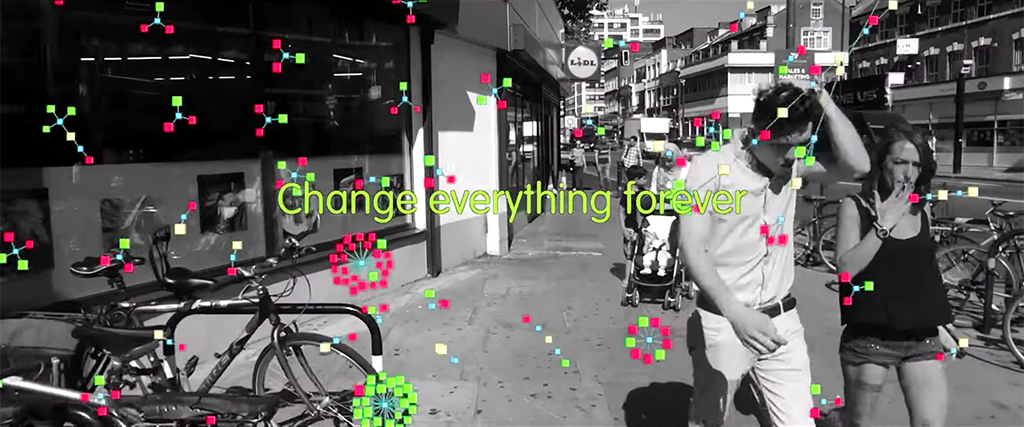
This is a unique collaboration between Furtherfield, dedicated to new forms of cooperation in arts, technology and society and Digital Catapult, an organisation dedicated to growing the UK digital economy.
DOWNLOAD
PRESS RELEASE (.pdf)
TRANSCRIPT (.pdf)
Directed by Pete Gomes
Concept, research and development by Ruth Catlow, Furtherfield, Co-founder and Co-director.
Contributors: Dr Anat Elhalal, Digital Catapult; Ben Vickers, Co-founder unMonastery and Curator of Digital, Serpentine Galleries; Dr Catherine Mulligan, Research Fellow, Associate Director – Centre for Cryptocurrency Research, Imperial College; Elias Haase, Developer, Thinker, Beekeeper, Founder of B9lab; Irra Ariella Khi, Co-founder and CEO Vchain Technology; Jaime Sevilla, developer, researcher, GHAYA , #hackforgood; Jaya Klara Brekke, digital strategy, design, research and curating, Durham University; Kei Kreutler, Independent Researcher, Co-founder unMonastery; Pavlo Tanasyuk, CEO BlockVerify; Rhea Myers, artist, writer, hacker; Sam Davies, Lead Technologist – Creative Programmes, Digital Catapult; Vinay Gupta, resilience guru, Hexayurt
Pixelache Festival 2016, Helsinki, Finland. 22-25 September 2016
BLOCKCHAIN MEETUP, London Digital Catapult Centre, London, UK. 27 October 2016
INAUGURAL BRISBANE BLOCKCHAIN SYMPOSIUM 2016, Brisbane, Australia. 3 November 2016
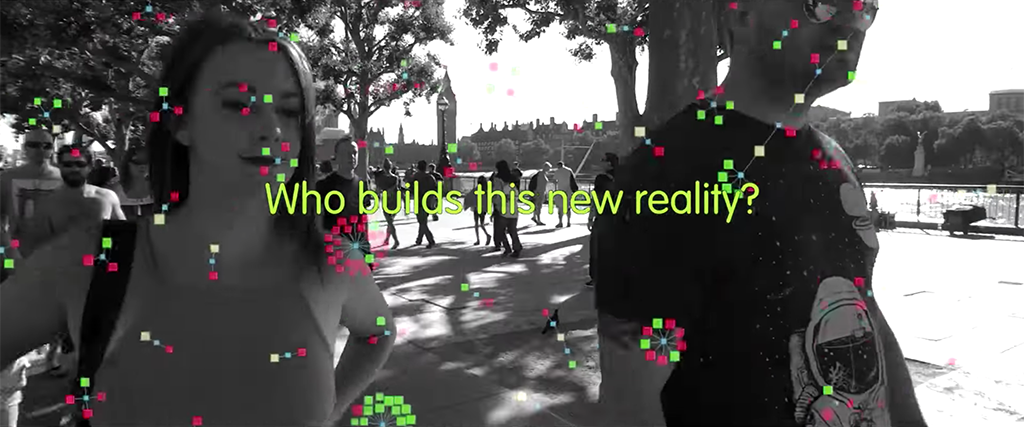
The Blockchain – Change everything forever has been made as part of Furtherfield’s Art Data Money programme which seeks to build a commons for the arts in the network age. A book, Artists Re:Thinking The Blockchain in partnership with itinerant publisher and arts organisation Torque will be published in Spring 2017 with the prequel due out November 2016.
Furtherfield is an international hub for arts, technology and social change. Since 1997, Furtherfield has created online platforms and physical places for exhibitions, labs and debates where different types of people explore today’s important questions. Furtherfield is an Arts Council England ‘National Portfolio’ organisation with a Gallery and Lab in London’s Finsbury Park http://furtherfield.org/
Digital Catapult works with SMEs to help them grow and scale faster. It helps larger corporates in their digital transformation. It does this through programmes of collaboration and open innovation, by bringing academic leading edge expertise into the mix combined with the organisation’s own business and technological expertise. https://digital.catapult.org.uk
For any additional materials and interviews
Please contact Ruth Catlow
ruth.catlow@furtherfield.org
@furtherfield
A Furtherfield film made in collaboration with Digital Catapult, with support from Arts Council England and Southbank Centre.
Blockchain: Change everything forever
What is the Blockchain?
The Blockchain is the underpinning technology for Bitcoin digital currency, and is said to be at the same stage of development as the World Wide Web in the late 1980s. Its promoters claim that the global deployment of smart contracts via this new decentralised protocol will change everything forever.
The Blockchain in Context
In 2008 Bitcoin, the first global digital currency was described in a white paper by the pseudonymous Satoshi Nakamoto. While the WWW facilitated a worldwide (economic and social) revolution in the global distribution of information, the Blockchain, would facilitate secure, decentralised record-keeping, exchange of digital assets and the mining and exchange of computationally secured value.
Since 2013 blockchains have become a focus for investment by world banks, FinTechs and corporations who predict a fourth industrial revolution of super-automation and hyperconnectivity. This is also accompanied by predictions from the World Economic Forum of increased global inequity.
In this version of the future, code replaces legislation. “Code becomes law”. Decentralised Autonomous Organisations (DAOs) route around systems of regulation and taxation via immutable smart contracts, globally deployed across the Blockchain.
The film The Blockchain: Change everything forever proposes that people from diverse disciplines and backgrounds should be involved to work out how Blockchain technologies can be shaped for more decentralised power, diverse needs and interests into the future.
*Jaya Klara Brekke, Digital strategy, design, research and curating, Durham University
At first glance networks and the practice of drawing would seem to be worlds apart. However, the diagram, originally a hand-drawn symbolic form, has long been employed by science as a means of visualising and explaining concepts. Perhaps the most important of these concepts is that of relationships visualised as circles and lines that represent nodes and links or effectively what is related. As such networks, that is groupings of relationships, have come to be visualised through the use of the same styles and iconography employed in diagrams. For artists to reclaim the diagram as a part of their own practice and thereby adopt the practice of visualising networks developed within science sees the practice of creating diagrams in a sense come full circle. Artists have time and time again drawn diagrams and networks that explore relationships. For example: Josef Beuys famously used blackboard diagrams as part of his teaching performances concerning art and politics; Stephen Willats has since the 1960s developed drawn diagrammatic works that explore his socially formed practice; Mark Lombardi drew societies’ networks of power relations throughout the 1990s; Torgeir Husevaag has since the late 1990s drawn diagrams of a number of networks within which he participated while Emma McNally draws diagrammatic networks “bringing different spaces into relation [such as] the virtual world, the networked world and the supposedly real world” (Hayward, 2014).
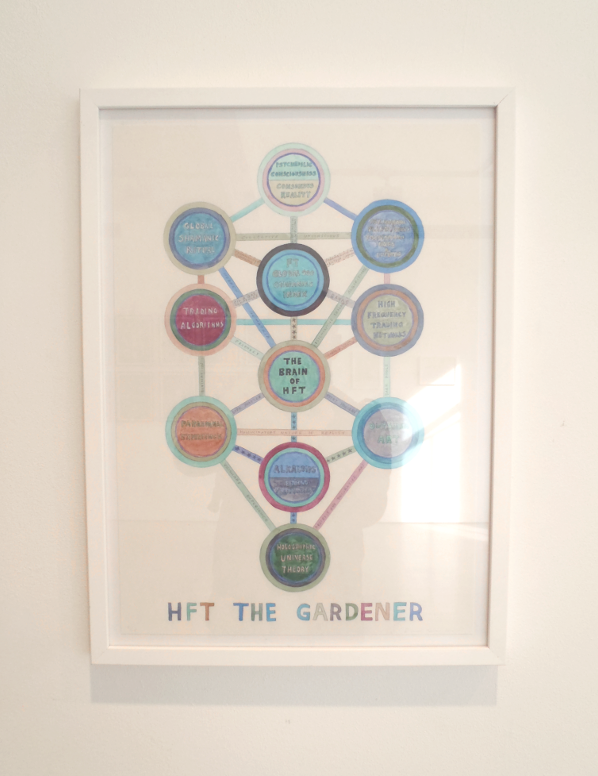
The work of Suzanne Treister resides within this category of artist’s drawing, and in this instance also painting, networks. With a background in painting Treister works across video, the internet, interactive technologies, photography, drawing and watercolour painting (Treister, n.d.). Her work employs “eccentric narratives and unconventional bodies of research to reveal structures that bind power, identity and knowledge” (ibid) within contemporary contexts. As a result of this process of revealing structures, essentially the relationships within the subject matter she addresses and the resulting networks they form, her practice has since the 1990s been closely allied with art that employs or explores technology. She has been repeatedly included in exhibitions and publications that link her work with networks, cybernetics, new media and most recently Post-Internet Art (Flanagan and Booth, 2002; Pickering, 2012; Larsen, 2014; Warde-Aldam, 2014).
HFT the Gardener (2014-15), a recent solo exhibition by Treister at Annely Juda Fine Art in London, is a body of artworks consisting of drawings, paintings, photographs and digital prints supposedly created by a fictional character and a documentary video about the same character. The character, Hillel Fischer Traumberg, is an algorithmic high-frequency trader (HFT) within the London Stock Exchange. After an optically induced semi-hallucinogenic state, Traumberg experiments with psychoactive drugs in order to recreate and further the experience (Treister, 2015). Along the way Traumberg becomes fascinated with botany, experiments with the molecular formulae of drugs as trading algorithms, makes links between the numerological equivalents of plants’ botanical names and the FT Global 500 index, visually documenting all of his research and ultimately becoming an ‘outsider’ artist (ibid). In the process Traumberg transitions from an insider of one network, a trader within the stock exchange, to that of an outsider in another, the contemporary art world.


This juxtaposition of opposites is repeated throughout the exhibition. For example, the drawings and paintings of HFT the Gardener employ illustrations of networks containing nodes and links. These illustrate a number of different sets of relationships that are established by the artist. These include: that of the central character to his concepts, research and environment; the locations where drugs were taken; states of consciousness; the components of an algorithm; different companies within a sector and different aspects of the universe including life and art. Additionally a variety of diagrammatic forms are co-opted in the creation of the drawings and paintings including the Judaic Kabbalah Tree of Life, radial diagrams, flowcharts similar to those used in software design and reference is made to a number of other abstracted forms including star charts, snow crystals, fractals and paisley design. Through both form and subject matter the illustrations of networks and the diagrams gather together combinations of opposites. There is of course the use of what can be considered traditional media to illustrate new media forms, however among others there are also the opposites of painting and software, science and art, corporate and counter-culture, belief and fact, fiction and reality.
To coincide with the creation of the artwork a book of the same name has been published. In the foreword Erik Davis states that there is an “initial shock of Treister’s juxtaposition of esoterica and the financial sector” (2016). The same could be said of the numerous other juxtapositions that occur within HFT the Gardener. However, are Treister’s, or is it Traumberg’s, combinations really contrasts that shock? Treister does more than simply juxtapose opposites. The artist effectively synthesises them into a whole that is indicative of our networked era where individuals routinely select, cut, paste and combine combinations ad-hoc to suit a moment or context. HFT the Gardener is an artwork that could only be created in this era of networks and as such it cannot be considered shocking or out of context with the eclectic recombinatory society that surrounds it.
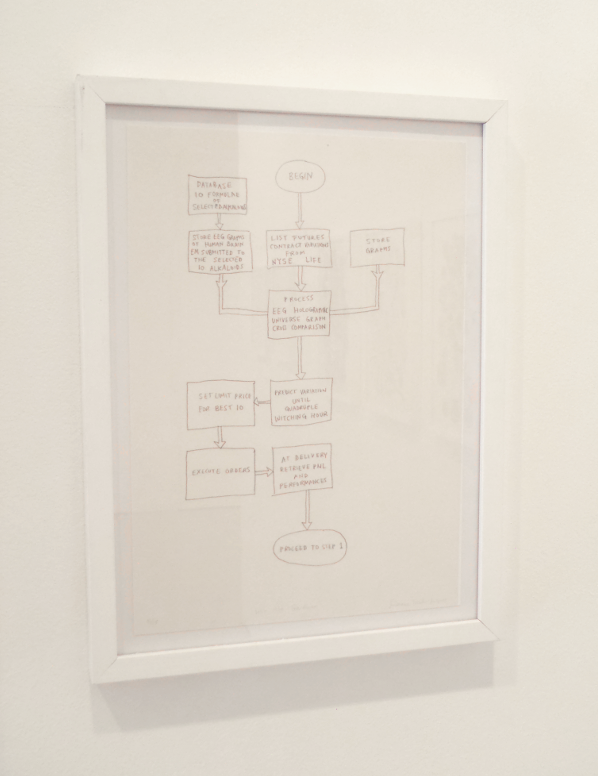
Not only are drawn diagrams and networks employed extensively throughout the exhibition in a number of ways but a network-like structure is also employed to arrange the artworks within the space of the gallery. Initially on entering the gallery space it seems as if artworks are arranged in no particular order. However it gradually becomes clear that this arrangement is purposefully obliging the visitor to enter into and move through the space as if it were a network; that is entering at any point and navigated in any order. While some series of artworks within HFT the Gardener, such as the Botanical prints, maintain an order to illustrate the ranking of companies employed in their creation, the majority of artworks are experienced out of the order they have been created and the documentary video about Traumberg, presumably from Treister’s perspective, is encountered at the midpoint of the exhibition. As such the artworks are presented as if they are interconnected nodes in a network.
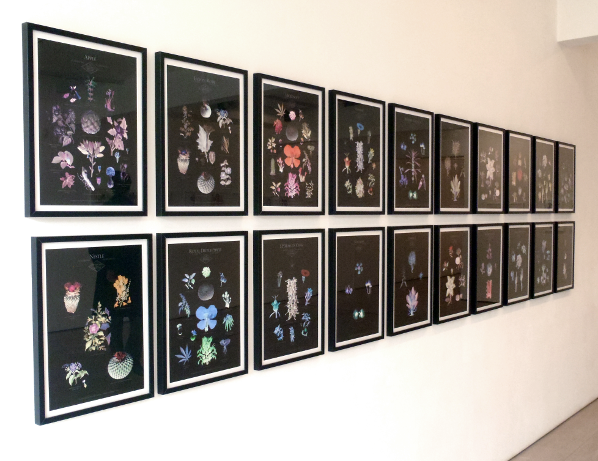
As a result of the diagrams, illustrations of networks, juxtaposed combinations of subject matter and a network-like structure in arranging the artworks within the exhibition Treister successfully manages to make one last combination of opposites, that of non-linearity of experience and linearity of narrative. In doing so the visitor experiences the juxtapositions, combinations and resulting networks formed by Traumberg’s hallucinatory non-linear associations and yet manages to steadily interpret the detailed narrative carefully constructed by the artist. It is in this last combination where the strength of Treister’s exhibition lies as it not only reflects society at large but also suggests that art is and perhaps always has been, a non-linear networked experience that is only now coming into its own.
An exhibition catalogue of HFT The Gardener is available through ISSUU (https://issuu.com/annelyjuda/docs/treister_cat) and a fully illustrated book of the same name is available from Black Dog Publishing, London.
HFT The Gardener will continue to tour throughout 2017 at the following venues. Please see the artist’s website for exhibition updates.
22/10/2016 – 05/03/2017
Selected works from HFT The Gardener exhibited in The World Without Us
Hartware MedienKunstVerein (HMKV),
Dortmund, Germany.
07/01/2017 – 18/02/2017
HFT The Gardener diagrams exhibited in Underlying system is not known
Western Exhibitions, Chicago, USA.
03/02/2017 – 05/03/2017
Selected works from HFT The Gardener exhibited in Alien Ecologies
Transmediale 2017
Haus der Kulturen der Welt, Berlin, Germany.
We are based in the heart of Finsbury Park, which is used by roughly 55,000 people weekly in a neighbourhood described as ‘superdiverse’ for the nearly 200 languages spoken locally. Working with park users and stakeholders, artists, techies, researchers, policy-makers, and other local arts organisations we have developed a new approach to cultural co-creation in this much loved shared public space: ‘Platforming Finsbury Park’.
Our aims are to:
An important part of this work is our 2019-21 programme, Citizen Sci-Fi, designed to engage our local community in creative imaginings of the future of Finsbury Park. We are producing a range of participatory networked art practices that respond to today’s important questions, in this unique urban park context, that empower local participants, and draw on international areas of practice.
By transforming Finsbury Park into a canvas for participatory digital arts we want to explore how insights drawn from the locality, and meaningful co-created cultural experiences can improve wellbeing for people, establishing new arts practices for Finsbury Park and other public spaces and localities.
Read more about this project in our Spring 2018 Editorial
This 3-year programme combines citizen science and citizen journalism by crowdsourcing the imagination of local park users and community groups to create new visions and models of stewardship for public, urban green space. By connecting these with international communities of artists, techies and thinkers we are co-curating labs, workshops, exhibitions and Summer Fairs as a way to grow a new breed of shared culture.
#CitSciFi – crowdsourcing creative and technological visions of our communities and public spaces, together.
The Time Portals exhibition, held at Furtherfield Gallery (and across our online spaces), celebrates the 150th anniversary of the creation of Finsbury Park. As one of London’s first ‘People’s Parks’, designed to give everyone and anyone a space for free movement and thought, we regard it as the perfect location from which to create a mass investigation of radical pasts and futures, circling back to the start as we move forwards.
Each artwork in the exhibition therefore invites audience participation – either in its creation or in the development of a parallel ‘people’s’ work – turning every idea into a portal to countless more imaginings of the past and future of urban green spaces and beyond.
For this Olympic year we will consider the health and wellbeing of humans and machines.
For this year of predicted peak heat rises we will consider how machines can work with nature.
In the second part of this two-part interview series Carleigh Morgan interviews Jussi Parikka about Burak Arikan’s work, discussing the way data and networks condition and construct the way we view and interact with the world. The first part of the series, an interview with Burak Arikan, can be read here.
Burak Arikan is one of Turkey’s leading media artists. Through his practice he maps relations of power and invisible infrastructures using network mapping tools. Arikan’s Graph Commons, an online network mapping tool, is an open platform for the creation of networks that encourages its users to explore the functional limits of network architectures as a mechanism for storytelling, data visualization, and modelling our contemporary moment, from graphing financial microtransactions to mapping superstructures splayed across a continent.
Arikan’s most recent body of work, Data Asymmetry, was hosted at the Winchester School of Art from November 10-24, 2016. The exhibition was curated by new media theorist Jussi Parikka (Professor in Technological Culture & Aesthetics at Winchester School of Art) who comments on the themes, provocations, and challenges that this show invites its audience to consider.
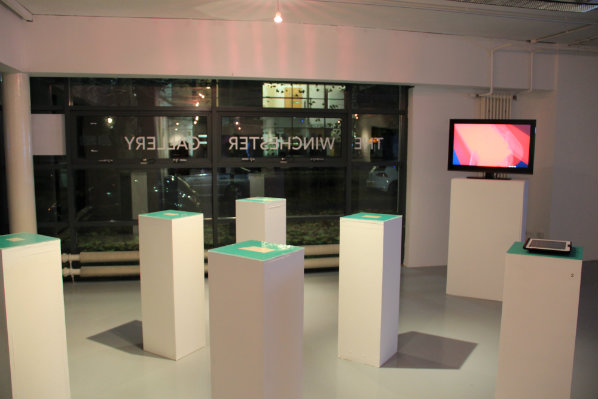
CM: In your essay New Materialism as Media Theory, you conclude: “I propose a multiplicity of materialisms, and the task of new materialism is to address how to think materialisms in a multiplicity in such a methodological way that enables a grounded analysis of contemporary culture. Such methodologies and vocabularies need to be able to talk not only of objects, but also as much about nonsolids and the processual…so we can understand what might be the specificity of this brand of materialism that we encounter (but do not always perceive) in contemporary media culture.”
Are network visualizations like those in Burak Arikan’s art practice—for example, Islam Republic Neoliberalism, which organises data collected about the urban infrastructure—one way to capture the materialism that “we encounter but do not always perceive”? Are networks as a vocabulary sufficient to do this, and are these limitations to Burak’s methodologies that alert us to this kind of multiplicity of materialisms that cannot conform to the network graph?
JP: The network is one form of seeing the world; it gives one form to things we might sense around us as intuitively present even when we are not sure how to express that. The network is not necessarily an end in itself but one particular frame through which to map things – such as urban transformations, architectures as they pertain to our lived experience – and allows you to put yourself on that map. I don’t see networks as an overarching ontology but as a methodological entry to those relations that then scale on other levels too: experiences, narratives, etc. What’s interesting is how Burak’s work plays out this network relationality not only as a visual reality to be looked at, but as a collective form of doing: how to build a network through workshops, or how to express things that we feel crucial to our existence, especially in some of the more politically oriented activist works.
CM: Networking mapping seems to cover a range of modes: cultural epitome, critical methodology, data visualisation tool, a kind mediation narrative etc. Is there a danger to the multiplicities and modalities of representation that networks capture, namely a danger of being misused or misunderstood?
JP: I remember earlier discussions with Benjamin Bratton where we discussed “big data apophenia”: a particular sort of disorder that is conditioned by data: namely, to see relations and to establish them, even if they are not necessarily as real as one can infer from data. The same thing pertains to network methods: you could use it as a pataphysical tool as well to create imaginary worlds of relations, to offer causalities across logical relations, and to create as such a speculative alternative world. Oddly enough, this is exactly something that speaks to the now hot topic of “post truth politics”: how to manipulate and cater data and “information” in ways that becomes effective whether true or not. We are in any case talking of such methods than can be mobilized for multiple uses.
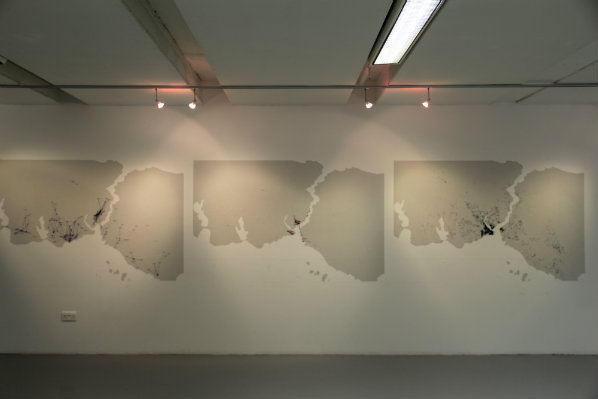
CM: “To produce maps is a method of mapping power, addressing by visual means the asymmetry that defines our situation. Not only asking where we are, but inquiring: where is our data and who owns your data trail? This exhibition maps the shift from information asymmetry to data asymmetry, where aggregation of data is where contemporary power lies.”
Do you see network mapping as inherently emancipatory? Is the need to orient oneself via networking mapping also an exercise in self-reflexive targeting, one that uses modes of surveillance and data capture in an attempt to evade those same modes of capture executed at the level of the corporate-state nexus–is this a contradiction and a risk worth taking in order to achieve an orientation within our own data?
JP: It’s a great point—and demonstrates the paradoxes in this sort of activist work. It’s pretty much a necessity to engage head on and inside such techniques to understand their work: the critical distance often required in institutional or political critique is not really sufficient if we want to understand data culture. We need to be able to work inside such techniques and data, also institutions, in order to be able to shift, transform and manipulate those tools to other ends.
CM: Any other comments on the Furtherfield show and Burak’s body of work?
JP: For us it was a really pleasurable opportunity to bring an internationally known artist’s work to Winchester Gallery, and exhibit work that is at that interesting triangle of activism, contemporary media arts and issues that we discuss in media and network studies. Hence while the exhibition was on in the gallery, we also wanted to expand it into other forms of work that build on our earlier collaborations, like at transmediale where we also had Burak as our guest. We also introduced his work into workshops we organised in Winchester and London. It’s this sort of dynamic exchange that also make his works alive: his practice does not merely look at maps and visual relations of data, but also engages, understands, and uses them.
—
Burak’s visit was part of our AHRC funded project Internet of Cultural Things but also our new research group, or office “AMT”: Archaeologies of Media and Technology.
Burak Arikan’s most recent body of work, Data Asymmetries, was hosted at the Winchester School of Art from November 10-24, 2016. His network mapping tool, Graph Commons, is viewable here.
*Inline image photo credits: Olcay Öztürk
Feature image: Winchester School of Art Exhibition of Data Asymmetries. Image Credit: Olcay Öztürk
Burak Arikan is one of Turkey’s leading media artists, a figure who straddles the lines between technologist and practitioner. He explores relations between data and transactions, the regimes of datafication and identification as control, and maps relations of power and invisible infrastructures with network mapping tools. According to new media theorist Jussi Parikka, Burak’s pieces “raise questions of the predictability of ordinary human behavior with MyPocket(2008); reveal insights into the infrastructure of megacities like Istanbul as a network of mosques, republican monuments and shopping malls (Islam, Republic, Neoliberalism, 2012); remap and organise recurring patterns in the official tourism commercials of governments with Monovacation (2012); explore the growth of networks via visual and kinetic abstraction with Tense (2007-2012); and showcase collective production of network maps from the Graph Commons platform.”
Burak’s creation of the Graph Commons, an online network mapping tool, is an open platform for the creation of networks that encourages its users to explore the functional limits of network architectures as a mechanism for storytelling, data visualization, and modelling our contemporary moment, from graphing financial microtransactions to mapping superstructures splayed across a continent.
Burak Arikan’s most recent body of work, Data Asymmetry, was hosted at the Winchester School of Art from November 10-24, 2016. His network mapping tool, Graph Commons, is viewable here.
In the first of this two part interview series, Carleigh Morgan speaks to Burak Arikan about his practice. In the second part of the series Morgan interviews Jussi Parikka about Arikan’s work and the way data and networks condition and build the way we view and interact within the world.
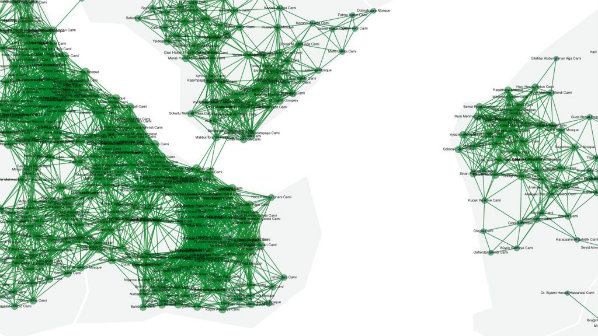
CM: The aim of the Graph Commons is to “empower people and projects through using network mapping, and collectively experiment with mapping as an ongoing practice.” But every visualising methodology has its hermeneutical blindspots and invisible shortcomings.
With those boundary constraints and affordances in mind: What are networks in art, and how are they are extensions of or departures from the networks that they attempt to depict?
BA: I use network as a map vs network as an event separately in my work.
Network as a map is simply using dots and lines to represent observed or measured relationships in order to explore the structures of rather complex systems in life. For example, I am interested in revealing the institutionalization without walls in the world of art, so I look at relationships of artists exhibiting together with other artists, art institutions related by the artists they show, influence of collector-artist relations etc. Such network mapping reveals central actors, indirect connections, organic clusters, structural holes, bridging actors, outliers etc. Network mapping provides a view of such qualities about that particular art world that you wouldn’t see otherwise.
A network map is both a visual and a mathematical language, that you can visually follow dots and lines with your eyes, as well as apply calculations on this data diagram. When you simply record and measure activities as data points, then you can link them to generate more insight and value from the linked whole than the sum of its parts. This is typical data linking method is commonly employed in security, marketing, finance, and social media industries by governments and corporations. One position I have in my art is to use such data mapping and analysis capacity on power relationships, mapping the ones who are mapping us. No need to say, my work is not necessarily about the internet of art things, but I’ve been interested in revealing the relations at scale in variety of fields ranging from juridical systems to cinematic languages.
Network as an event is a living substrate, it is people hanging out together, machines transmitting data packages, neurons firing signals, online platforms for social networking, physical ecosystems of humans and animals where widespread infectious disease can occur. These are physical, digital, hybrid living and multilayered systems maintained by diverse interactions between independent agents, where their small interactions governed by certain protocols together constitute an ever changing larger whole. Building a living network, or network as an event is another line of effort I’ve been pursuing in my work. For example, in 2007 I’ve built Meta-Markets, an experimental online stock market for trading social media profiles, where users did IPO (Initial Public Offering) their profiles and traded with others, with a goal to evaluate the value of a social media profile, the information you cannot get from the service provider company. It ran for 2 years and a community of members formed a dynamic trade network among a couple of thousand social media profiles.
CM: What types of agencies do network maps engender their makers with, and what kinds of constraints to they bring to bear on their creators? As an artist who works with the form of networks, have you witnessed a formal re-alignment of your thinking to reflect these structures? Through ongoing interrogations with and construction of networks as an aesthetic model, would you consider yourself more alert to the networks that condition our contemporary moment?
BA: As with any research, network maps are subjective too. Because by just measuring a reality you claim a subjective position. Thus, data points are always generated, rather than collected. Furthermore, network diagrams are usually totalizing and contemplative. As McKenzie Wark writes criticizing Frederic Jameson’s cognitive mapping: network maps freeze into a contemplative totality that prescribes an ideal form of action that never comes.
My network mapping work starts with raising new questions on critical relations that scale. Then I conduct research to generate data about a “particular world”, which enables many stories, interpretations, and use cases.
As a response to the lack of the “dialectical” in the frozen totality of static diagrams, I started using algorithmic interfaces in my installations. Such interactive network maps let you touch and change the positions of the dots on a map, yet browse the names without losing their relationality to each other as the software simulation continuously organizes the network layout. This way, normally invisible relations not just become visible, but also touchable, which enables us to effectively explore the chain of influences and relationality at scale. Touching the nodes also displays information cards, where you can get richer information about individual data points. By using an algorithmic interface you navigate back and forth between an abstract large picture and concrete juicy details of a complex issue. I think such encounters help the viewer to effectively interrogate the particular issue at hand and develop better insight. This aesthetic and pedagogical experience of interactive cartography is very different from a static diagram, that still lacks criticism.
CM: There’s a resounding common thread in your work [the mapping of the urban infrastructure of Istanbul in terms of its mosques, malls and national monuments in Islam, Republic, Neoliberalism demonstrates this clearly] that seeks to articulate the imbricated matrices of politics, art, and the practices of everyday life that are often not apprehensible to the individual occupied with the attention-consuming projects of being and living.
How does your work position the actor within the network, and what kinds of political commitments do you see expressed from your position as the authoritative designer/person who captures these networks in artistic form?
BA: Since a network map provides a world rather than a story and is thus a nonlinear medium, there is no flow of introduction, development, and finalization, neither a single story. So you start exploring a network map from a “you are here” point, a familiar name or an interesting image, which may be different for every other viewer. Then you do an unplanned journey through a topology of connected information points, navigate from one connection to another. You experience a traversal, a situationist dérive on a data network.
In my workshops and lectures I tell people not to use network mapping against themselves. Network mapping is a powerful tool, it makes structures transparent. Keep the maps about yourself to yourself. Turn it around and map the ones who map you.
In fact, when you click on a follow button, swipe a metrocard, or use your credit card your data is being captured and mapped by data-driven oligarchies. Obviously, this is not just a concern of privacy violation, in this day and age, data capturing is about ownership and control, thus capital and power.
CM: MyPocket generates data from bank transactions, Monovacation from tourism commercials, Islam Republic Neoliberalism organises data collected about the urban infrastructure, Tense Series generates semi-random numbers and uses it as data.
How does your work foreground how data–as algorithmic material that exists at the level of computation, below the thresholds of human apprehension– conditions and structures the world we live in?
BA: Data about us, metadata, make our everyday behaviour more predictable. No one wants to live such a boring predictable life. In MyPocket (2008), by predicting and publishing what I will buy every other day, I demonstrated how easy it is to algorithmically predict our mundane behavior. With this work, in a way I sacrificed myself by making my data no more exclusive to a bank but available to anyone else, so that you can start thinking what corporations can predict about yourself and what it might mean to you.
By turning data around, we can reveal systematic yet invisible power structures. For example in 2012, I mapped a network of Istanbul’s 3000 mosques based on their overlapping call to prayer sounds. Most people living in Istanbul are born into this and take it for granted. However, the mosque network constitutes a subtle power structure, which became quite apparent to many as the government used this network to make calls to city squares in the days following the coup d’etat attempt on July 15th, 2016.
In most of my mapping work, I simply investigate data about one critical relation that connects many agents and constitutes more power as it scales. When completed, a data network is formed and I put that particular world to use.
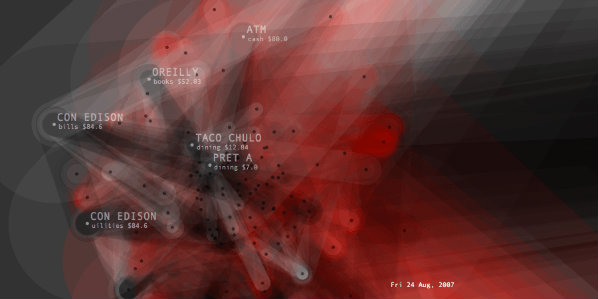
CM: MyPocket discloses your personal financial records to the internet public by exploring essential patterns in your transactions and deploying software to analyse those transactions. The software, which predicts future spending, sometimes determines your future spending choices. Mark B Hansen calls this a “feed-forward” relationship—one where statistical forecasting, future prediction, and probability calculation can code user behaviour “ahead of time,” framing the future-oriented choices of a subject.
What is an example of a consumer choice you’ve exercised that you were directly influenced to make by this software prediction? Did knowing that your personal financial data was being tracked impact your financial management or change your spending behaviors at all?
BA: MyPocket software was able to successfully predict when and where am I going to buy coffee. It predicts ordinary futures. Our lives have such repetitive patterns, which are not so hard to guess right for a supervised algorithm. With MyPocket, I put myself in an experiment of living under excessive forecast about my everyday purchasing behavior. Would I change my habits, would I abide by the predictions, would I care, would I notice, would I ignore? All of these applied at various stages as I lived with this software system for 2 years.
Today, protecting your privacy is akin to quitting smoking or exercising a vegan lifestyle. Changing habits is clearly hard, but once it starts rolling, it causes a big positive change. I believe, in a society of control that monitors, simulates and pre-mediates individual identities in relation to their data trails, behavioural dissidence is superior to reactionary resistance.
CM: You are an artist and technologist. Does one of these identities emerge more frequently in your work? Did your programming skills drive you to explore the aesthetic possibilities of networking mapping? Was there a sequential logic to your artwork as a secondary and subsequent extension of your work in the computational sphere? How do you situate your artistic practice—one that is reliant on a high degree of technological literacy—to the tools of computer technologies?
BA: My art making is a subjective exploration raising questions, whereas my tool making always wants to be objective, tapping an issue with a solution. I practice them in parallel and they feed each other. Making tools helps me examine all kinds of infrastructures closely thus provides lenses for new questions in my artwork. Artistic inquiries help me change my beliefs about the world.
In the first class of an introduction to computer programming course at MIT, students are told that programming is unrelated to computers in a way that geometry is unrelated to geography. Mastering programming takes years. In fact, in my very early work, technology and algorithms had authority on the outcome, whereas later works have been freed from technological capacities.
BA: Do you find that the procedures for mapping with non-digital tools change your artistic strategies and the types of networks you produce? In a similar vein, is the medium of Graph Commons as a digital interface important to the co-collaborative possibilities that this online platform enables? Would you describe the network mapping that Graph Commons enables as an act that is inherently political, or aligned with activist models of representation?
BA: I always start modeling an idea by sketching on a paper, by discussing with people, by taking notes here and there. It is often a contemplative process that I don’t find possible in a digital tool. As the idea gets mature, the amount of related material might not be manageable on paper – then I start organizing it using digital tools, write some code to scale it and observe its extents.
Obviously, digital tools on the Internet are best for asynchronous communication. The Graph Commons data mapping and publishing platform is great for internet-scale data mapping collaborations. Network mapping particularly is a powerful tool, it makes things more transparent. So activists, journalists, researchers, and civil society organizations around the world use it to untangle complex relations that impact them and their communities.
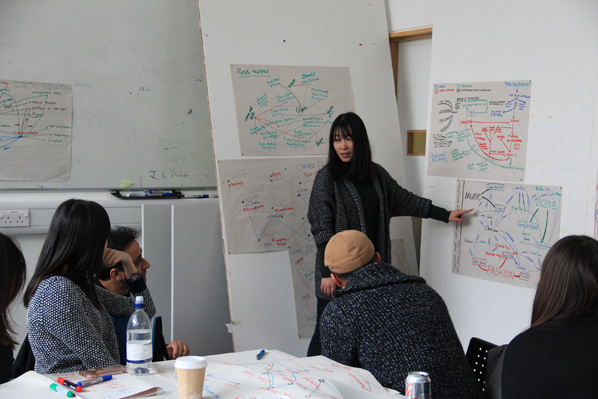
CM: Do you see networks as maps? Monovacation seems to deploy features of both in its networked parody of the commodity forms and repeated images that characterize the tourism commercial as a typology. What are some key distinctions that might separate these two forms from one another in their attempts to frame, visualize, and enclose data?
BA: As I mentioned earlier, I use network as a map vs network as an event separately in my work.
Monovacation introduced network traversal as a method to deconstruct and explore movies as databases. The official tourism commercials of countries in competition with each other have been selected and each film has been divided into the possible tiniest clips. The 3-4 second long clips have been coded with tags. Tags with shared clips are connected to each other (weighted with number of clips) on a network diagram, which runs as a self-organizing software simulation. A new movie has been algorithmically generated through a traversal on this network map, a program navigating from one node to another, following the weighted path among the tags. Seashores from Egypt to Portugal, women from Israel to India, mythological figures from Thailand to Turkey formed an extracted fantasy of “vacation”.
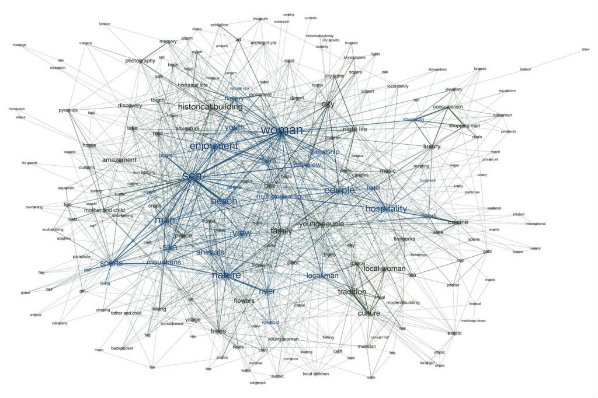
CM: The Graph Commons platform contains an additional axis that static graphics do not: time. How does working within digital media open up new models for orienting the user within data collections, particularly where the ability to represent change-over-time is at play?
BA: Networks are inherently dynamic, undergoing constant changes, both within the composition of nodes, and in the relations between nodes. To help you understand how the network changes and behaves over time, Graph Commons provides a timeline interface. It animates your network map as nodes leave and enter the network and the map expands or contracts in time. The network shape, radius, density, intensity, and emergence of clusters, central and peripheral actors all become observable and comparable using the timeline feature.
CM: Networks are the predominant and paradigmatic episteme of the information age. What kinds of relationalities, phenomena, data collections, or texts do they fail to capture? In other words:
a. What the network is NOT suited to do/perform
b. On speculating through an accelerated lens, what will the predominant formal and organisational structure of the next century look like? Will networks continue to play a role, or will they be completely surpassed by new organisational and structural logics?
BA: Bare network mapping may not be sufficient in studying multilayered diverse network dynamics where actors (nodes) and relations (edges) is not clearly distinguishable from one another as in swarms of species or molecular activity. Moreover, at the heart of capturing data lies the question of measurability. If something analogue can be measured it becomes digital, then it can be linked to other data points and become a subject of a network analysis. I think in this day and age, even emotions, intentions, and desires could be measured to a degree, if not socially reproduced.
In a world where every atom can be addressable with an IP address (IP6), discussion of the possibility of capturing analogue things is increasingly less relevant. What becomes critical is the question of who captures and controls what data owned by whom. Do you own a self-driving car’s data captured from your neighbourhood? Are you in control of your data captured by the network medicine? Are you paid rent for the use of data that belongs to you? Data oligarchies will only continue to grow, and this situation of data dispossession will increasingly constitute what I call data asymmetry for many years to come, until we move from connectivity to collectivity, build purposeful exploitation-free autonomous zones, and reroute our life activities in solidarity.
Regarding the future of organizational structures as imagined to be constituted by cryptocurrencies, something clear from today is that decentralization is not necessarily democratic. It should be deliberately discussed that ones who design the protocols have power and network effects can generate inequality. A blind belief in decentralization would not be so different than a belief in free market ideology. When Poland, Chile, and Turkey opened their markets to the world in the 80s, globally networked corporations penetrated into these markets completely within the laws and yet left the small locally connected actors stagnant, this is one example how network effects could generate inequality.
Featured image: Image from When Drones Fall From the Sky, by Craig Whitlock, Washington Post. [link]
At 0213 ZULU on the 2 March 2013, a Predator drone, tail number 04-3133, impacted the ground 7 nautical miles southwest of Kandahar Air Base, Afghanistan, and was destroyed with a loss valued at $4,688,557.[1]
On the 27th March 2007, a crashed spy plane was discovered by Yemeni military officials in the southern province of Hadramaut, along the country’s Arabian Sea coastline. The following day, Yemen’s state media identified the plane as being of Iranian origin, and that it was yet another example of an Iranian provocation at a time of high diplomatic tensions between the two countries. It was three years later, upon Wikileaks’ release of the so-called Cablegate archive, that a US Embassy cable revealed the “Iranian spy plane” was in fact a “Scan Eagle” drone. The drone was remotely piloted from the US Navy’s USS Ashland which was patrolling the Arabian Sea as part of an international counterterror task force. The United States Military was not “officially” conducting military operations in Yemeni territory at the time, and had not sought permission to conduct operations in the country’s airspace.
The discovery of the crashed drone could have posed a difficult political problem for the US to solve. However, in the cable, the official makes it clear that Yemen’s President Saleh had been keen to reach an agreeable deal with the Americans and apportion blame on a convenient third party — Iran. The cable states:
“He could have taken the opportunity to score political points by appearing tough in public against the United States, but chose instead to blame Iran. No doubt focused on the unrest in Saada and our support for the transfer of excess armored personnel carriers from neighboring countries (reftel), Saleh decided he would benefit more from painting Iran as the bad guy in this case.” [2]
By 2007, aside from occasional reporting in the media and among some activist circles, there was little public awareness of the US drone program. In fact, the program was not officially acknowledged on-the-record by a US government official until 2012. This official was John O. Brennan, then Counterterror Advisor to Barack Obama, and the momentous occasion was a speech at Washington DC’s Wilson Centre—a “key non-partisan policy forum for tackling global issues through independent research and open dialogue”.[3] Brennan states:
“So let me say it as simply as I can. Yes, in full accordance with the law—and in order to prevent terrorist attacks on the United States and to save American lives—the United States Government conducts targeted strikes against specific al-Qa’ida terrorists, sometimes using remotely piloted aircraft, often referred to publicly as drones.”[4]
While the use of unmanned aircraft in warfare goes back to the early 20th Century[5], the distinctive image of the drone has come to characterise the ambiguous geopolitics of The Global War on Terror. Their hubristic names—Reapers, Predators — evoke visions of carnivorous animals carefully and selectively stalking their prey. With their stealth and capacity to observe targets for hours on end before striking, the drone selectively adopts the tactics of the insurgency: it is an emergent weapon directed onto an emergent threat. Drones, like their intended targets, are not necessarily contained by borderlines, or to territories on which the US has declared war. They are in a suspended state of exception, and are decried both as being outright illegal by experts in international law, and simultaneously, as Brennan contests, strictly adherent to the doctrine of Just War.

In Brennan’s Wilson Centre speech, he draws on medical analogies to justify the “wisdom” of drone warfare, emphasising its “surgical precision—the ability, with laser-like focus, to eliminate the cancerous tumor called an al-Qa’ida terrorist while limiting damage to the tissue around it—that makes this counterterrorism tool so essential.”[6] But are drones as precise as Brennan’s rhetoric implies? Drones are often said to be heard, and not seen—their whirring noise inspiring local derisive colloquialisms[7]. But it is especially in the drone crash that the drone can be seen, and what’s more, subjected to inspection. It alerts us to a vital consideration: the failure of so-called precision military technology.

In IOCOSE‘s Drone Memorial, our attention is drawn to the fact that these complex systems are precarious, that the drone is indeed a fallible technology. The memorial, a sculpture of a fallen Predator drone driven into a copper plinth like a blade, subverts the surgical metaphor proposed by John O. Brennan. The drone’s mirrored surfaces create a fractured, tesselated reflection of its surroundings, its form almost vanishing in a specular camouflage. Inscribed on its wings are the memorial’s “fallen comrades”, the hundreds of other drones that have crashed, listed by location and date. This list can only be considered a selection, however, such is the secrecy around the use of drones in the War on Terror. As such, it should also be considered a monument to the journalists who manage to report on the discrete events of drone warfare in incredibly challenging circumstances.
A GPS beacon embedded in Drone Memorial broadcasts the location of the sculpture on the project website, hinting to us that this seemingly trivial technology in our smartphones has more nefarious uses. Global Positioning Systems have their roots in Cold War ballistics research, specifically in a program by DARPA codenamed TRANSIT, developed to direct the US Navy submarine missiles to “within tens of meters of a target”[8]. Today, GPS is one of many components in the assemblage of technologies used in the drone, and a key enabler of its apparent “precision”. Nevertheless, GPS can of course fail—it can be “jammed” inadvertently, or indeed tactically manipulated by malicious third parties. When the satellite link is lost with a drone, the aircraft goes into a holding pattern, flying autonomously until control is regained. In the Washington Post‘s story “When Drones Fall From the Sky”, they note that in order to keep its weight at a minimum there is little redundancy built into the drone’s on-board systems. Without backup power supplies, transponders and GPS links fail, and in several cases “drones simply disappeared and were never found.”[9]

IOCOSE’s positioning of the memorial as existing in a hypothetical, post-war scenario poses some interesting questions, but this temporal dissociation is perhaps unnecessary, for this is an issue very much of the present. It is certainly a topic more than worthy of critical investigation—the spectacle and the political consequences of failure have largely been left out of typical artistic engagement with drone warfare. In their press release accompanying the work[10], the artists suggest that the sculpture has an absurd quality. To me, it is not absurd as much as it works as an apt memorial to the violence of failure. In reading the long list of drone crash locations, the viewer might begin to probe the question of what information should be open to public scrutiny. IOCOSE pose the following question to us: “Does a drone crash count as a technological failure, or as a casualty?” This question would appear to have a clear answer: we must see the drone crash as a technological failure, so as not to make a false equivalence with the real casualties of drone warfare—the civilians who are subjected to it, the very same people who might also counter Brennan’s claims that the drone is a surgical, precise weapon of war.
Drone Memorial is the third work in a series titled In Times of Peace. This most recent work is the most astute in challenging the legally and ethically disruptive paradigm of drone warfare: it pierces the reflective rhetoric of US defense officials, and directs our attention to the high-stakes violence of its technological failure. The memorial, of course, ordinarily comes after the historical moment. This ‘moment’ is very much still unfolding 15 years later, and as the Trump administration takes form, it seems that the way in which drones will be deployed in the future is an ‘unknown unknown’. Thus, Drone Memorial is a temporal snapshot, an aesthetic pause on an ongoing, mutable war that seems to operate on a parallel continuum, only occasionally visible. More drones will continue to fail, as the drone war inevitably continues. These failures present a moment for critical analysis, a flash of visibility that should be seized upon.
The Road to Budgetary Blockchain Bliss, is a 2 hour Live Action Role Play adventure for the Blockchain-curious of all tribes including: hackers, lawyers, activists, artists, financiers, designers, venture capitalists, developers, marketeers.
Players adopt a fictional future version of themselves and work with others to solve a real-world problem. They learn about and build DAOs and Dapps (machine-based organisations and apps on the blockchain) and act out the social discomforts, asymmetries, dramas and politics of collaboration and coalition-formation across difference….starting with the budget!
NO PRIOR BLOCKCHAIN KNOWLEDGE NECESSARY
Fill out the application survey to ensure that you are assigned a compatible player character and so increase your chances of achieving your objective – fictionalise at will.
The Road to Budgetary Blockchain Bliss
Devised by Ruth Catlow, Furtherfield and Ben Vickers, unMonastery & Serpentine Galleries
WHEN?: Prompt start – 13:45 – 15:40 on Friday 2 Dec 2016
WHERE? The Presentation Room
As part of MoneyLab #3 Failing Better Symposium | Workshops | Exhibition,
Pakhuis de Zwijger, Amsterdam A two-day symposium,
1 – 2 December 2016, featuring talks, workshops and performances that confront the notion that finance is too big to fail.
Tickets: € 10 per session; € 30 per day, € 60 two day pass Students: 50% discount on all tickets

Featured image: Pandora’s Dropbox by Matt Bower
The Disruption Network Lab (DNL) has been presenting in Berlin some of the finest platforms for the discussion of art, hacktivism and disruption, presenting academic debates on not-so-conventional forms of thought. In their event IGNORANCE: The Power of Non-Knowledge, the second in the series Art and Evidence, various scientists and researchers discussed ignorance, not merely as a subaltern issue but as a central tool in knowledge production.
In previous events, DNL debated how ignorance is deployed as a mechanism of truth and power negotiation, mainly through the omission of the known by the means of secrecy, obfuscation and military classification. There are many forms of understanding ignorance, and this program intended to elucidate the potentialities and pitfalls within the concept. According to DNL, the first step towards approaching ignorance is to recognise it and become aware of it. As co-curator of DNL Daniela Silvestrin said (despite the paradox) that it is necessary to render the “unknown unknown into a known unknown.” The field of ignorance studies investigates the spread of ignorance, what kind of forms it takes depending on the context, how science “converts” it into probabilistic calculations of risk, and even how it can be used to push certain political, economical or religious agendas.

In the opening keynote, Matthias Gross, a sociologist and science studies scholar who has written extensively on ignorance studies, co-editing with Linsey McGoey the “Handbook of Ignorance Studies,” starts by stating that “new knowledge always creates new ignorance” and that throughout history humans have been in constant relation – acceptance, denial, resignation – with the unknown. Gross has covered how ignorance operates in different scientific milieus, namely, how risk is widely used in natural sciences as an attempt to project an idea of the future, as demonstrated in weather forecasting, but also how not knowing operates in everyday life; through secrets, the spread of false knowledge, feigning ignorance, or even through actively not wanting to know.
Gross presented a compelling body of research, exposing numerous examples in which ignorance serves the purpose as a tool to acknowledge what we don’t know in science (important in fields such as Epidemiology) or how positions of power use ignorance to manipulate public opinion within our social structures. However, the debate felt somehow stranded in an optimistic loop, where ignorance was seen mostly as a catalyst to search for further knowledge. Yet, I believe, while duelling with the binary knowledge vs ignorance, one should never forget to tackle the universalistic shape that ‘knowledge’ tends to adopt. In the end, the discussion felt insufficient, failing to examine knowledge/ ignorance from a non-hegemonic perspective when it would have been interesting to borrow criticism from postcolonial or feminist thought.
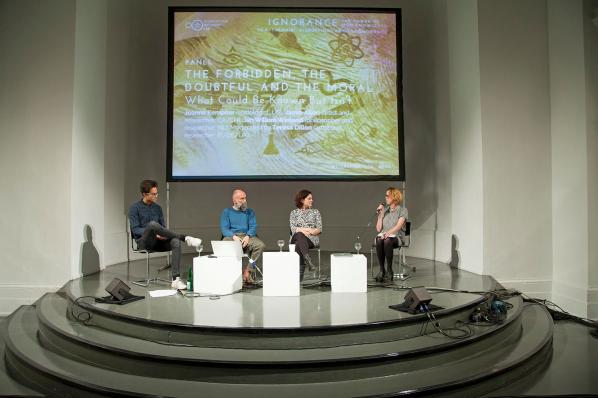
The first panel, moderated by Teresa Dillon, was deemed to shake the consensus in the room by joining the moralistic perspectives in science, the forbidden and undesired, the paranormal and the apocryphal together. Sociologist Joanna Kempner presented astonishing research focused on ‘negative knowledge,’ described as taboo, dangerous or threatening to the status quo. In an attempt to demystify the neutrality of knowledge production in sciences, Kempner interviewed various scientists to discover forbidden areas in their fields. The outcome of this research revealed that due to a fear of loss of funding and/ or sullying their reputation, scientists restrain themselves from researching illegitimate topics. For example, in Psychology one is expected not to study extra-sensory/ paranormal senses as these studies are usually associated to parasciences, a term that is in itself revealing of the hierarchies of knowledge. Kempner also exemplified how knowledge production is pressured by political interests and recalled the research-bans during the G.W.Bush government that cut funds to research related to sex and drugs under the assumption that remaining ignorant about any possible positive aspects (of recreational drug consumption) guarantees the maintenance of conservative moral values.
On the maintenance of moral values, the philosopher Jan Wieland presented an interesting experiment: “What would you do if you wouldn’t know? And what would you do if you’d know?” Giving the example of a social experiment by Fashion Revolution, a movement that calls for “greater transparency in the fashion industry”, Wieland examined consumers’ choices as they acknowledged the conditions in which clothing is actually produced. The project invokes a sentimental story with an excerpt from the daily life of a young girl living in Dhaka, Bangladesh, who works in a garment factory. Coming to terms with the girl’s story, the reactions differed — from not buying and empathically connecting with her situation to total indifference and still buying. Wieland attempts to analytically evaluate their intentions, good or bad, and how ignorance affects choices, stating that some of us might willfully remain ignorant (willful ignorance) as a way to better cope with our habits of consumption. However, I find it difficult to extrapolate these findings to a moralistic and individualistic criticism of people’s consumerist choices, since we know there is a structure that keeps consumers far from well-informed. A good example of how economy capitalises on ignorance, we know that the international division of labour is intentionally built to alienate the consumers from the “dirty” phases of production.

Jamie Allen, artist and researcher, also analyses at the economy of non-knowledge that is in the genesis of apocryphal technologies. “Do pedestrian’s crossroads’ buttons actually work?” We have all thought about this, yet has it stopped us from pressing the buttons? As long as we do not know whether a certain technology actually works, it “works”. Such an economy is boosted by acknowledging that some things remain as common ignorance. If we are not sure whether a lie detector works or not, then it can be used to incriminate — amidst ignorance, it shall produce the truth.

Informative and somewhat frightening, “Merchants of Doubt”, directed by Robert Kenner (2014), reveals how bendable ‘truth’ is in the interests of big corporations. The documentary investigates how the tobacco industry spread false information among firefighters, leading the world to believe that the domestic fires caused by cigarettes were the fault of the furniture rather than the cigarettes. This is where it goes from uncannily funny to scary. While interviewing scientists, whistleblowers and activists, the film unveils the dreadful story of corporate campaigns designed to unleash confusion and scientific scepticism among the masses, putting the life and security of millions at stake. This scepticism is not passive, thus it turns into a cynical endeavour. As corporations claim that there is no consensus surrounding issues such as global warming, conferences and books are forged to sustain their statement, while scientists who defend the existence of greenhouse gases are accused of ceding to their political biases in order to get funding for their research. What about facts? They seem to become irrelevant in the face of expensive lies.
Watch Merchants of Doubt’s trailer here.

Karen Douglas, a social psychologist, presented an empirical study of conspiracy theories whilst trying to trace a particular psychological profile of those more prone to elaborate and believe in them. Douglas used widely known conspiracy theories as examples, such as the infamous car crash that killed Princess Diana (which became a true “Schrödinger’s cat” case, instigated by the media-produced hyperreality in which Diana was both alive and dead — along with Elvis Presley) and the theory that 9/11 was orchestrated by the United States government to instigate and justify the “war on terror”. Douglas believes we are naturally hardwired to believe in conspiracy theories and sees them as a way to cope with things we are unable to answer. A socio-analytical view on conspiracy theories also seems to fail the complexity of forces that make us consider why certain theories are conspiracies and other perspectives are just theories. The issue with Douglas’ approach lies within its socio-psychological analysis, which tries to find a pathological pattern in people who believe in conspiracy theories, such as describing these people as being intentionally biased, or stating that those who tend to perceive patterns in things or believe in more than one conspiracy theory all show the “symptoms” of a conspiracy theorist. Yet, as pointed out by a member of the audience, this approach seems to lack a sensibility to the entire concept of “conspiracy theory” as a political tool to dismiss and undermine other narratives, such as narratives from an undesired other (e.g. how Russia’s government agenda is seen by the USA). Nevertheless, it is interesting to understand how these bodies of “disbelief”, should you wish to call them conspiracy theories or not, have a huge impact on our lives and inevitably our deaths (e.g. global warming, vaccination). As with apocryphal technologies, certain forms of unknown seem to crystallise as forms of knowledge – we know that we do not know and that is the way it is.
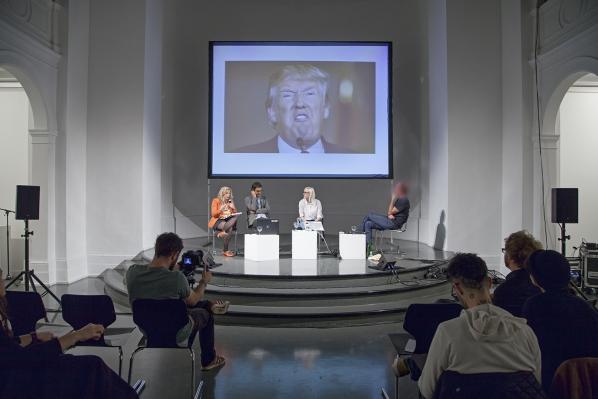
The closing panel, moderated by Tatiana Bazzichelli, has overseen our entanglement on social media and its algorithms, promising to be oracles of truth while their complex structures grow beyond our understanding. Ippolita, a group of activists and writers, warned how social media promotes emotional pornography, where our feelings are exploited by click baits in exchange for our personal data. By establishing clear metrics of interaction, like the number of likes and comments, social media creates an addictive game of forged interactivity, while we are scrutinised by biometric evaluation resultant from the same data we produce. Also analysing the manipulation of data and its weight in political agendas, Hannah Parkison, a journalist focused on digital culture, analysed Trump’s run for presidency propaganda in digital media. By using mostly social networks, such as Facebook and Twitter, Trump has kept control of his narrative without entering into risky interviews broadcast on TV. This is an effective way to get away with lies, regardless of the constant warnings from fact checkers – according to Politict 78% of what Trump said on the run for the election is not factually true. These lies spread across the internet, rendering their own truth.
Vladan Joler, chair of New Media Department at the University of Novi Sad, presented his project in which he tries to map the tentacular structure of the Facebook algorithm, an expansive database incorporating individuals’ personal information that implies the fabrication of assumptions about potential consumers’ habits, wants and needs. Facebook was thus framed as an immaterial factory of information, the functioning of its assembly line still unknown, constantly mutating and growing. A speculative visual image of Facebook’s processes was rendered as Vladan tried to map something unknown; this mapping has similarities to the work of early cartographers. And much like early anthropological stances, the nodes of information produced have the potential to define thoughts and discussions about what we are and how we are supposed to behave. As Vladan ironically concluded, these are the tools used by the cybernet dominators – the digital monarchies that will accentuate asymmetries.
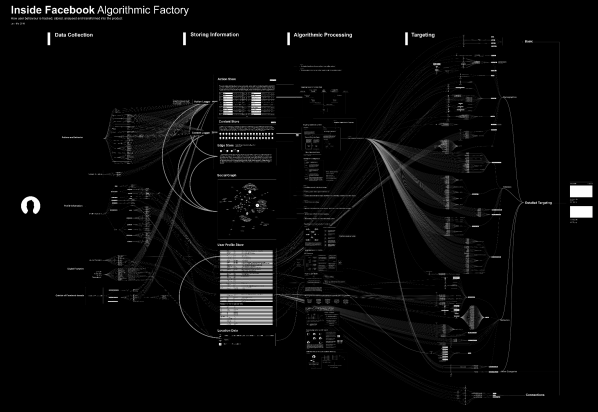
Ideas such as ‘knowledge’ find resistance and defiance from other epistemes that fall out from the western-centric productions of knowledge, such as the Amerindian ‘perspectivism’ defended by Viveiros de Castro or even the Alien phenomenologies (see Ian Bogost) that instigate the thought of non-anthropocentric ontologies. Bearing those in mind, I found that talking about the ‘dark’ side of knowledge is an invitation to dismantle and boycott its mechanisms of production, sustained in frail ideas of “truth”, “reality”, or “science”. In addition to the initial concept of ignorance, the conference provided a fertile ground for questioning the multiple ways in which humans deal with intangible phenomena, try to bypass obscurity and profit from that same obscurity. It provided insight on the relevance of knowledge to map and create reality, while bodies of power render webs of mystification of the tangible – corporations forging lies, politics of manipulation, cultural colonisation – reproducing ad nauseam epistemic violence.
The third edition of the Art and Evidence series from Disruption Network Lab, which took place on the 25th and 26th of November, wrapped up with the event TRUTH-TELLERS: The Impact of Speaking Out. TRUTH-TELLERS asks a question that could not be more crucial at the moment: “Can we trust the sources and can the sources trust us?” We have recently experienced a presidential battle between Clinton and Trump in which one of the most divisive topics were the thousands of emails sent to and from Hillary Clinton’s private email server while she was Secretary of State. A battle from which Trump left victorious despite having failed almost every fact-checking test. While Assange is forbidden to use the Internet for fear of him interfering with the presidential run in the USA, Chelsea Manning remains convicted, sentenced to 35 years of imprisonment due to her 2013 accusations of violating the Espionage Act. DNL gathered hacktivists, privacy advocates, investigative journalists, artists and researchers to “reflect on the consequences of leaking and whistleblowing from a political, cultural and technological perspective”. Unfortunately, due to a lack of funding, this could have been the very last DNL event. Let’s hope not, as these are vital, particularly in times of political despair.
Feature image: Still from Dreams Rewired: original source Das Auge der Welt (Germany 1935); dir: C. Hartmann
Dreams Rewired / Mobilisierung der Träume – Trailer from Amour Fou on Vimeo.
The 2015 film Dreams Rewired, recently shown at the Watermans Digital Weekender in London on 12-13 November, will be screened again at Watermans on 3 December. Directed by Manu Luksch, Martin Reinhardt and Thomas Tode, the film has the tagline ‘Every age thinks it’s the modern age’. It looks back to the early 20th Century, to the development and implementation (first locally, then globally) of the telephone, the radio and television.
The makers of Dreams Rewired unearthed and arranged early film recordings and brought them into the 21st century context. This was done via a playful narrative written by Manu Luksch and Mukul Patel and read by Tilda Swinton. The tagline was well chosen; almost everything Swinton says would have been relevant at almost any point within the last century. Time periods, machineries and political movements are connected in clever and unexpected ways, meaning that Dreams Rewired, a durational video whose narrative follows a recognisable storytelling structure, makes numerous links between times, places and people, which branch off from the safety of its linear structure.
Dreams Rewired is something of a treasure trove, not only for the glimpses its found-footage building-blocks gives into a past era but also because of the inter-generational, inter-national, inter-thematic connections it makes. Frequently while watching the film I felt the urge to burrow into an investigation of one of the clips, stories or introduced contexts. To emulate this ‘tip of the iceberg’ effect, this review will pull words directly from the film, linking quotations to some of the themes which appear and reappear throughout.
“A new electric intimacy”
With new media come new practices of communication. One of the recurring themes described in Dreams Rewired is the coupling of intimacy and invasion of privacy introduced to society along with a new communication method. Just as a new invention is prototyped, its social implementation causes new prototypical behaviours – new ways of caring, new ways of injuring, new comings-together, new separations. Uncertainty is inherent to experimentation.
“The waves travel at the speed of light, defining what simultaneous means. Information can travel no faster.”
When something is newly possible it also newly achievable – new precedents are set and new avenues opened for exploration. There is a flurry of activity, a rapid diversification. For those looking to gain or retain power over others, this is a problem; diversity requires more effort to manage. Initial flurries of activity are curtailed by the introduction of rules, the setting of precedents.
This limitation sets new targets to meet, new challenges to overcome. The cycle starts again as those in power look for ways to consolidate it while those without look to gain what they can. This is a simplistic, but not inaccurate, description of the machinery of the capitalist world.
This cycle of diversification and restriction is always coupled with the establishment and transcendence of thresholds. Experimentation with a new technology reveals some of its limits. (Side note – of course, what is understood as a limit is defined by wider cultural contexts.) “Information can travel no faster” is a provocation to speed up.
“Geography is history”
New advances cause conceptual shifts. Early telephony and television shrunk the gap in time between a thought or plan and its activation. Understandings of time and geography changed, and it became possible to move into new spaces and in new ways at socially impressive speeds. New powers, in short, were available to those who knew how to access them, to those who understood the preceding context well.
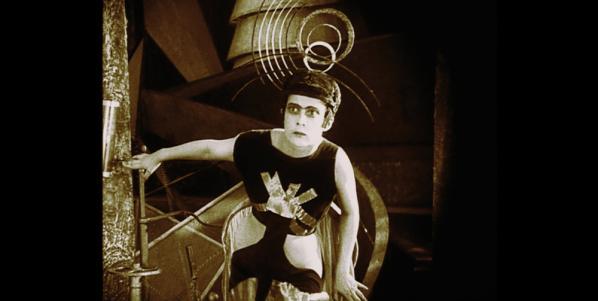
“A model of the new human is put into circulation”
A network grows, its complexity and partner processes intensifying. The machinery of daily life is altered, and daily life is a testing ground. Social interactions change as the new set of behaviours required to work the new machinery collide with existing social norms and rituals. New jobs and new workplace structures appear and people previously without responsibility or power find themselves in contact with it (though they may not understand the possibilities at first). People are no longer the same beings as before. Cycles of experimentation and consolidation reach into the body.
“Someone will have to lift us up. But who will lift them up?”
The flurry of excitement surrounding a new invention is based on the idea that ‘our’ lives will be improved, that ‘we’ will be able to do, see, have more. There is a problem here. The words ‘we’ and ‘us’ are too abstract – they bracket whoever the speaker wants them to bracket and recapitulate the prejudices they have. Anyone who is not included as part of the ‘we’ simply does not exist. This is convenient for the ‘us’ – while ‘we’ rush excitedly towards a future in which we have more and better, what ‘they’ do is of little concern. The ‘us’ does not care – or even think much – about the ‘them’. The ‘us’ cannot understand why the ‘them’ has not joined the ‘us’. After all, the ‘us’ is at a new threshold – who would not want to reach the other side?
“Personal profiles, passwords, biometrics..fully documented. Every trace filed. Bigger data, better analytics. Opt out, and we lose our place in the world. So…we share the keys to our desire, our habits, to ourselves.”
To be part of the ‘us’ and the ‘we’ requires effort. To ‘opt in’ requires sacrifice. At the same time, ‘opting in’ is the easiest thing in the world when ‘opting out’ means facing a void. Advice on how to do well, how to achieve, how to be healthy is easy to come by, but there is little guidance for those who find themselves, or wish themselves, outside the mainframe. Losing one’s place in the world means losing access to that mainframe and the stability that comes with a highly legible structure. Today the legible structure is far-reaching and well established, to the extent that opting out is dealt with violently. The new models of human coming into circulation have trouble recognising the old. There is a mutual rejection.

“Government regulation stifles amateur culture – military and commercial interests occupy most of the spectrum … transmission becomes a privilege, not a right”
As I wrote earlier, the ‘us’ and ‘them’ structure is too simple. It would be more accurate to think of people as communicating on multiple frequencies. The machinery of society is complicated to say the least, and made more so by the mainframe, which amplifies transmissions at some frequencies while restricting others. In the early 20th Century, multiple obscure radio channels were repressed, responsibility placed with public backlash following rumours that amateur radio was responsible for the sinking of the Titanic. Side questions: where did the rumours come from? What were they based on? How was the public response measured?
“For the first time he hears himself as others do. A voice absolutely familiar but estranged…But her power also grows: by controlling his voice she controls her time”
There is a strange relationship between the controller and the controlled. For every CEO there is a team whose own agenda seeps into the workings of the company. Dislocated power and fragmented or unplaceable identity are some of the symptoms of a complex system undergoing change. When a system is so complex as to involve multiple timescales, spaces, materials and structures, it is impossible to predict the future.
—
Dreams Rewired is part of the Technology is Not Neutral Symposium
3 December 2016
Watermans, London
https://www.watermans.org.uk/events/technology-is-not-neutral-symposium/
Two years after his death, Harun Farocki continues to maintain an archetypal role in the world of the visual arts. Many mourned for the loss of a gifted artist who was as not just a filmmaker but a critic, activist and philosopher en masse. Farocki succeeded his German New Wave filmic predecessors as his work would seamlessly and at once command hilarity, disparagement and intellect. A project-retrospective collaboration of his work was undertaken, just two years after his death, with its first part at The Institut Valencià d’Art Modern (IVAM) named ‘What is at Stake’, and more recently the second-part titled ‘Empathy’at the Fundació Antoni Tàpies compiled of at least 8 works focusing on an analysis of labour within the framework of capitalist demands.
The title of the exhibition, ‘Empathy’ originates from Ancient Greek; ‘εμπάθεια’ is a compound of ‘έν’ and ‘πάθος’ meaning ‘moved by passion’. In German, empathy translates to ‘Einfühlung’ and was ironically exploited by Farocki in 2008 as the title for his text and reads:
‘A compound of Eindringen (to penetrate) and Mitfühlen (to sympathize). Somewhat forceful sympathy. It should be possible to empathize in such a way that is produces the effect of alienation.’
Taking into account Farocki’s liking of Brechtian ‘distanciation’, he formulated rather quickly that to ‘empathise’ means to project one’s own feelings, therefore infiltrating objective opinion. The notion of ‘empathy’ for Farocki was carefully tailored to a synthesis that gave him the patience to be simultaneaously attentive and austere towards his subjects’ predicaments. As paradoxical as it may seem, empathy and distance are nurtured companions. With Farocki’s interpretation of empathy in mind, I entered the dark bunker where the retrospective took place. A space usually leaking brightness from the glass roof was now transformed into an industrious zone of projections, obsolete TV sets and the mellifluous humming of those operative machines. Farocki’s filmic oeuvre overflowed from devices onto white surfaces, accentuating the techno-capitalistic condition of labour operating eradically for our Western communities.
As you enter, the video-installation of Workers Leaving the Factory in Eleven Decades (2006) dominates the center. Twelve TV monitors are laid out in a horizontal line, juxtaposing chronologically the moment where the worker leaves the factory in Farocki’s twelve chosen films – among them, Workers Leaving the Lumiére Factory in Lyon (1895), Deserto Rosso (1964) and Dancer in the Dark (2000). Here, the excerpts are used as a mnemonic tool as Farocki’s montage gravitates around the entrance of each factory. Each scene extrapolates the repetition of entering as a rhetorical techne, an emphatic mimesis of organising and preserving power through the image of the factory and its systems of subjugation. Yet, distance and empathy are circular and procedural.
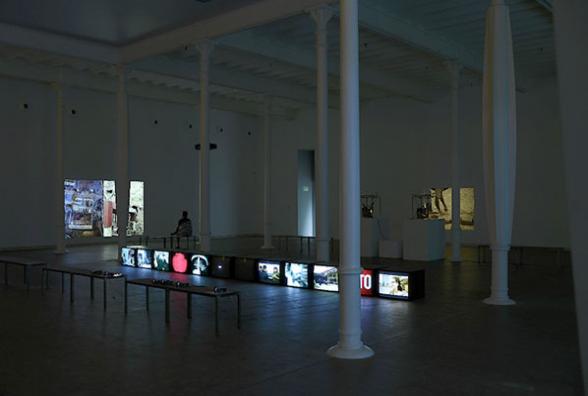
Curated to encourage a clockwise movement following the introductory piece, A New Product (2012) is being televised to the left. It commences during a mundane corporate board meeting for a consulting company violently regurgitating neoliberal logic. The goal of the meeting is to amplify competition and ascertain efficiency of their employees in the workplace by creation of a new product. Through the repetitive flipping of charts and reports, Farocki succeeds in capturing the vocabulary of rationalisation regarding their employees’ assets while unfolding the dynamics of the team and its public presentation. The narrative’s structure being static and unobtrusive, in conjunction with the ascetic use of the camera implies a degree of distancing from the subject. Still, the absence of Farocki’s own evaluation additionally contains the capability to bolster the viewer’s assessment of the situation thus achieving the artist’s desired equilibrium between empathy and distancing.
There existed a sense of rituality by which the projections were transmuted from a seemingly simple and observational nature, to one which was filled with the allegory of transparency and distance. Re-pouring (2010) was an ode to Tomas Scmidt’s Cycle for Water Buckets (or Bottles) from 1959. The original piece was a carefully choreographed mise-en-scene by which Scmidt poured one glass, a bottle of bucket of water into another. The act of pouring for Schmidt was one which indicated a simple and natural process of vaporisation with each pouring. Farocki had programmed machines to perform the artistic gesture for him, a re-pouring of the performative fluxus notion. A paradoxical act, since as human beings our navigational processes depend heavily on our cognitive ability, the mechanical hands were able to seamlessly perform the act of re-pouring. Farocki’s hyperrealism allows him to jump to a certain scale of futurity whilst also being rigorous of scrutinizing reality. The act of programming robots to perform a ritualistic and performative task goes undoubtebly implies distancing from the artistic practice of Fluxus. The Fluxus movement was predominantly a practice governed by experimental notions of performativity which were heavily conceptual. It therefore comes into stark contrast to the idea that such act could be thought by algorithm machines as notions of ‘thinking/feeling machines’ in contemporary society are rudimental and dreams of a future imagination. Farocki, able to perform the task himself such as with Indistinguishable Fire, does not. He steps out, physically distances himself from undertaking the task himself but maintains his empathy to former Fluxus activities but also expressing a empathy towards machines who today perform most human labour.
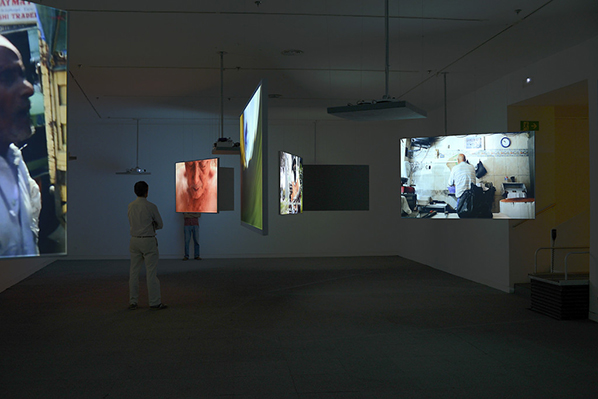
Amidst one of the spectacular accummulations of Farocki’s body of work, the apogee of the retrospective would be Labour in a Single Shot, shown for the first time in Spain. The project was initiated in 2011 by Harun Farocki and Antje Ehmann, co-curator of the retrospective. Located in an entirely different bunker, the work was compiled from a series of workshops whereby a fixed camera filmed paid, unpaid, material and immaterial labour from fifteen workshop locations. Projection screens are hanged in a room, most facing eachother whilst the noise of all labour taking place floods the space. Harmonious parallels are created as sequences from butcher shops and surgeries face eachother. The repetitive looping and sequencing of labour is used as a means of distancing and signifies non-judgmental watching as an active practice of iconic power. Our lasting impression is a call-girl sucking on a lollipop explaining how her artifice encourages clients into believing the gratification she provides is sincere. Here, we understand that just as she, through sex, retains empathy and distance in unison, Farocki’s empathy can thrive.
Featured image: 98.235.73.27, 2016-07-10
Nye Thompson is a London-based artist whose work explores the interface between physical and virtual domains. Her recent artwork Backdoored involves the collection and online archiving of images taken via unsecured surveillance cameras worldwide. Backdoored was featured at Internet Yami-Ichi at Tate Modern in May this year. Backdoored.io, curated by Kosha Hussain, followed as a solo show at Bank Gallery, London in August. Artist Millicent Hawk interviews Nye on the technology, aesthetics and universal conditions that make this work both compelling and uneasy at once.
Millicent Hawk: Backdoored is transparent in its approach – the website tagline reads, ‘Intrusion | Surveillance | Exposure’. And whilst there have been a few (mostly misinformed) concerns aired publicly about the invasive nature to the work since the first solo exhibition of it this year, you’re not actually a hacker and these images existed already before – can you explain how these images are taken and the issues they raise.
Nye Thompson: To me, Backdoored highlights the technological erosion of our privacy and through this work I’m exploring the factors that make us active contributors to this process. A ‘backdoor’ is slang for a feature or defect in a device that allows the bypassing of normal authentication. These images are generated by softbots belonging to specialist search engines which trawl connected devices (the Internet of Things) for security testing. The bots take pictures when they discover an unsecured camera and save them into their search results. In most cases the owner of the camera has no idea this is happening.
For some time now I’ve been interested in the Internet of Things and its potential impact on our personal privacy and liberties, but how do you create artistic discourse around something so abstractly technical? So when I first discovered these images they were revelatory for me because they provided me with a ready-made visual language to talk about these issues. There is also a performative thread running through the project: every day I get sent new images, and I attempt to unpick meaning from their apparent randomness by developing taxonomies and applying them to each one.
MH: So how does one avoid being, ahem, Backdoored ?
NT: If you have an IP surveillance camera in your home then you are basically broadcasting your domestic life onto the internet. This data needs to be protected by setting a unique, secure passcode on the camera. The images in Backdoored come from cameras that don’t have this. Part of the problem is a toxic combination of low public awareness of privacy risks combined with profit-hungry manufacturers and lack of regulation. But these Backdoored cameras are just harbingers of what is to come – a future surrounded by smart objects all collecting and sharing data about us.
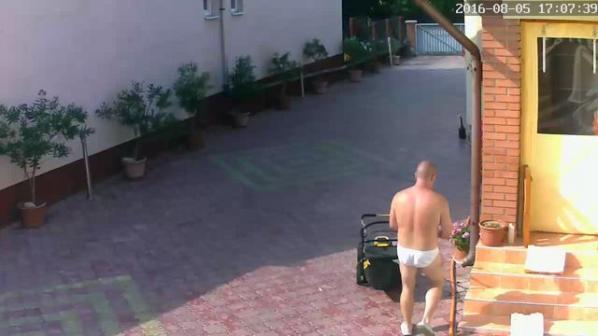
MH: The word ‘Backdoored ’ implies something that’s both disturbing but potentially exciting too, although, with explicit reference to the screenshots of a child or an elderly person in bed, combined with geo-location details – it’s totally creepy. However, those particular images aside, there’s something fascinating with many of the vidcam shots. Bots are set off to capture the image at a single point of finding unsecured domains so people are captured in their domestic settings – at ease in their pants, for example. This serendipitous and incidental timing without a human-decisive moment or any playing to the camera makes these images – albeit voyeuristic – seemingly more representative of the real and something nearer to the truth. So the digital aspect to the dark world of unsecured vidcams brings me intrigue as well as valid concerns over individual rights to privacy.
NT: Yes, although images of people in their homes form only a part of the surveillance images I find; there are wastelands, machinery, bars, building sites, hidden cameras, zombie cameras – forgotten but still broadcasting. They form a kind of covert mapping of contemporary concerns and anxieties worldwide.

MH: Yes, this is different to public surveillance and government snooping which – for the most part – seems to have been accepted. Similarly to public surveillance though, home vidcams seem an unnecessary reaction to an underlying and excessive state of fear, and the voracity to control; anxieties in these images then are represented through the choice of self-prescribed surveillance.
NT: Yes, it seems like the scenes and objects in these pictures predominantly represent a kind of metaphysical anxiety, or a way to reassure ourselves of object permanence. These are things that we feel we need to monitor constantly in case something bad happens, although it’s not always clear how we would meaningfully intervene. It’s a classic case of a technology creating a need, and a new demand on our attention. Suddenly we have the ability to watch the people and things in our life 24/7, and so not watching can almost feel like a failure to care. Yet at the same time there is a distancing, as we engage with our babies, our elderly parents, our pets, our work colleagues, our possessions – as live video streams rather than through physical, embodied interaction.

MH: Thinking back to earlier this year, Backdoored was a new idea for you. And something that I – and presumably many people – weren’t even aware was happening. At the time, we discussed the premise for this work and shared our concerns of how ethics get outpaced by rapid technological development. How do you reconcile Backdoored seeing that these images bring greater intrusion to those whose privacy they reveal?
NT: This is an important question. These images are already out there for anyone to find, and more significantly millions of these cameras are insecure and vulnerable, yet, as you said, many people are not aware of these facts. Of course I am conscious that by bringing people’s attention to them I am also amplifying the images, so there are ethical and curatorial challenges here. But these images do already exist and I’m using them in a very direct way – drawing attention to privacy and surveillance issues. There’s immediacy to imagery that resonates when a full-length article might not. I think public reports on privacy issues, by organisations like Privacy International & Big Brother Watch (to name just two), are massively important but they are endlessly firefighting this international problem. Who’s to say art can’t have an effect on these issues too?
MH: Raising awareness helps – last week I made a studio visit to an artist who had a Backdoored postcard on his desk, the tape over his webcam was a recent addition since seeing your work at Tate Modern. But, further to public awareness, lawmakers, regulators, manufacturers and commercial watchdogs need to work together to ensure privacy matters. That said, state surveillance is at a insanely invasive level – I’m thinking of GCHQ’s Smurf Suite and the Investigatory Powers Bill (which targets journalists’ privacy on whistleblowers) – vidcam backdoors perhaps seem trivial for a government to attempt to regulate and, perhaps, are even a welcomed accessory to state surveillance. On the issue of state surveillance, you were faced with some rather heavy legal threats – explain.
NT: Ah yes. Backdoored.io at Bank Gallery this year triggered an official complaint from the Hong Kong Commissioner. One of the works featured domestic scenes from Hong Kong – they seem to use a disproportionately high volume of unsecured surveillance cameras in their homes. First I received legal threats from a Chinese newspaper, then Channel 4 news weighed in with a recorded complaint from the Commissioner and demanded that I give them a (pre-recorded) interview in response. They then broadcast a sensationalised news piece, using a heavily cut version of my interview. The news article attacked me for my use of these images, while at the same time deliberately obfuscating the privacy and technology issues and how the images came to exist in the first place. Ironically, a few weeks later, the media was full of reports that the FBI was advising people to put tape over their webcams to protect their privacy!

MH: Ha, fifteen years too late. In terms of the complaint from the Chinese Commissioner for Hong Kong, it seems rather duplicitous that a country with the most pervasive internet censorship to maintain control over it’s public (I understand ProtonMail has a large Chinese user base) would be interested in threatening a UK artist here – what’s the percentage of webcams that are manufactured in China?
NT: No comment 😉
MH: So what’s next for Backdoored and how do you see the future for privacy?
NT: Backdoored highlights this very real and disturbing fact – these images already exist. What does this imply for us now and what does it imply for the future? Backdoored foregrounds privacy and surveillance, although, as an artist, I’m also interested in these images as material: the social and cultural messages encoded within them; their robotic origin; and the complex responses they evoke in the viewer. These images are signifiers for some of the epic power struggles* currently taking place at the cutting edge of technological development. This surrendering of our privacy seems like a one-way ticket; once we’ve lost that could we ever get it back? What we want for our futures must be dealt with now.
* In recent weeks we have seen just how easily these unsecured cameras can be ‘weaponised’ by hackers. For example, millions of these cameras have now been infected with the Mirai and other viruses. This allows them to be conscripted into giant ‘botnet’ armies which can be used to attack or censor other parts of the Internet.
Nye Thompson’s Backdoored will be in TERMINAL, a group exhibition opening at Avalanche in December. For 2017 she is planning a UK touring show, and also a panel discussion on issues raised by the project. Event details can be found on the Backdoored website.
Contact:
@nyethompson
www.Backdoored.io
Featured image: The Refusal of Time, film still, courtesy William Kentridge, Marian Goodman Gallery, Goodman Gallery and Lia Rumma Gallery
There is a show of art by W K now in town. My friend, if you see but one show of art works this year or the next one or yet the next I beg of you see this one. The world of these works is both our world and not our world. The world of these works is thick and dense with rune and script and sign and light. And do you know the show is called THICK TIME and this seems as they say bang on for there is a sense in which the world and all that we are in it is here boiled down is made dense or thick. And it flows in front of us and we can see in what way and where from and where to it flows. Rune and script and sign and glyph and folk and things are drawn with ink or shown with torn or cut up scraps or light yes light much of it. And since light then dark too. Yes dark. This world flows yes and this world jumps and swells and shakes too.
And song and sound. There is song and there is sound of all kinds. There is a drum a big loud drum and a thing which marks time tick tock tick tock. There are sweet sounds and harsh sounds too. There is song. And there is change. Things change this way and that. This world will fill you with joy and at times it might make you sick at heart. It will make your head ache and pulse and spin. You might need to close your eyes. This world will speed your pulse and make you sweat. You start to dance when you see this world. You might smile. You might cry. You might have as they say a lump in your throat. W. K sees the world as we see it and knows our world as we know it and sees a world that we don’t see and we don’t know and shows it to us and now we think why did we not know this world it was there in front of us all that time.
Please note W K makes stuff with his hands. That is what he does and then he makes the stuff move. He makes things come and he makes things go and he makes things flow or stay still, he makes a world but he is not a God. He makes art. This is art. If you say to me what is art I would say art is a thing like this. The best of art is a thing like this. This is rich. This is not poor thin soup but a meal we can feast on for a long time and then come back for more. (And when we come back we will find things we did not see or taste the first time!)
He is like us and in this lies his strength. And I think he likes us and in this too lies his strength. Oh and did I say he does tricks with chairs.
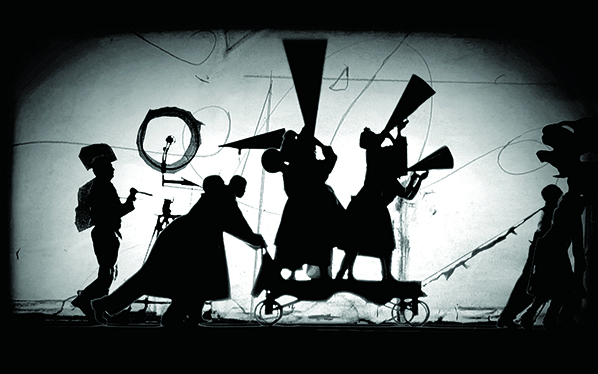
I will tell you more. Let us as they say zoom in. In the first room is a pair of lungs or things that stand for lungs. Things made of wood and nail and screw and cloth which go back and forth as if they pump and move the air. And there are screens and on the screens is light and dark. Folk walk and dance. W K too is on the screens. He does tricks with chairs (and hats too) and he walks. I think I saw once he had a stick but I might be wrong. Once he bore a young girl round his neck and walked with her on the screen. He looks you might say sad but no more as if he is in deep thought. He looks at the world. And there are such sounds now here now there it is like a spell. It is a sweet pain. And there is print and type—there are words and there are sums. Now there now crossed out now smudged now clear to read but hard to grasp what it all means.
What does ‘means’ mean? What does it mean to say art, or a work of art, means? Hmm. Though not hard for sure to feel. Not thoughts but a way to feel. The strange words and the maths make you feel. The words and the dance and what you see on the screens make you sad and glad too (and your heart beats fast). And there are folk who come and go in a long line like in a march they come and go. They come in one end and walk and dance and march and then they go out. And you smile and you think hard and you see them there and then you are there and you are them. Oh a dream of life. Oh a real hard life. Oh a life of hard dream. All pass us by. King and queen and poor and knave and prince and thief and saint and the well and the sick those who live and those who will all too soon die and those who have died they pass by us, and show us the way things are and the way things might be, both the best and the worst of it. There is filth and dirt and there is joy and a bright light and there is dark and there is space. Look! It goes on and on dark and dark. The man ails—the girl does a dance. The man jigs a jig—the girl is sick. The bird flies. The old man lives—the young girl dies. A man is in a fat suit. He looks like a great white pea. She plays a tune on a thing of brass. The clock ticks. And ticks. Oh look now there is a flash. A flash of light. It is so bright. There is death. There is an end. But look now things flow once more. There is life. Here is a new start.
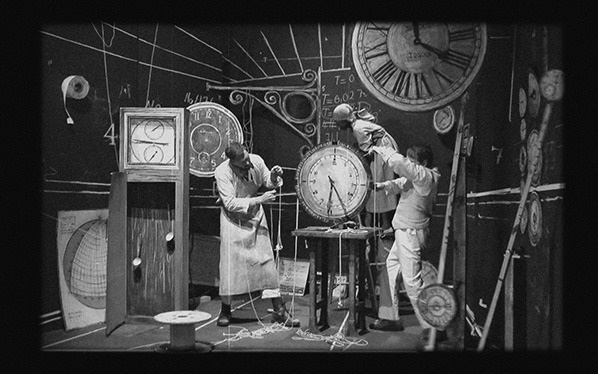
Things in a row. Things put in a row in a space, the right space. A space on a wall a space in a screen a screen in a space a space in a space. A gap. A pause. To look at— to put in the right space since this will help to make us feel and see what it might be like to be one who is not us.
I want to say W K is not cool. He dares much and this can make him trip and fall. (One piece I will not say which is not as good as the rest. What do you think?) He might fall on his face. At times he lacks grace. But so do we all. He does not fear this fact and this gives him strength. He does not seem to fear what folk might think. I like this. I do not like cool. I do not care for when art folk act as if they do not feel or they do not fear or hurt or love. As if this is not the stuff of our short life. And I do not like it when they claim this lack is good that to not feel is for them some sort of good thing.
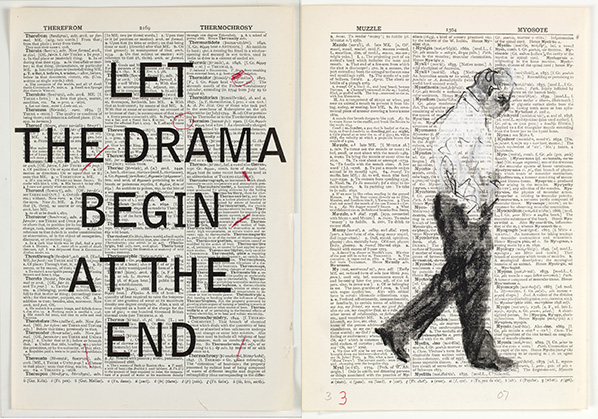
There are six rooms in all I think and all will make you feel and make you think new thoughts and a warm shock will run down your spine now and then in all those rooms. (One just one is not so good I think. Which one do you think it might be?)
There comes a point where words cease to be of help. Where they lose their point or at least their edge. For just think if we could gloss the whole of a work of art why would she or he who made it want to make it—the art ? There comes a point where words must stop where we must look and feel and not say. And if we know when to stop it seems to me we are wise and we know how to live. And in a way I think this work might help us to know how to live.
Michael Szpakowski October 2016
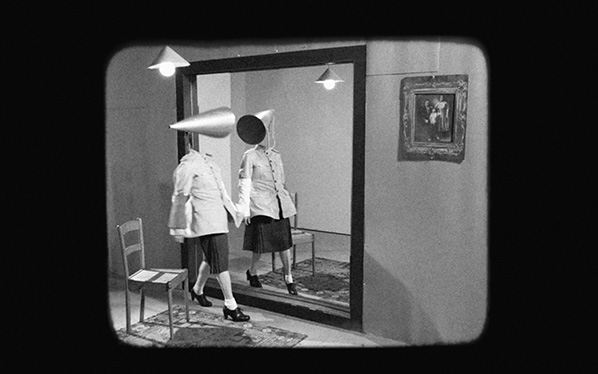
London’s Permaculture Design Course – Design 4 A.C.T.I.O.N (Active Community Transformation In Our Neighbourhoods) is a different kind of permaculture course – positive design for your life, your community and your world by empowering the genius inside all of us!

D4A is about regenerative learning, enabling individuals, organisations and communities to come together over six weekends to create empowering solutions to the real world challenges we are all facing in these times of change. Adapted from the Permaculture Association (Britain)’s PDC core curriculum, this is a person-centred, fun, lively and inclusive course, exploring and utilising concepts such as Systems Thinking, Holistic Design, Community Empowerment, ‘Whole Person’ Health, Skill Sharing, Critical Thinking, Appreciative Inquiry, Right Livelihoods and much more.
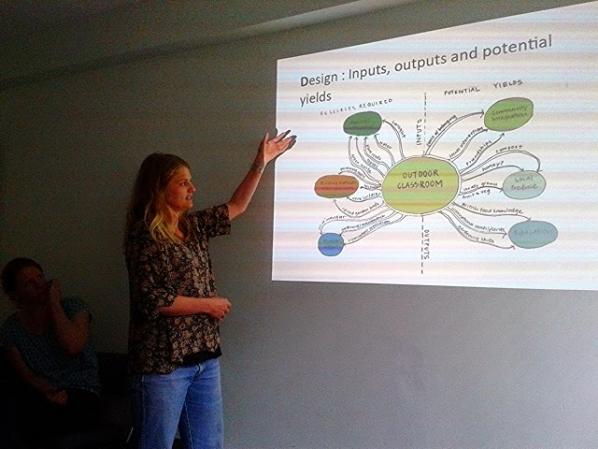
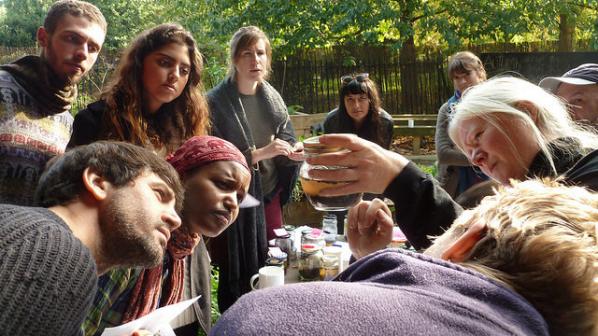
The format is participatory and dynamic using diverse visual, audio and kinesthetic learning methods such as individual and group work, games, problem solving, discussion, observation, field trips, practical activities, lectures and slideshows. This course will be hosted at Furtherfield Commons in Finsbury Park, a new and exciting partnership project at the cutting edges of dynamic cultural change: “We believe that through creative and critical engagement with practices in art and technology people are inspired and enabled to become active co-creators of their cultures and societies.”
Led By: The course will be taught by Graham Burnett (Dip. Perm Des), Claire White (Dip. Perm Des), James Taylor (MSc. Human Ecology) and some great guest teachers.
Dates: 6 weekends, October 2016 – March 2017
29 – 30 Oct 2016
19 – 20 Nov 2016
10 – 11 Dec 2016
14 – 15 Jan 2017
11 – 12 Feb 2017
11 – 12 March 2017
Cost:
£390 – Individual, concessionary rate (unwaged)
£590 – Individual, waged (income less than £25k)
£790 – Individual, waged (income more than £25k)
£790 – Sponsored/organisation rate
In many of the projects by French Vancouver-based artist Nicolas Sassoon, space and how we perceive it are two of the most inquired questions; it could seem casual that he mostly makes GIFs, but looking at his works you’ll realise the necessity of reflecting on environments, both artificial and spontaneous, using such a specific format. His works ask the viewer to not stop just at the first impressions; sure, most of his GIFs are astounding in terms of animation, use of colours and shapes, but all this technical skill is employed for inquiring our position within environments – not just laptop monitors, but real, concrete buildings and dreamy contexts as well. This is just one of the many introductory points from which we can start talking about INDEX, his latest work which has been featured on the homepage of Rhizome in the first weeks of October and that can be viewed here, on his website.
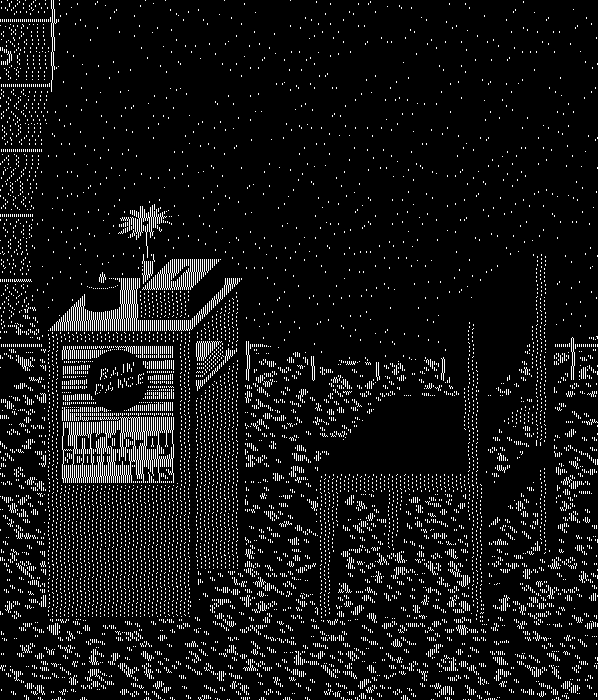
FL: One of the first things that struck me about this project is the relation between hypnagogic dimensions and the technical features of GIF format. The never ending loop of events and the way in which you can change your perception of the same object are important aspects of both; I wonder what you do think about this, especially from your point of view as an artist.
NS: INDEX is representing a project space/music venue in Vancouver BC where I co-organized electronic music events in 2015. It is depicted in the process of being setup for an event titled Rain Dance which happened in August 2015. When I started working on INDEX I was curious about the process of rendering a detailed scene from memory. I had many memories of the venue during the installation phase, a few days before the event. I began to render these memories and details from the installation period within what I could remember of the overall architecture. In that regard, INDEX is an effort to recollect and fixate details about this particular space at this specific time. Some parts of the work are relatively accurate while some other parts are imaginary. The hypnagogic and effervescent visual aspect of the work is informed by this process. It’s also informed by the nature of the events that took place at this venue.
FL: Speaking of memory, what could be a connection between it and GIFs in your own opinion? What are the technical features of this format that could it make appropriate as mean to show memories? Since you mostly worked with GIFs for many years, I wonder if you started to experience events and places as objects suitable to be translated into this format.
NS: The most tangible connection I can think of between GIFs and memory has to do with the history of the web since GIF is an image format that has survived throughout the evolution of the Internet; it is an ancient species that has survived numerous cataclysms. In my work, the connection between GIFs and memory comes from a desire to reconnect with specific moments and places, to create a form of record of these memories. The representation of these memories is an opportunity to formulate mental images of architectures, landscapes and other elements into visual forms that are minimal, incomplete, and encoded. I also enjoy using the GIF format as a very subjective archive; for example, in opposition to the objectivity of 3D scans from historical artefacts. INDEX contains some historical and factual data but it’s also completely skewed by my own perspective.

FL: This is an interesting reflection; I like the concept of the GIF format behaving as a selfish gene, in terms of adaptability throughout many different contexts and times. In your own opinion, what is the reason behind the fact it has so much importance in the last 20 years (and counting)? I can’t help but think about the relation between the ways we use to connect to the internet (ie the devices we use, the span of time we stay connected, the reasons we’re connected, etc.) and the faster and faster speed of our internet connections. What do you think?
NS: The continuous presence of GIFs online has to do with the format being perfectly adapted to web environments and its relentless user applications. If you look at early HTML pages, GIFs were always a highlight; they allowed users to add dynamic elements throughout their content. Inserting animations in the middle of text, images or diagrams was a novelty. GIFs embodied that novelty; they were a simple and accessible display of something “multi-media” so they became instantly thought after, heavily used, and stored into databases. GIFs are still pervasive today in forums as image profiles or as punctuation in comments; DUMP.FM personified that within the net-art community, but if you look at any forum or social medias platform it’s still present. From a technical standpoint, the GIF format is attractive because it works like simplified video editing; you set up an image sequence, decide on the speed, and loop it forever. Aside from the APNG format – which never really took off – no other image format offers these capabilities. It covers fundamentals, from traditional animation (frame by frame) but also offers flexibility in terms of input since you can make GIFs from literally anything. The looping function has infinite fields of applications and is impactful visually, which is perfect for the attention seeking nature of Internet space.
FL: Yes, GIFs have been very important in the first years of the Web especially because they bring depth to Web environments; the fact that artists like you are bringing this format from the usual contexts (ie laptops’ monitors, smartphones’ screens, etc) to physical spaces totally makes sense to me. In both cases, we’re talking about fixed environments where the never ending GIF’s movement affects their perception. What do you think? What does it change when you work on a project that will be on display on a Web site and another one which will be hosted on the facade of a building? I’m especially thinking in terms of spaces and perception of shapes and colours…
NS: It has been a challenging process to exhibit screen-based works into physical space, mainly because screen space and physical space are so different in terms of experience. Looking at something on a laptop screen feels intimate, but watching the same thing in a gallery or museum is more of a social experience determined by the immediate architecture. I think a lot in terms of experience in my work and I’ve come to adapt this thought process for installations. I determine the scale of my installations based on the architecture in context. I work primarily with projections whose shapes and sizes references windows, doorways, or other architectural features appearing in the space. These referential elements articulate my work in space like an environment adjusted to the architecture; an added layer which plays with the configuration of the space. I often see my installations as projected sets, or giant digital props injecting imaginary scenarios within architecture. It feels like a natural extension of what I’m trying to do with screen-based works, but it also really engages with the architecture in context.
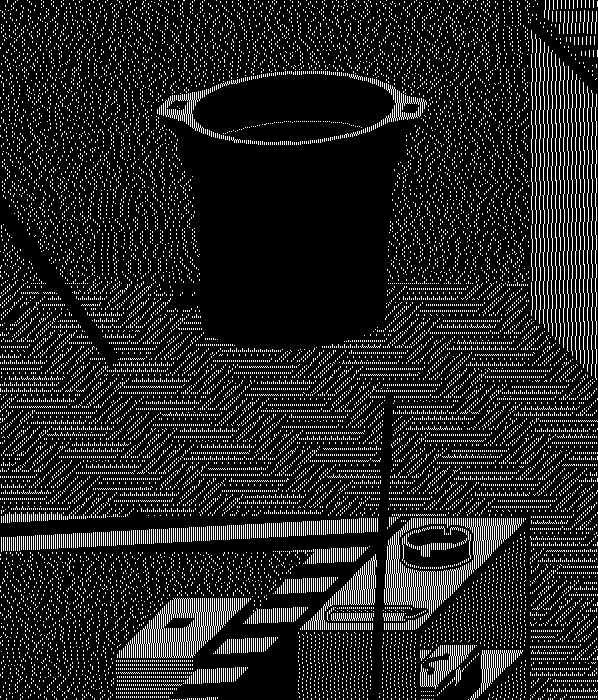
L: Speaking of the importance of GIFs in our daily online routines, I wonder if and how the so-called GIF art has been influential in respect to the broader use of this format by general public; I’m especially thinking to Simple Net Art Diagram (1997) by MTAA, to the way it used the features of this format to add a little magic to what would look like as a diagram – in other terms, do you think the irony, the cleverness and the experimental approach of the first artists working with GIFs have been understood and implemented by non-experts?
NS: I find early GIFs made by artists as influential as the GIFs made by early web designers, scientists, and other random users involved with the format. GIFs are created from pretty much anything and there has been an infinity of cross-overs in terms of influences. So many users have gone beyond the typical level of involvement with this image format, it would be presumptuous to give credit only to the artists. Still it’s amazing to see the format being acknowledged in the recent historical work on Internet Art, and I’m hoping to see many GIFs in the new Rhizome’s NET ART ANTHOLOGY! I also believe the history of GIF is a history of the vernacular which would deserve its own separate study.
FL: When you see the work, you can’t help but think of ’80s computers; in other terms, the black background and the blinking white dots and lines suggest this association. Can I ask you why you did choose this specific aesthetic?
NS: One of my interests for this type of early computer imaging has to do with the formal and optical properties of these graphics; the way they behave on screens and how they produce kinetic experiences. This is visible in works like PATTERNS where I focus on abstracted animations. Working with these out-dated graphics feels similar to working with an engraving technique or a type of craft that belongs to a certain time period. Some crafts and imaging techniques tend to be associated with specific eras. In the case of early computer graphics, their era is the end of the 20th century which I feel strongly connected to. I also look at these graphics for what they generate in terms of aesthetic experience. They are the primary visual language of the display technology we use today, and they’ve generated many revolutions in the way we perceive contemporary images.
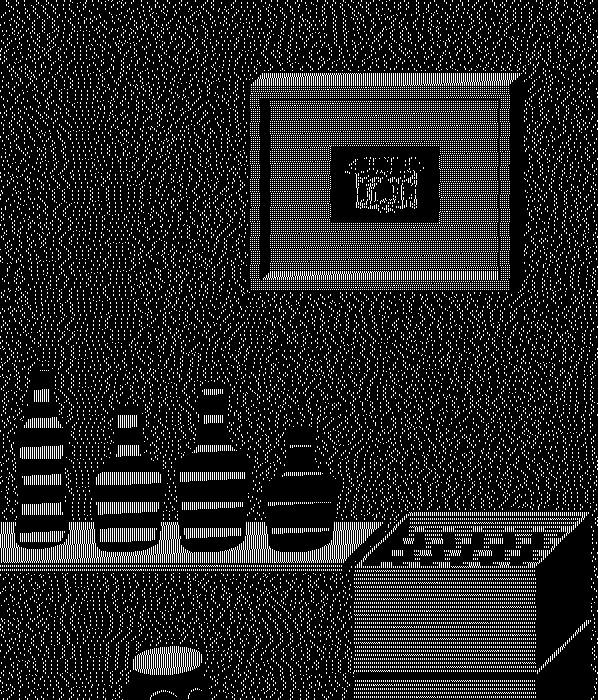
FL: You just highlighted one important aspect of your works as whole; This makes your projects, on one hand, to look modernist as they explore how minimum information can create a kinetic effect, rooted in the belief that objects can be reduced to quantifiable patterns and shapes; and on the other, they are nostalgic, reminding us of the times when when creating digital pictures was not so dissimilar from artisanship. What do you think? Am I wrong?
NS: I’ve always been attracted to the idea of developing a craft or skill as far as possible. My focus on early computer graphics was a conscious choice in that sense. It came quite late in my practice when I felt the need to make art for my own sake, without professional incentives. My generation grew up with the first home computers and there is often a generational shift of perception when it comes to early computer graphics. For me, this aesthetic is linked to childhood, fantasy, entertainment, while for other generations it doesn’t have the same emotional input. But no matter the generation, this aesthetic has a definite “time-stamp” and most audiences will associate this aesthetic with that “time-stamp”. The early stages of my practice were very focused on how to appropriate this aesthetic, to turn it into my own visual vocabulary and to articulate it with elements inside and outside of this specific “time-stamp”. I feel many affinities to painting because of this relationship I have with the visual components of my work.

FL: Speaking of painting, the other day I was reading The Social History of Art (1951) by Arnold Hauser and one text passage struck me in relation to INDEX. “[Mannerism] allows spatial values, different standards, different possibilities of movements to predominate in the different sections of the picture. […] The final effect is of real figures moving in an unreal, arbitrarily constructed space, the combination of real details in an imaginary framework, the free manipulation of the spatial coefficients purely according to the purpose of the moment. The nearest analogy to this world of mingled reality is dream.” Now, I’m not suggesting the idea that your project is mannerist, but I can see some shared features; the way you constructed the space makes me feel a set of arbitrary rules working underneath the blinking white lights, the objects you depicted are somehow real but fixed in a non-realistic dimension. What’s your opinion?
NS: When I began this project, I wanted to develop a new direction that I approached with previous works like STUDIO VISIT. I wanted to portray a real space and make it exist within a different dimension. I was picturing an animated relic, completely isolated and playing itself indefinitely. I focused on my memories of the space and on the reasons that led me to render it. Index was a project space which felt important in the cultural landscape of Vancouver, it also had its own personality. I knew the venue would eventually disappear and be forgotten for the most part. I wanted the work to become an expressive record of this, charged with energy and subjectivity. There is also a form of nostalgia expressed in the visual language I use, and I wanted to articulate this sentiment with the work. This is what led most of my formal decisions. I worked with mental images of the space seen through a lens revealing the energy of each object, and how these objects were infused with the activity of the space. For instance, some parts of the floor were made of these very small sections of hardwood flooring, and it was an area where people used to dance. This translated into a very dynamic area in the work, like a multitude of small conveyor belts imbricated into one another.

FL: It seems to me you used isometric projection to depict the objects, a technique employed mostly in technical and engineering drawings; in fact, the scenes look real but not physically reachable, as if they exist on their own – in other terms, they look eternal, recalling the still life paintings by Italian painter Giorgio Morandi. In his case, unlabelled bottles and unrecognisable objects make the scenes unhistorical and closed in themselves; I think it’s interesting the fact you both employed similar devices to depict still life objects – although it’s clear there are many important differences between your works. What do you think?
NS: I’ve always been interested in using screen-based graphics to express the materiality of physical objects or imaginary structures. This is very apparent in early works like FREE CUTS. These works were created as sketches for sculptures, but in the end, they embodied the sculptures on screen. Like paintings, digital images exist on their own plane, and they can develop their own materiality. In my work, this materiality often manifests as a tension between the flatness of the screen and the sculptural properties of the graphics. Sometimes the work feels like it resides in its own plane of existence, like an object stuck between two worlds. This image of something stuck between two worlds is dear to me because it feels so relevant to my experiences on screens. Things can appear so tangible and so distant at the same time, so desirable yet completely unattainable. With isometric perspective, I find a lot of interesting ideas in ancient Japanese works. Isometric perspective is nothing new but it seems to hold a stronger imprint from engineering drawings and video games than from these much earlier art forms. In the case of INDEX, works like The Tale of Genji – a scroll depicting Japanese interiors from the 12th century – were very inspirational. The scroll depicts social scenes with a good level of detail, and it gives the feeling of overlooking the architecture. The vision is fragmented like in INDEX, and you have to unroll – or scroll – to see the rest of the space. These old works feel very contemporary, probably because isometric perspective has been so used in computer graphics.
IMAGES FROM THE OPENING EVENT
Participating artists: [AOS] Art is Open Source, Cristina Busto, Equipo Sauti ya wakulima, Mary Flanagan, Carla Gannis, Genetic Moo, Fernando Gutiérrez, Lynn Hershman Leeson, Shu Lea Cheang, Gretta Louw & Warnayaka Art Centre, Regina de Miguel, Joana Moll & Cédric Parizot, Guido Segni, Karolina Sobecka, Alan Sondheim, Thomson & Craighead.
Monsters of the Machine is a contemporary take on Mary Shelley’s Frankenstein and asks us to reconsider her warning that scientific imagining and all technologies have unintended and dramatic consequences for the world. It also invites us to ask the same about the arts and human imagination. Shelley’s classic, gothic horror and science fiction novel has inspired millions since it was written 200 years ago in 1816 and then published anonymously in London in 1818. It offers a lens through which to look at the practices of arts and sciences today and how they shape society’s relationship with technology.
Dr Frankenstein plays the role of the Promethean scientist, a creative genius, and also a narcissist tangled up in his own individual desires, exploiting others in an irresponsible and abusive drive to control nature. However, who is the real monster? Dr Frankenstein or the poor wretched mutant he brought to life? Are we Dr Frankenstein, the suffering mutant, or both? This question posed by the exhibition considers the roles of our arts and science traditions and examines these issues as part of everyday life; as they are played out in the Anthropocene, and climate change, gender politics, ethics, governance, surveillance, posthumanism, transhumanism, hacking, biohacking, colonialism, neoliberalism, biopolitics and accelerationism.
In this exhibition, visitors can experience artworks in which the human genome is used as the basis for a poetry machine for a self-assembling video montage spanning thirteen years – a memorial work and an algorithmic visualisation for a historic scientific landmark. 3d printed avatars representing distorted bodies in pain, about virtual worlds where there’s no geography, and the result is the crack/wound, everywhere and nowhere. Visitors participate in a software-driven installation, a performative social neuroscience experiment, to discover our shared psychological biases. A surreal video installation shows us a dystopian blend of ‘reality’ out in the remote Australian desert with traditional ghost stories and Dreamtime stories mixed with science fiction. The Sahara Desert is remapped by a custom bot in an algorithmically scripted performance, traversing the data-scape of Google Maps and filling a Tumblr blog and its data centres. Artists take our bio-matter and the inconceivable quantities of data we generate in our daily lives as materials with an inherent recombinant intelligence and the power to generate (without the intervention of human will) the narratives of human destiny and more. Do we inhabit our own bodies anymore, or do we share our body materials for others to measure, reshape and construct, data-scrape and manage remotely? Arthur Kroker in Body Drift: Butler, Hayles, and Haraway say that “we no longer inhabit a body in any meaningful sense of the term but rather occupy a multiplicity of bodies – imaginary, sexualized, disciplined, gendered, labouring technologically augmented bodies.” [2]
Artists and scientists work with the same tools, frameworks and archetypes. There are crossovers. Unsurprisingly, we find the boundaries of imaginative fantasy and objective reality breaking down. Take, for instance, the jellyfish invasions around nuclear reactors in Japan, Israel, Sweden, and the Scottish plant in Torness. The natural world is writing its own science fiction into a new reality with vivid images and outlandish outcomes. Right now, the classic techno-utopian dream of computers liberating us all and providing the tools that will underpin global democratisation seems a long way off and even somewhat sterile. Since the news stories broke of mass surveillance of Internet users by NSA and Prism, we’ve experienced new formulations of mutual surveillance and manipulation daily. So now we stand at a precipice; what choice do we have but to jump into this sea of dysfunctional dystopias, and directly observe for ourselves, what we have become and what we will be, the Monsters of the Machine?
Notes:
[1] Body Drift: Butler, Hayles, Haraway (Posthumanities). Author Arthur Kroker. University of Minnesota Press (22 Oct. 2012).
[2] Body Drift: Butler, Hayles and Haraway. Review by Marc Garrett 15/08/2015.
http://www.furtherfield.org/features/reviews/body-drift-butler-hayles-and-haraway
The exhibition draws upon ideas originally written in an essay. Prometheus 2.0: Frankenstein Conquers the World! Marc Garrett.
http://www.furtherfield.org/features/prometheus-20-and-our-god-complex
Curated by: Marc Garrett, co-founder of Furtherfield.org
Graphic Design: Carmen Vázquez
With the support of:
A Book Review for Benjamin Peters’ How Not to Network a Nation: The Uneasy History of the Soviet Internet, The MITPress, 2016
“At the philosophical scale, the abundance of information and the plurality of worldviews now accessible to us through the internet is not producing a coherent consensus reality, but one riven by fundamentalist insistence on simplistic narratives, conspiracy theories, and post-factual politics. We do not seem to be able to exist within the shifting grey zone revealed to us by our increasingly ubiquitous information technologies, and instead resort to desperate modification strategies, bombarding it from the air with images and opinions in order to disperse and clarify it. It’s not working.” -James Bridle [1]
In Benjamin Peters’ “How not to Network a Nation” we learn that the USSR had the engineers with the technical knowhow and capacity to construct national computer networks of scale. Indeed, the Soviet military had such a network already in the 60s, but the question Peters wants to ask is why the USSR did not develop a ‘civilian’ computer network akin to the Internet we know and love today. The USSR did not develop a ‘civilian computer network’ because there was officially no part of the society which was independent of the state. Also, by the time anything approximating what we call the Internet began to emerge in the US, the USSR was already deep in decline. Thus, Peters’ question is moot and he only finds what is obvious from the beginning: that the social system of the USSR was incompatible with the liberal information-sphere of the capitalist West.
The book, though, should be praised for opening up and translating to English various documents, not yet available, which describe the work of early Soviet cyberneticists, and for mapping the institutional vicissitudes of the USSR at the time. We learn, for instance, about the brilliant cyberneticists Anatoly Kitov and Viktor Glushkov and their travails attempting to gather institutional support for a national civilian computer network in the USSR. Glushkov’s atrophied OGAS project forms the central narrative of the book, a project for an Inter-network of computers proposed years before Vint Cerf coined the term Internet in 1972. However, rather than appreciating the precocious cybernetic accomplishments of early Soviet theory, Peters blandly uses the “failure” of the OGAS to argue that the USSR was too perversely corrupt and bureaucratic to let progress take its course.
“Because the OGAS threatened to reorganize the social and economic spheres of life into the kind of national planned system that the command economy imagined itself to be in principle, it threatened the very practice of Soviet economic life: in [Eric P.] Hoffman’s analysis, “creates more choice and accountability and threatens firmly established formal and informal bases of power throughout the entrenched bureaucracies” [2]
Interdisciplinary historical studies of the academic, philosophical life of the USSR in English are sorely needed. Peters is sadly not sufficiently technically competent to give the reader any substantial insight into the structural concepts or proposals of the early USSR cyberneticists. It is certainly not clear from the information in the book whether any of the proposals would have produced anything akin to the Internet. In order to compensate for inadequate knowledge of political economy Peters sadly defaults to half-hearted liberal reproaches.
“Glushkov’s vision directly opposed the informal economy of mutual favours that oiled the corroded gears of Soviet production. In the end, the OGAS Project fell short because, by committing to rationalize and reform the heterarchical mess that was the command economy in practice, it promised to encourage the rational resolution of informal conflicts of interest — which worked against the instinct to preserve the personal power of almost every actor that it sought to network.”[3]
For readers interested in how the various prototype networks in the USSR (the OGAS, ESS and EASU) technically actually worked, anything about the USSR military computer network (analogous to ARPANET), how USSR computer industry differed from that of the capitalist countries, o how USSR computer theory differed from that of the capitalist countries, the book experience will be disappointing; it has too little of this. What’s really lacking is a strong attachment to the subject, the meat and bones of the OGAS, its material scale, how the projects actually ran, on a daily basis. Peters’ seems more passionately concerned with reasserting that capitalism is better than socialism because it produced the Internet.
Peters’ thesis is specious: “The first global civilian networks (sic) developed among cooperative capitalists, not among competitive socialists. The capitalists behaved like socialists, and the socialists behaved like capitalists. “ [4] The capitalists in this formulation are merely individualists, who, to Peters’ mind, surprisingly cooperated to build the network. The socialists, in his formulation, are altruists who couldn’t live up to their principles, competing with each other for resources like professors in a badly run faculty. Peters unfortunately appears not sufficiently interested in either socialism or capitalism to nuance these historically heavily-laden terms.
The utopian project, imagined by the Soviet cyberneticists for the USSR and exemplified in the Cybersyn project in Chile, was that a socialist society could manage the entirety of national production distribution and disposal more efficiently and effectively through an internally transparent communication system. Cybersyn was, however, no prototypical Internet. Such a network as Cybersyn would also likely have to be highly secure (since national security would depend on it) and the data exchanged there only selectively available to an exclusive few. Thus, such a system would not likely have produced the vibrant media environment of the Internet we know today.
Peters does not technically imagine how such alternative forms of networked computation might work. Instead he consistently returns to the vague claim that the USSR was too ideologically conflicted, flawed and corrupt to allow the flourishing of the genius of figures like Glushkov to permit the panacea of an Internet-like network to be developed there. “The history of the OGAS project is akin to the history of a miscarried effort to perform an IT upgrade for the corrupt corporation that was the USSR itself.” [5] And cloaks his disparaging attitude in befuddling doubletalk. “The Soviet network projects did not fail because they did not possess the engines of a particular Western political or technological values. They broke down for their own reasons.” [6]
What reasons? They broke down because there could be no Internet in the Soviet Union.
The book points out that the difference that created the conditions for the development of a civilian network such as the Internet was the fact that the US had a private sector which could fund research and production independent of central governmental approval. Curiously, Peters’ gives the example of Paul Baran, inventor of the packet-switching technology essential for the Internet as we know it today, who, seeing his projects disregarded by the priorities of the military industrial complex at the time, eventually abandoned it, only to see it implemented in the US after the British Post system’s research generated the same idea. Here we have two “socialist” government-funded communication projects in “capitalist” competition, apparently the secret to the technical success of the Internet.
A Soviet civilian network, equivalent to that of the nascent Internet in the US, would have meant a network of scientific/academic institutions working outside the classified military information-sphere. There was no such “civilian” sphere. What Peters shows instead is that many of the efforts to implement a national computer network outside of the military were reformist, intending to ‘liberalize’ the Soviet economy and make it more compatible with the capitalist West. “Most of the new employees [of Glushkov’s state-of-the-art cybernetics institute CEMI] were young researchers with bold ambitions and a distaste for the culture of totalitarian control in the 1940s and 1950s. Enthusiasm for decentralized economic reform met with central flows of funding”. [7] Glushkov’s senior ally in the bureaucracy Vasily Nemchinov “sought to impose ‘economic cybernetics’ and its plausibly nonsocialist “dynamic models of balancing capital investment” in the ideologically most acceptable light”. [8]
Peters points out that the USSR’s ideals of social egalitarianism were superimposed on a society which was not used to such a distribution. It is often argued, that, unlike Germany (which Marx & Engels had in mind when they wrote their Manifesto) pre-industrial Russia was lacking the institutional, industrial and economic basis for socialism. The result was that the highly abstract egalitarianism of socialism clashed with the conditions on the ground there, and generated more contradiction, inefficiencies and strife.
The promise of socialism, though it is unprecedented, is that a fairer juster society for every inhabitant of the earth can be achieved. The contradictions between the ideal and the reality need to be allowed to run their course, but this time was not afforded the USSR, as it was not afforded Chile, Cuba, Venezuela, Congo or any other nation which have dared strive for an egalitarian society. Lenin, Allende, Castro, Chavez, Lumumba came to power through popular and democratic processes but were attacked mercilessly, undermined, even assassinated by intolerant reactionary alliances from without and within. Remember that minerals from the de-liberated Congo [9], fundamental to networked computing today, are extracted under the most extreme injustice and exploitative coercion.
Peters claims the the US “succeeded in “networking a nation” because its ethos is to ask “how“ rather than “why”, and that the USSR failed because they were too concerned with “why.” The inertia of systemic unfairness socialism has to confront is immense, and, since it must deliver on its promise to improve the living conditions of the great majority, it is understandable that considerations of “why” will slow down technological choices on a national or global scale. The US and Western economies under their influence had much less of such moral compunctions. Capitalism “frees” entrepreneurs to scale ideas up to industrial scale and ‘externalises’ any deleterious consequences. Today in the age of automated techno-industrial-powered environmental degradation, resource wars and climate change, it appears far too late anymore to ask “why.” Networked capitalism has long had the answer to “how”, though: more computers.
It seems Peters wants to say with this book that socialism can be good as long as it takes place within capitalism. But since Peters’ conflates capitalism with individualism he does not see that this would mean socialist practices merely serving their conventional function as unquantified subordinate contributions to rationalizing capitalist exploitation. When Peters writes that the US built the Internet because their capitalists behaved like socialists, he is merely indicating that socialist practices are a well-spring of the value extracted by capital. Marianna Mazzucato argues convincingly how public investment in fundamental education, technologies and infrastructure brought about the great prosperity (such that it is) and unprecedented cultural affordances such was we enjoy through the Internet. [10] Socialists build things for use value, capitalists build things for surplus value. The huge edifice of Internet-based and coordinated commerce is build on functionalities built in the public interest, not to mention the house of cards ponzi scheme of contemporary financialized capital. The grand juggernaut of US capitalism is still running on infrastructure built during its brief social democratic experiment in the 1950s, which itself was a concession to labour in order to ward off nascent communism at home.
Jeremy Corbyn aims to produce a surge of public investment in vital infrastructure, which, in the proceeding decades it can be assumed, will be reappropriated piece by piece by capital. Public spending on public services do not produce merely quantifiable benefits for “stakeholders”; they produce qualitative improvements which cannot be reduced to commodities, and therefore do not require computer networks to manage or employ, but on which we nevertheless all depend for our social lives.
It is fashionable today to envisage that we are heading, or should head towards a sort of “Fully Automated Luxury Communism” (FALC), where an Internet of Things, transparently managed through a hive-mind, public-access liquid-democracy interface, a civic HyperCyberSyn, will provide unprecedented industrial efficiency and irrepressible prosperity, automatically for all. History shows however that such a system would be set upon and usurped by powerful alliances, just as has every technology in the history of humanity, for the benefit of the few and the detriment of the many. In the meantime, instead of FALC, we get Opportunistically Accelerated Predatory Rentierism, cyborg capital serving a persistent fully-automated financialized rent extraction system.
Peters attempts to close the book on a conciliatory note. “Neither American-style capitalism nor Soviet-style socialism should be considered a sufficient philosophical banner for making our way into a networked world… The social necessity of restraining self-interested competition unites, not divides, the modern legacy of cold-war capitalism.” [12] Peters’ appears to propose that capitalists (in his taxonomy) are the true socialists since they acknowledge the limits of their self-interest whereas socialists are dangerous because they must pretend as if self-interest doesn’t exist. But what can the benefit of this caricature conciliation of socialism and capitalism be? Only if we can mutualize the rentier system for the benefit of all according to their needs will we generate societies of sustainable social and economic justice worth the name communism, with all the myriad revolutionary technological affordances we can barely imagine today.
The exhibition Power and Architecture was created for viewing across several months in a particular sequence. Part 1 focused on Utopia and Modernity (12 June – 3 July), Part 2 on Dead spaces and Ruins, (July 4 – August 10), Part 3 on Citizen activated space — Museum of Skateboarding,(11 August – 11 September), and Part 4 on The afterlives of Modernity — shared values and routines, (15 September – 9 October). A conference held in June – The Centre Cannot Hold? –led by important scholars Michał Murawski (SSEES, UCL) and Jonathan Bach (New School, New York) served to frame the cultural, political, economic ramifications of “centrality and monumentality in 20th century cities” with thought from prominent researchers, architects and artists. Power and Architecture concluded this October as the Calvert 22 Foundation partners with innovative architecture, design and engineering collectives Assemble (UK), Museum of Architecture (UK) and reSITE (CZ) and an Urban Research Mobility Lab connects London with Prague by asking the question: how does migration and mobility in cities affect the experience of the urban environment? A curated series of reports, essays and photo stories further explored the themes of Power and Architecture in the online Calvert Journal available through the gallery website.
Calvert 22 is a gallery devoted to contemporary Eastern European and Russian art. They presented this exhibition as “a season on utopian public space and the quest for new national identities across the post-Soviet world.” I arrived at the gallery, a Californian artist, coincidentally just as I’d read comments from Lev Manovich about the young intelligensia of post-Soviet Russia. Thus, when thinking about the exhibition, I was also thinking about the new global mobile class and the impact of Putin’s Russia upon a new generation.
Power and Architecture is a fascinating collection of research into contemporary art, films, and research about post-Soviet urban identity and the positioning of artists therein. Obviously once communist societies have experienced dramatic change since the fall of the Berlin Wall, collapse of Soviet Russia, and rise of Putin to power. Curators used multiple cultural lenses with which to pry open a critical “western” eye on the aftermath of the Soviet era and invited exploration of cultural narratives about the “post-Soviet” city. The exhibit, particularly in certain places, looked at ideas which appear to have disappeared or become outmoded as a means of aesthetic and political communication. There was an air of longing and self-reflection towards Russian identity when experiencing the work. The Russian people have something to reckon with; a revolutionary utopia which once was, but which is no more and which has left them with the traces of an almost empire,- although to call communist Russian an empire seems to obscure the politics of the revolutionary element-. These juxtapositions were in essence the heart of the show which explored the Soviet Union as constructed space. This ”location” then functions as a backdrop to present-day national identity and urban design emerges in the portrait of a “post-Soviet” society with its own futuristic ideas as well as in the lingering relics of Soviet intentions.

Power and Architecture falls on the heels of Calvert 22’s very successful Red Africa program which examined the cultural, economic and social geography between Africa, Eastern Europe, Russia and related countries during the Cold War. The Eastern European art historical and social trend of the last thirty years labelled ‘self-historicization’ –or the self-conscious effort for Eastern European and Russian artists to articulate, archive, and collect their own history, is exercised throughout the exhibit itself designed in series of presentations directed at the problem of “historical understanding” of history. The post-Soviet city and utopian public space was used as a critical framework from which to position contemporary space, identity and the intent of the exhibiting artists. The Soviet Union has fallen, but who or how is its revising and re-examination taking place?
Part 2 which dealt with “dead spaces”, the architectural ruins of empty cities, military bases, technologial infrastructure and cavernous, open landscapes at once modern and moribund seemed to suggest that retrospective analysis of utopia could only be a well-conceived guess at what was or might have been. This Part was a sojourn into the life of Soviet artifacts both remaindered in their historical trajectory and as a convincing backdrop to a pervasive contemporary ambivalence. Danila Tkachenko’s “Restricted Areas” for instance, was a series of photographs documenting relics of the military build up of the Soviet Union only to be found on abandoned, snow-covered sites in the frozen tundra. Oversized photographs of personal ID cards from unknown persons presumably found amidst Soviet architectural rubble, large format, richly-detailed color photographs of crumbling rooms, weather-worn, orphaned Soviet-era paintings, and peeling, once colorful murals inside Soviet military bases and institutions form an historic record of obvious and shocking lack of preservation of Soviet art and architecture as Russian history. Artists participating in Dead spaces and ruins were Vahram Aghasyan, Anton Ginzburg, and Eric Lusito.
To say that this work engaged narratives which imbue modern mythologies of “utopia” with certain ideas, or contained evidence of the self-conscious effort to bring post-Soviet identity into the picture is an understatement. ‘Utopian’ ideas’ exhibited, situated in urbanism and public space, were the self-conscious investigation of old or familiar‘ or “statist” (maybe) viewpoints on public identity and gave curious attention to questions of truth, experience, voice and historic preservation found in documentary discourse. Self-historicization was apparent in Russian artist Kirill Savchenkov’s Museum of Skateboarding, a mixed media installation, which was its own entire Part 3. Savchenkov’s piece talked about the activation of public space by young people and about skateboarding as a means through which to reflect upon the post-Soviet residential suburbs of Moscow. This work suggests how certain architectural interventions or objects contain meaning and can even be accessed differently or more significantly through subculture. It alluded to tropes in notions of “world” or global “utopia” which translate across seemingly disparate spaces and identities such as Californian and post-Soviet/Soviet Russia. Moreover, this reading of public space as accessed and interpreted by youth is a powerful concept about notions of history and who it belongs to.

In Part 4 (on through Oct. 9) the urban poetics of the post-Soviet city are further contextualized by looking more closely at modernity and everyday life. The afterlives of Modernity — shared values and routines. This Part concluded the exhibit with four artists, Aikaterini Gegisian, Donald Weber, Dmytrij Wulffius, and Ogino Knauss, who examine the “afterlife” of the utopian endeavor, especially the search for new national identity. This theme is provocative to be sure, given the current political contest in the Ukraine and Russia’s role in Syrian conflicts. The curators write:
“Across the former Soviet Union there are a series of architectural and physical nostalgias connecting citizens who share the same socialist history – Part 4 of the programme reflects on these shared values and routines for citizens today.”
I asked myself the question—how does art tie societies together through processes of change? Aikaterini Gegesian’s film, “My Pink City” offers a portrait of a post-Soviet Yeravan in transition and depicts the militarisation of public space and the gendered divisions within the city. In many instances, Russian government has pushed for laws “designed to rid Ukraine’s public spaces of communist relics. Their destruction proclaims a deep desire to change the cultural narrative.” In Part 2 many documentary photographs of “dead” Soviet relics are a poignant record, and politically at odds with ideas at play in contemporary Russian national consciousness. It is a record which rightfully belongs to the Russian and Ukrainian people and which makes this show more meaningful when thought of as the struggle to preserve the past for the future.“Monumental Propaganda”, a series by Donald Weber documenting sites where Soviet monuments stood and the empty pedestals remain, speaks to exactly this. Dmytrij Wulffius’ “Traces on Concrete” is a series of photographs taken from 2009 and 2013 of his own hometown, Yalta in Crimea, which also explore its architectural landscape from the perspective of modern youth. “Re:centering Periphery: Post Socialist Triplicities” by Ogino Knauss is a fascinating examination of post-socialist history in Berlin, Belgrade, and Moscow, three cities in which modernity triggered profound utopianism towards the “radical transformation of the everyday.” The piece looks at “what is left of the architectural vision in the cities and what this legacy leaves to citizens”.

Power and Architecture aimed at a present-day coming to terms with a particular Russian existence now broken into segments and pieces. It focused profoundly on the precarity and erasure of history which plagues 21st century thought on so many levels.The real and the fake, the true and false, the meanings of “Soviet utopian vision” and its presence in time in architectural and artistic form. Without quite melding together as what that vision was in the political sense, the show formed a quasi-science fictional narrative and interpretation; a history of place, both real and imagined; promised and denied.
Central to the visual collection and comprehension of these ideas was, curiously, the strategy of the archive where the act of collection takes place and where the borders and edges of history are possible. By focusing upon the urban environment of the Soviet Union now past, Power and Architecture asked us to consider ‘what modernity is” in this context. If it is machine aesthetics as James Bridle (2011) suggests, then which machines have contributed and how do we use this modern aesthetic position on technology to examine a past? If it is the new aesthetic to be looking at old relics with a different lens, then what intellectual “spin” is constructed? For whom, how, and for what? Maybe modernity is all of these—a presence of unprecedented scale in terms of cities, and the sky and the water. How do we see this totality now? How did they see it then?
Modernity did come upon Eastern Europe and Russia, arguably in similar and dissimilar ways to how it was absorbed in the west. Power and Architecture re-examined the Soviet epoch, through what artists are seeing and thinking about what has remained. It seemed expressed as a brute emergence of a set of ideas which, because they were collective, revolutionary, technological, shaped and still shape Russian consciousness, but as a past. How the past is preserved or ingested is again a compelling idea on the power-struggles for “history” which take place in modern times. Power and Architecture elucidated key features of this new era of global subjectivity and societal change through creative lenses of the recent past.
“AI just 3D printed a brand-new Rembrandt, and it’s shockingly good” reads the title of a PC World article in April 2016. Advertising firm J. Walter Thompson unveiled a 3D printed painting called “The Next Rembrandt”, based on 346 paintings of the old master. Not just PC World, many more articles touted similar titles, presenting the painting to the public as if it were made by a computer, a 3D printer, Artificial Intelligence and deep learning. It is clear though that the programmers who worked on the project are not computers, and neither are the people who tagged the 346 Rembrandt paintings by hand. The painting was made by a team of programmers and researchers, and it took them 18 months to do so.
A very successful feat of advertising, and a great example of how eager we are to attribute human qualities to computers and see data as the magic powder bringing life to humanity’s most confusing tool. Data is the new black… it can touch our soul according to a Microsoft spokesperson on the website of the Next Rembrandt: “Data is used by many people today to help them be more efficient and knowledgeable about their daily work, and about the decisions they need to make. But in this project it’s also used to make life itself more beautiful. It really touches the human soul.” (Ron Augustus, Microsoft). We have elevated data to divine standards and have developed a tendency to confuse tools with their creators in the process. Nobody in the 17th Century would have dreamed of claiming a brush and some paint created The Night Watch, or that it’s a good idea to spend 18 months on one painting.
The anthropomorphisation of computers was researched in depth by Reeves and Nass in The Media Equation (1996). They show through multiple experiments how people treat computers, television, and new media like real people and places. On the back of the book, Bill Gates says Nass and Reeves show us some “amazing things”. And he was right. Even though test subjects were completely unaware of it, they responded to computers as they would to people, by being polite, cooperative, attributing personality characteristics such as aggressiveness, humour, expertise, and even gender. If only Microsoft would use this knowledge to improve the way people interact with their products, instead of using it for advertising campaigns promoting a belief in the magic powers of computers and data. Or… oh wait… This belief, combined with the anthropomorphising of computers, profoundly alters the way people interact with machines and makes it much more likely that users will accept and adapt to the limitations and demands of technology, instead of demanding technology should adapt to them.
Strangely enough, the anthropomorphising of computers goes hand in hand with attributing authority, objectivity, even superiority to computer output by obfuscating the human hand in its generation. It seems paradoxical to attribute human qualities to something, while at the same time considering it to be more objective than humans. How can these two beliefs exist side by side? We are easily fooled, ask any magician. As long as our attention is distracted, steered, you can hide things in plain sight. We haven’t been too bothered with this paradox in the past. The obfuscation of a human hand in the generation of messages that require an objective or authoritative feel is very old. As a species, we’ve always turned to godly or mythical agents, in order to make sense of what we did not understand, to seek counsel. We asked higher powers to guide us. These higher powers rarely spoke to us directly. Usually messages were mediated by humans: priestesses, shamans or oracles. These mediations were validated as objective and true transmissions through a formalisation of the process in ritual, and later institutionalised as religion, obfuscating the human hand in the generation of these messages. Although disputed, it is commonly believed that the Delphic oracle delivered messages from her god Apollo in a state of trance, induced by intoxicating vapours arising from the chasm over which she was seated. Possessed by her god the oracle spoke, ecstatically and spontaneously. Priests of the temple translated her words into the prophecies the seekers of advice were sent home with. Apollo had spoken.
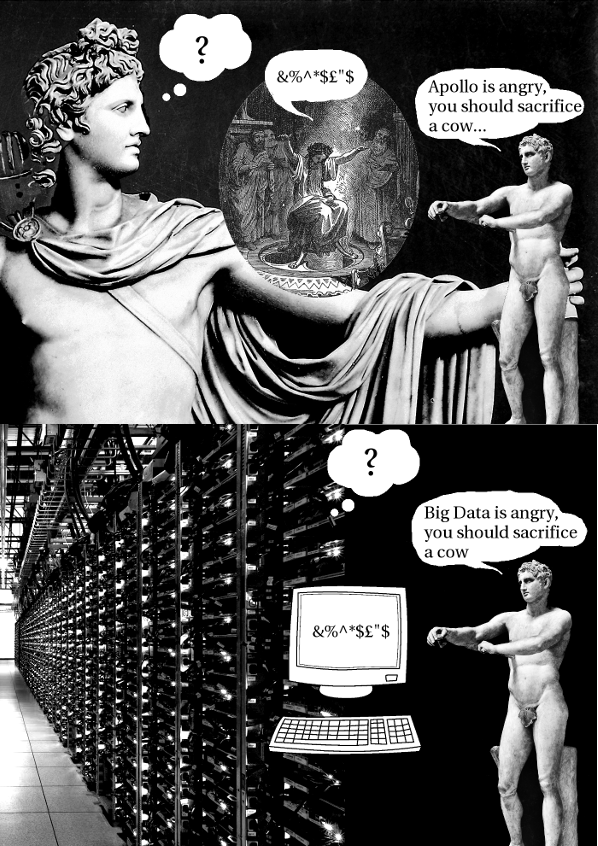
Nowadays we turn to data for advice. The oracle of big data[1] functions in a similar way to the oracle of Delphi. Algorithms programmed by humans are fed data and consequently spit out numbers that are then translated and interpreted by researchers into the prophecies the seekers of advice are sent home with. The bigger the data set, the more accurate the results. Data has spoken. We are brought closer to the truth, to reality as it is, unmediated by us subjective, biased and error-prone humans. We seek guidance, just like our ancestors, hoping we can steer events in our favour. Because of this point of departure, very strong emotions are attached to big data analysis, feelings of great hope and intense fear. Visions of utopia, the hope that it will create new insights into climate change and accurate predictions of terrorist attacks, protecting us from great disaster. At the same time there are visions of dystopia, of a society where privacy invasion is business as usual, and through this invasion an ever increasing grip on people through state and corporate control, both directly and through unseen manipulation.
Let’s take a closer look at big data utopia, where the analysis of data will protect us from harm. This ideology is fed by fear and has driven states and corporations alike to gather data like there is no tomorrow or right to privacy, at once linking it very tightly to big data dystopia. What is striking is that the fear of terrorist attacks has led to lots of data gathering, the introduction of new laws and military action on the part of governments, yet the fear of climate change has led to only very moderate activity. Yet the impact of the latter is likely to have more far reaching consequences on humanity’s ability to survive. In any case, the idea of being able to predict disaster is a tricky one. In the case of global warming, we can see it coming and aggravating because it is already taking place. But other disasters are hard to predict and can only be explained in retrospect. In Antifragility, Nicolas Taleb (2013, pp.92-93), inspired by a metaphor of Bertrand Russell, quite brilliantly explains the tendency to mistake absence of evidence for evidence of absence with a story about turkeys. Turkeys are fed for a thousand days by a butcher, leading them to believe, backed up by statistical evidence, that butchers love turkeys. Right when the turkey is most convinced that butchers love turkeys, when it is well fed and everything is quiet and predictable, the butcher surprises the turkey which has to drastically revise its beliefs.
An only slightly more subtle version of big data utopia is a utopia where data can speak, brings us closer to reality as it is, where we can safely forget theory and ideas and other messy subjective human influences through crunching enormous amounts of numbers.
“This is a world where massive amounts of data and applied mathematics replace every other tool that might be brought to bear. Out with every theory of human behaviour, from linguistics to sociology. Forget taxonomy, ontology, and psychology. Who knows why people do what they do? The point is they do it, and we can track and measure it with unprecedented fidelity. With enough data, the numbers speak for themselves.” (Anderson, 2008)
Using this rhetoric, there is no more need for models or hypotheses, correlation is enough. Just throw in the numbers and the algorithms will spit out patterns that traditional scientific methods were unable to bring to light. This promise sells well and companies providing data analysis and storage services promote it with great enthusiasm, as demonstrated by two slides in an Oracle presentation at Strata 2015: “Data Capital is the land grab of the future” and “It’s yours for the taking” (Pollock, 2015).
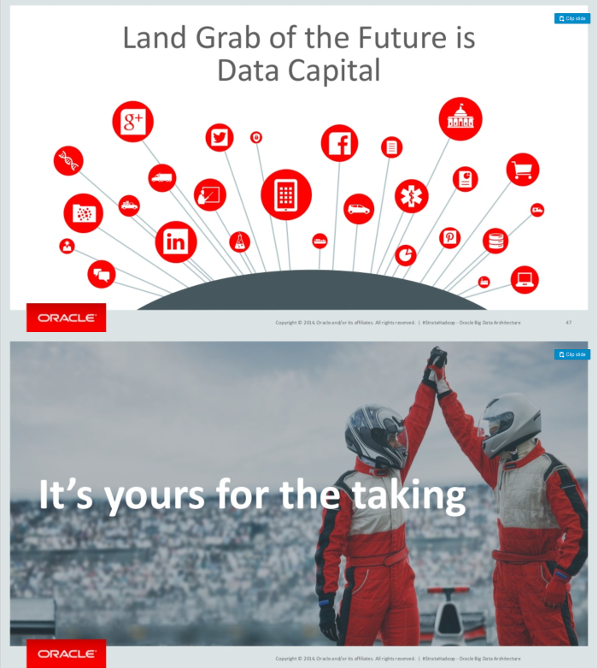
Can numbers really speak for themselves? When taking a closer look, a lot of assumptions come to light, constructing the myth of the oracle. Harford (2014) describes these assumptions as four articles of faith. The first is the belief in uncanny accuracy. This belief focuses all attention on the cases where data analysis made a correct prediction, while ignoring all false positive findings. Being right one out of ten times may still be highly profitable for some business applications, but uncannily accurate it is not. The second article is the belief that not causation, but correlation matters. The biggest issue with this belief is that if you don’t understand why things correlate, you have no idea why they might stop correlating either, making predictions very fragile in an ever changing world. Third is the faith in massive data sets being immune to sampling bias, because there is no selection taking place. Yet found data contains a lot of bias, as for example not everyone has a smartphone, and not everyone is on Twitter. Last but not least, the fourth belief, that numbers can speak for themselves… is hard to cling to when spurious correlations create so much noise, it’s hard to filter out the real discoveries. Taleb (2013, p.418) points to the enormous amount of cherry-picking done in big data research. There are way too many variables in modern life, making spurious relations grow at a much faster pace than real information.
As a rather poetic example, Leinweber (2007) demonstrated that data mining techniques could show a strong but spurious correlation between the changes in the S&P 500 stock index and butter production in Bangladesh. There is more to meaningful data analysis than finding statistical patterns, which show correlation rather than causation. Boyd and Crawford describe the beliefs attached to big data as a mythology, “the widespread belief that large data sets offer a higher form of intelligence and knowledge that can generate insights that were previously impossible, with the aura of truth, objectivity, and accuracy” (Boyd and Crawford, 2012). The belief in this oracle has quite far reaching implications. For one, it dehumanises humans by asserting that human involvement through hypotheses and interpretation, is unreliable, and only by removing humans from the equation can we finally see the world as it is. While putting humans and human thought on the sideline, it obfuscates the human hand in the generation of its messages and anthropomorphises the computer by claiming it is able to analyse, draw conclusions, even speak to us. The practical consequence of this dynamic is that it is no longer possible to argue with the outcome of big data analysis. This becomes painful when you find yourself in the wrong category of a social sorting algorithm guiding real world decisions on insurance, mortgage, work, border checks, scholarships and so on. Exclusion from certain privileges is only the most optimistic scenario, more dark ones involve basic human rights.
The deconstruction of this myth was attempted as early as 1984. In “A Spreadsheet Way of Knowledge”, Stephen Levy describes how the authoritative look of a spreadsheet, and the fact that it was done by a computer, has a strong persuasive effect on people, leading to acceptance of the proposed model of reality as gospel. Levy points out that all the benefits of using spreadsheets are meaningless if the metaphor is taken too seriously. He concludes with a statement completely opposite to what Anderson will state 24 years later: “Fortunately, few would argue that all relations between people can be quantified and manipulated by formulas. Of human behaviour, no faultless assumptions – and so no perfect model — can be made”. A lot has changed in 24 years. Still back in the eighties, Theodore Roszak describes the subjective core of software beautifully: “Computers, as the experts continually remind us, are nothing more than their programs make them. But as the sentiments above should make clear, the programs may have a program hidden within them, an agenda of values that counts for more than all the interactive virtues and graphic tricks of the technology. The essence of the machine is its software, but the essence of the software is its philosophy” (Roszak, 1986). This essence, sadly, is often forgotten, and outcomes of data analysis therefore misinterpreted. In order to correctly assess the outcomes of data analysis it is essential to acknowledge that interpretation is at the heart of the process, and assumptions, bias and limitations are undeniable parts of it.
In order to better understand the widespread belief in the myth of big data, it is important to look at the shift in the meaning of the word information (Roszak, 1986). In the 1950s, with the advent of cybernetics, the study of feedback in self-regulating closed systems, information transformed from short statement of fact to the means to control a system, any system, be it mechanical, physical, biological, cognitive or social (Wiener, 1950). In the 1960s artificial intelligence researchers started viewing both computers and humans as information processing systems (Weizenbaum, p.169). In the 1970s it was granted an even more powerful status, that of commodity. The information economy was born and promoted with great enthusiasm in the 1980s.
“Reading Naisbitt and Toffler is like a fast jog down a world’s Fair Midway. We might almost believe, from their simplistic formulation of the information economy, that we will soon be living on a diet of floppy disks and walking streets paved with microchips. Seemingly, there are no longer any fields to till, any ores to mine, any heavy industrial goods to manufacture; at most these continuing necessities of life are mentioned in passing and then lost in the sizzle of pure electronic energy somehow meeting all human needs painlessly and instantaneously.” (Roszak, 1986, p. 22).
Nowadays not only corporations and governments, but individuals have become information hungry. What started as a slightly awkward hobby in the 80s, the quantified self has now become mainstream with people self monitoring anything from sleep to eating habits, from sport activities to mood using smartphones and smartwatches with build-in sensors, uploading intimate details such as heart-rate, sleep patterns and whereabouts to corporate servers in order to improve their performance.
Even with this change in the way we view information in mind, it is difficult to believe we cannot see through the myth. How did it become plausible to transpose cybernetic thinking from feedback in self-regulating closed systems to society and even to human beings? It is quite a leap, but we somehow took it. Do humans have anything in common with such systems? Weizenbaum (1976) explains our view of man as machine through our strong emotional ties to computers, through the internalisation of aspects of computers in order to operate them, in the form of kinaesthetic and perceptual habits. He describes how in that sense, man’s instruments become part of him and alter the nature of his relationship to himself. In The Empty Brain (2016) research psychologist Robert Epstein writes about the idea that we nowadays tend to view ourselves as information processors, but points out there is a very essential difference between us and computers: humans have no physical representations of the world in their brains. Our memory and that of a computer have nothing in common, we do not store, retrieve and process information and we are not guided by algorithms.

Epstein refers to George Zarkadakis’ book In Our Own Image (2015), where he describes six different metaphors people have employed over the past 2,000 years to try to explain human intelligence. In the earliest one, eventually preserved in the Bible, humans were formed from clay or dirt, which an intelligent god then infused with its spirit. This spirit somehow provided our intelligence. The invention of hydraulic engineering in the 3rd century BC led to the popularity of a hydraulic model of human intelligence, the idea that the flow of different fluids in the body – the ‘humours’ – accounted for both our physical and mental functioning. By the 1500s, automata powered by springs and gears had been devised, eventually inspiring leading thinkers such as René Descartes to assert that humans are complex machines. By the 1700s, discoveries about electricity and chemistry led to new theories of human intelligence – again, largely metaphorical in nature. In the mid-1800s, inspired by recent advances in communications, the German physicist Hermann von Helmholtz compared the brain to a telegraph. Predictably, just a few years after the dawn of computer technology in the 1940s, the brain was said to operate like a computer, with the role of physical hardware played by the brain itself and our thoughts serving as software.
This explanation of human intelligence, the information processing metaphor, has infused our thinking over the past 75 years. Even though our brains are wet and warm, obviously an inseparable part of our bodies, and using not only electrical impulses but also neurotransmitters, blood, hormones and more, nowadays it is not uncommon to think of neurons as ‘processing units’, synapses as ‘circuitry’, ‘processing’ sensory ‘input’, creating behavioural ‘outputs’. The use of metaphors to describe science to laymen also led to the idea that we are ‘programmed’ through the ‘code’ contained in our DNA. Besides leading to the question of who the programmer is, these metaphors make it hard to investigate the nature of our intelligence and the nature of our machines with an open mind. They make it hard to distinguish the human hand in computers, from the characteristics of the machine itself, anthropomorphising the machine, while at the same time dehumanising ourselves. For instance, Alan Turing’s test to prove if a computer could be regarded as thinking, now is popularly seen as a test that proves if a computer is thinking. Only in horror movies would a puppeteer start to perceive his puppet as an autonomous and conscious entity. The Turing test only shows whether or not a computer can be perceived of as thinking by a human. That is why Turing called it the imitation game. “The Turing Test is not a definition of thinking, but an admission of ignorance — an admission that it is impossible to ever empirically verify the consciousness of any being but yourself.” (Schulman, 2009). What a critical examination of the IP metaphor makes clear, is that in an attempt to make sense of something we don’t understand, we’ve invented a way of speaking about ourselves and our technology that obscures instead of clarifies both our nature and that of our machines.
Why dehumanize and marginalize ourselves through the paradox of viewing ourselves as flawed, wanting a higher form of intelligence to guide us, envisioning superhuman powers in a machine created by us, filled with programs written by us, giving us nothing but numbers that need interpretation by us, obfuscating our own role in the process yet viewing the outcome as authoritative and superior. A magician cannot trick himself. Once revealed, never concealed. Yet we manage to fall for a self created illusion time and time again. We fall for it because we want to believe. We joined the church of big data out of fear, in the hope it would protect us from harm by making the world predictable and controllable. With the sword of Damocles hanging over our heads, global warming setting in motion a chain of catastrophes, threatening our survival, facing the inevitable death of capitalism’s myth of eternal growth as earth’s resources run out, we need a way out. Since changing light bulbs didn’t do the trick, and changing the way society is run seems too complicated, the promise of a technological solution inspires great hope. Really smart scientists, with the help of massive data sets and ridiculously clever AI will suddenly find the answer. In ten years time we’ll laugh at the way we panicked about global warming, safely aboard our CO2 vacuum cleaners orbiting a temporarily abandoned planet Earth.
Theinformation processing metaphor got us completely hooked on gathering data. We are after all information processors. The more data at our fingertips, the more powerful we become. Once we have enough data, we will finally be in control, able to predict formerly unforeseen events, able to steer the outcome of any process because for the first time in history we’ll understand the world as it really is. False hope. Taken to itsextreme, the metaphor leads to the belief that human consciousness, being so similar to computer software, can be transferred to a computer.
“One prediction – made by the futurist Kurzweil, the physicist Stephen Hawking and the neuroscientist Randal Koene, among others – is that, because human consciousness is supposedly like computer software, it will soon be possible to download human minds to a computer, in the circuits of which we will become immensely powerful intellectually and, quite possibly, immortal.” (Epstein, 2016).
False hope. Another example is the project Alliance to Rescue Civilization (ARC), by scientists E. Burrows and Robert Shapiro. It is a project that aims to back up human civilization in a lunar facility. The project artificially separates the “hardware” of the planet with its oceans and soils, and the “data” of human civilization (Bennan, 2016). Even thoughseeing the need to store things off-planet conveys aless than optimisticoutlook on the future, the project gives the false impression that technology can separate us from earth. A project pushing this separation to its extreme is Elon Musk’s SpaceX plan to colonize Mars, announced in June 2016, and gaining momentum with his presentation at the 67th International Astronautical Congress in Guadalajara, September 27th. The goal of the presentation was to make living on Mars seem possible within our lifetime. Possible, and fun.
“It would be quite fun because you have gravity, which is about 37% that of Earth, so you’d be able to lift heavy things and bound around and have a lot of fun.” (Musk, 2016).
We are inseparable from the world we live in. An artificial separation from earth, which we are part of and on which our existence depends, will only lead to a more casual attitude towards the destruction of its ecosystems. We‘ll never be immortal, downloadable or rescued from a lunar facility in the form of a back up. Living on Mars is not only completely impossible at this moment, nothing guarantees it will bein the future. Even if it were possible, and you would be one of the select few that could afford to go, you’d spend your remaining days isolated on a life-less, desolate planet, chronically sleep deprived, with a high risk of cancer, a bloated head, the bone density and muscle mass worse than that of a 120 year old, due to the small amount of gravity and high amount of radiation (Chang, 2014).Just like faster and more precise calculations regarding the position of planets in our solar system will not make astrology more accurate in predicting the future, faster machines, more compact forms of data storage and larger data setswill not make us able to predict and control the future. Technological advances will not transform our species from a slowly evolving one, into one that can adapt to extreme changes in our environmentinstantly, as we would need to in the case of a rapidly changing climate or a move to another planet.
These are the more extreme examples, that are interesting because they make the escapist attitude to our situation so painfully clear. Yet the more widely accepted beliefs are just as damaging. The belief that with so much data at our fingertips, we’ll make amazing new discoveries that will safe us just in time, leads to hope that distracts us from the real issues that threaten us. There are 7.4 billion of us. The earth’s resources are running out. Climate change will set in motion a chain of events we cannot predict precisely but dramatic sea level rises and mass extinction will be part of it without doubt. We cannot all Houdini out of this one, no matter how tech savvy we might become in the next decades. Hope is essential, but a false sense of safety paralyses us and we need to start acting. In an attempt to understand the world, to become less fragile, in the most rational and scientifically sound way we could think of, we’ve started anthropomorphising machines and dehumanising ourselves. This has, besides inspiring a great number of Hollywood productions, created a massive blind spot and left us paralysed. While we are bravely filling up the world’s hard disks, we ignore our biggest weakness: this planet we are on, it’s irreplaceable and our existence on it only possible under certain conditions. Our habits, our quest to become more productive, more efficient, more safe, less mortal, more superhuman, actually endangers us as a species… With technology there to save us, there is no urgency to act. Time to dispel the myth, to exit the church of big data and start acting in our best interest, as a species, not as isolated packages of selfish genes organized as information processors ready to be swooshed off the planet in a singularity style rapture.

Announcing a new film and groundbreaking collaboration
The Blockchain: Change everything forever WATCH HERE
This new film released online on 3 October 2016 by Furtherfield in collaboration with Digital Catapult broadens the current debate about the impact of emerging blockchain technologies.
The underpinning technology of Bitcoin digital currency, the Blockchain is reshaping concepts of value, trust, law and governance. This film sets out to diversify the people involved in its future by bringing together leading thinkers, computer scientists, entrepreneurs, artists and activists who discuss:
What can a blockchain do?
Who builds this new reality?
How will we rule ourselves?
How will the future be different because of the Blockchain?
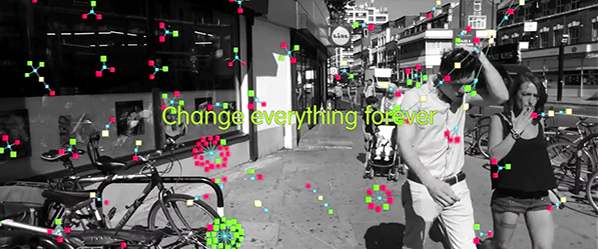
This is a unique collaboration between Furtherfield, dedicated to new forms of cooperation in arts, technology and society and Digital Catapult, an organisation dedicated to growing the UK digital economy.
DOWNLOAD
PRESS RELEASE (.pdf)
TRANSCRIPT (.pdf)
Directed by Pete Gomes
Concept, research and development by Ruth Catlow, Furtherfield, Co-founder and Co-director.
Contributors: Dr Anat Elhalal, Digital Catapult; Ben Vickers, Co-founder unMonastery and Curator of Digital, Serpentine Galleries; Dr Catherine Mulligan, Research Fellow, Associate Director – Centre for Cryptocurrency Research, Imperial College; Elias Haase, Developer, Thinker, Beekeeper, Founder of B9lab; Irra Ariella Khi, Co-founder and CEO Vchain Technology; Jaime Sevilla, developer, researcher, GHAYA , #hackforgood; Jaya Klara Brekke, digital strategy, design, research and curating, Durham University; Kei Kreutler, Independent Researcher, Co-founder unMonastery; Pavlo Tanasyuk, CEO BlockVerify; Rhea Myers, artist, writer, hacker; Sam Davies, Lead Technologist – Creative Programmes, Digital Catapult; Vinay Gupta, resilience guru, Hexayurt
Pixelache Festival 2016, Helsinki, Finland. 22-25 September 2016
BLOCKCHAIN MEETUP, London Digital Catapult Centre, London, UK. 27 October 2016
INAUGURAL BRISBANE BLOCKCHAIN SYMPOSIUM 2016, Brisbane, Australia. 3 November 2016
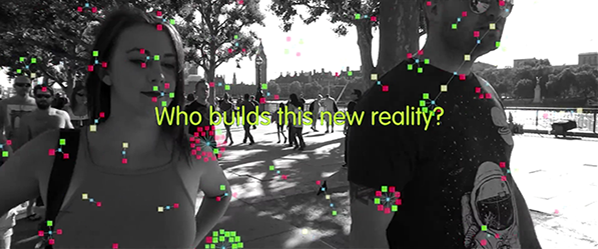
The Blockchain – Change everything forever has been made as part of Furtherfield’s Art Data Money programme which seeks to build a commons for the arts in the network age. A book, Artists Re:Thinking The Blockchain in partnership with itinerant publisher and arts organisation Torque will be published in Spring 2017 with the prequel due out November 2016.
Furtherfield is an international hub for arts, technology and social change. Since 1997, Furtherfield has created online platforms and physical places for exhibitions, labs and debates where different types of people explore today’s important questions. Furtherfield is an Arts Council England ‘National Portfolio’ organisation with a Gallery and Lab in London’s Finsbury Park http://furtherfield.org/
Digital Catapult works with SMEs to help them grow and scale faster. It helps larger corporates in their digital transformation. It does this through programmes of collaboration and open innovation, by bringing academic leading edge expertise into the mix combined with the organisation’s own business and technological expertise. https://digital.catapult.org.uk
For any additional materials and interviews
Please contact Ruth Catlow
ruth.catlow@furtherfield.org
@furtherfield
A Furtherfield film made in collaboration with Digital Catapult, with support from Arts Council England and Southbank Centre.

![]()
![]()
Blockchain: Change everything forever
What is the Blockchain?
The Blockchain is the underpinning technology for Bitcoin digital currency, and is said to be at the same stage of development as the World Wide Web in the late 1980s. Its promoters claim that the global deployment of smart contracts via this new decentralised protocol will change everything forever.
The Blockchain in Context
In 2008 Bitcoin, the first global digital currency was described in a white paper by the pseudonymous Satoshi Nakamoto. While the WWW facilitated a worldwide (economic and social) revolution in the global distribution of information, the Blockchain, would facilitate secure, decentralised record-keeping, exchange of digital assets and the mining and exchange of computationally secured value.
Since 2013 blockchains have become a focus for investment by world banks, FinTechs and corporations who predict a fourth industrial revolution of super-automation and hyperconnectivity. This is also accompanied by predictions from the World Economic Forum of increased global inequity.
In this version of the future, code replaces legislation. “Code becomes law”. Decentralised Autonomous Organisations (DAOs) route around systems of regulation and taxation via immutable smart contracts, globally deployed across the Blockchain.
The film The Blockchain: Change everything forever proposes that people from diverse disciplines and backgrounds should be involved to work out how Blockchain technologies can be shaped for more decentralised power, diverse needs and interests into the future.
*Jaya Klara Brekke, Digital strategy, design, research and curating, Durham University
DOWNLOAD PRESS RELEASE (.pdf)
SEE IMAGES FROM ACCOMPANYING EVENTS
LISTEN to a recording of the conversation with John Conomos and Steven Ball at Furtherfield Gallery
Deep Water Web is a free exhibition at Furtherfield Gallery in London’s Finsbury Park, connecting opposite sides of the Earth to understand human impacts on the environment and the wider consequences for people living in both locations.
Artists Steven Ball (London, UK) and John Conomos (Sydney, Australia) have collaborated to present a multi-projection installation where London and Sydney are continuously connected across time zones. The exhibition is an immersive experience which the artists have termed a ‘hyperlandscape’ including real time streaming waterscapes and multiple local manifestations of global ecologies with their own sonic environments and narrated reflections.

Deep Water Web is a poetic meditation around contemporary and historical geopolitical contexts, underscored by London and Sydney’s situation around large bodies of tidal water in the forms of the River Thames and Sydney Harbour. These bodies of water bear material evidence of the local impact of global warming, such as rising tide levels caused by melting ice caps, leading to flooding, and increasingly extreme climate fluctuation. Both cities are also centres of neoliberal capitalism, inscribing the effects of privatisation, fiscal austerity and deregulation of markets across the planet.
Deep Water Web weaves rhetorical explication of postcolonial relationship, elaborating the precarious material forms of climate change, and post-labour late capitalist neoliberal urban developments of waterfronts of former Docklands, considered within the geological and rhetorical ecology of the Anthropocene.
The age of global warming and global neoliberal capitalism are figured here as critical rhetorical realms. These phenomena can be described as what Timothy Morton has called hyperobjects, objects so massively distributed in time and space as to transcend localisation. While they are impossible to comprehend at scale, hyperobjects exert a profound effect at a local level.

Deep Water Web will also become a catalyst for a workshops series at Furtherfield Commons, which will extend its themes through media based excavations. [dates and full details to be confirmed]
Both artists both have long standing moving image based practices and an interest in landscape and the representation of place. As a hyperlandscape this project suggests that questions of relationship to place, and the construction of landscape, can in the Anthropocene no longer be considered as simply pictorial representation or subjective experience, but is constituted from a range of critical, ethical, ecological, and political positions and concerns.
+ MORE INFO: http://deepwaterweb.net
Deep Water Web is supported by Arts Council England.
Exhibition Tour with artist Steven Ball
Tuesday 4 October 2016 – 5:30-6:15pm – Furtherfield Gallery
Revolutions and Complex Systems
Every Tuesday for 6 weeks
6:30 – 8:30pm at Furtherfield Commons – from 27 September 2016
BOOKING ESSENTIAL
A conversation with John Conomos and Steven Ball
2-3pm Saturday 29 October – Furtherfield Gallery
Booking is essential for this free event
Furtherfield in partnership with the antiuniversity and Radical Think Tank are proud to present this new 6-part course led by Graham Jones.
Aimed at people with an interest in social change, the course will apply concepts from complex systems theory to understanding revolutions and social movements. Sessions will involves a mix of speaker presentation and participatory discussions/activities, covering subjects such as ecology, network theory and new materialist philosophy.
Graham Jones is an activist based in East London, working with groups such as Radical Assembly, Radical Housing Network and Radical Think Tank. Booking Essential.

Steven Ball is an artist, writer and academic based in London, working with audio-visual media engaged with landscape and spatial representation, in local and global, social, political and post-colonial spheres. Since 2003 he has been Research Fellow at Central Saint Martins and was instrumental in developing the British Artists’ Film and Video Study Collection.
John Conomos is an artist, critic and writer based in Sydney, Australia. His books, essays and artworks are framed within four traditions of contemporary art: Anglo-American and Australian cultural studies, critical theory and post-structuralism. He is a New Media Fellow of the Australia Council for the Arts, and Honorary Professor at Victorian College of the Arts, University of Melbourne.
Furtherfield was founded in 1997 by artists Marc Garrett and Ruth Catlow. Since then Furtherfield has created online and physical spaces and places for people to come together to address critical questions of art and technology on their own terms.
Furtherfield Gallery
McKenzie Pavilion
Finsbury Park, London, N4 2NQ
Visiting Information
Furtherfield Gallery is supported by Haringey Council and Arts Council England
Several months ago I stayed in an offbeat Amsterdam hotel that brewed its own beer but refused to accept cash for it. Instead, they forced me to use the Visa payment card network to get my UK bank to transfer €4 to their Dutch bank via the elaborate international correspondent banking system.
I was there with civil liberties campaigner Ben Hayes. We were irritated by the anti-cash policy, something the hotel staff took for annoyance at the international payments charges we’d face. That wasn’t it, though. Our concern was intuitive about a potential future world in which we’d have to report our every economic move to a bank and the effect this could have on marginalised people.
‘Cashless society’ is a euphemism for the “ask-your-banks-for-permission-to-pay society”. Rather than an exchange occurring directly between the hotel and me, it takes the form of a “have your people talk to my people” affair. Various intermediaries message one another to arrange an exchange between our respective banks. That may be a convenient option, but in a cashless society, it would no longer be an option at all. You’d have no choice but to conform to the intermediaries’ automated bureaucracy, giving them a lot of power and a lot of data about the microtexture of your economic life.

Our concerns are unfashionable. Without any explicit declaration, the War on Cash has begun. Proponents of digital payment systems are riding upon technology-friendly times to proclaim the imminent Death of Cash. Sweden leads in the drive to reach this state, but the UK is edging that way too. London buses stopped accepting cash in 2014 but do accept MasterCard and Visa contactless payment cards.
Every cash transaction you make is one that payments intermediary like Visa takes no fee from, so it has an interest in making cash appear redundant, deviant and criminal. That’s why, in 2016, Visa Europe launched its “Cashfree and Proud” campaign to inform cardholders that “they can make a Visa contactless payment with confidence and feel liberated from the need to carry cash.”
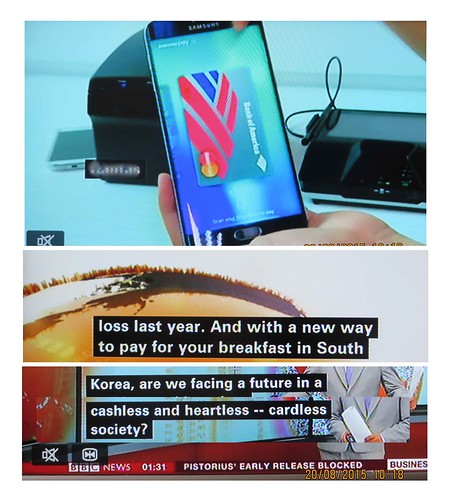
The company’s press release declared the campaign “the latest step of Visa UK’s long-term strategy to make cash ‘peculiar’ by 2020.”
There you have it. An orchestrated strategy to make us feel weird about cash. Propaganda is a key weapon of war, and all sides present themselves as liberators. Visa comes across like a paternalistic commander when assuring us that we – like a baby taking first steps – will feel a sense of achievement at liberating ourselves from the burden of cash dependence. Visa technology offers freedom without dependence or dangers.
Other propagandists join Visa. In 2014 Penny for London arrived, an apparently altruistic group set up by the Mayor’s Fund for London and Barclaycard, using charity as a hook to switch people to contactless cards on the London Underground. PayPal plastered cities with billboards claiming that “new money doesn’t need a wallet”, and a video proclaiming: “New money isn’t paper, it’s progress”. Astroturfing campaigns like No Cash Day are backed by American Express, highlighting such anti-cash themes as the environmental impact of banknotes. Other tactics include pointing out that criminals use cash, that it fuels the shadow economy, that it’s unsafe, and facilitates tax evasion.
These arguments have notable shortcomings. Criminals use many things we keep – like cars – and fighting crime doesn’t prioritise maintaining other social goods like civil liberties. The ‘shadow economy’ is a derogatory term used by elites to describe the economic activities of people they neither understand nor care about. As for safety, having your wallet cash stolen pales compared to having your savings obliterated in a digital account hack. And if you care about tax justice, start with the mass corporate tax avoidance facilitated by the formal banking sector.
However, the peculiar feature of this war is that only one side is fighting. Very few media champions defend cash. It is like a taken-for-granted public utility, whereas digital payment platforms are run by private companies with an incentive to flood the media with their key messages. When they fight this war, their target is our cultural belief in cash and the belief that its provision should be a public right.
The UK government does not plan to maintain that right and is siding with the payments industry. Their position is summed up by economist Kenneth Rogoff in his new book The Curse of Cash. He argues that, apart from facilitating crime and tax evasion, cash hampers central banks from setting negative interest rates. In the absence of cash, everyone must keep their money in the form of digital bank deposits. During recessions, central banks could then use the banking system to deliberately corrode people’s deposits via negative charges, ‘inspiring’ them to spend rather than hoard.
The emergent consensus among economic and political elites is that this is the direction to go in, but to manufacture consent for this requires a drip-drip erosion of public resistance. Hearts and minds must be shown that the change represents inevitable and desirable progress.
Anyone defending cash in this context will be labelled as an anti-progress, reactionary, and nostalgic Luddite. That’s why we must not defend cash. Rather, we should focus on pointing out that the Death of Cash means the Rise of Something Else. We are fighting a broader battle to maintain alternatives to the growing digital panopticon that is emerging all around us.
To understand this conflict, we must step back. A monetary transaction involves exchanging specific goods or services for tokens giving access to general goods and services from others. The pub landlord hands me a beer at night if I transfer tokens that allow him to get cigarettes from a shopkeeper in the morning.
There are two ways to implement this, though.
The first is to give the tokens a physical form. In this scenario, ‘getting rich’ means accumulating those physical things and ‘making a payment’ means handing them over to someone else. They are bearer instruments, which means nobody keeps a record of who owns them. Rather, whoever holds them owns them. This is your wallet with notes in it. This is cash.

Alternatively, you can use a ledger. Someone sets up a database with spaces allotted to different people. This is then used to keep a record of who has tokens. These tokens have no physical form but are written into existence. They are ‘data objects’ and are ‘moved around’ by editing the record. The keeper of the ledger thus maintains an account of what money is attributable to you, ‘keeping score’ of it for you. In this system, ‘getting rich’ means accumulating a high score on your account. ‘Making a payment’ involves identifying yourself to the keeper of the ledger via a communications system and requesting that they edit your account and the account of whoever you are paying.
Does this sound familiar? It is your bank account.
Old banks used actual books to maintain these account ledgers, but modern banks use digital databases housed in huge data centres. You then interact with them via your internet banking portal, your phone app, or by going into a branch. This is not a minor part of the monetary system. Over 90 per cent of the UK’s money supply exists nowhere but on bank databases.
It is upon this underlying infrastructure that payment card companies like Visa build their operations. They deal with situations in which someone with one bank account finds themselves in a shop owned by someone else with another bank account. Rather than the pub landlord giving me his bank details for a manual transfer, my card sends messages through Visa’s network to automatically arrange the editing of our respective accounts.
Many fintech – financial technology – startups specialise in finding ways to augment, gamify or streamline elements of this underlying infrastructure. Thus, I might use a mobile phone fingerprint reader to authorise changes to the bank databases. – ‘disruption’ merely involves putting slicker clothes on the same old emperor.
The use of high-speed communications systems to rearrange binary code information about who has what money might be new, but ledger money is as old as any bearer form. The Rai stones of the island of Yap were huge and largely unmovable stones that, while seeming like physical tokens, were a form of ledger money. Rather than being physically moved – like cash would – a record of who owned the stones was kept in people’s heads, stored in their communal memory. If the owners wished to ‘transfer’ a stone to another, they ‘edited the ledger’ of who possessed the tokens by merely informing the community. Why physically roll the stone if you can get everyone to remember that it has ‘moved’ to somebody else? The main reason that we struggle to recognise this as a form of cashlessness is that the ledger is invisible and informal.

Cashless society, though, is presented as futuristic progress rather than past history, a fashionable motif of futurists, entrepreneurs and innovation gurus. Nevertheless, while there are real trends in behaviour and tastes to be spotted in society, there are also trends in behaviour and taste among trend-spotters. They are paid to fixate upon change and have the incentive to hype minor shifts into ‘end of history’ deaths, births and revolutions. Innovation communities are always at risk of losing touch within an echo chamber of buzzwords, amplifying one another’s speculations into concrete future certainties. These prediction factories always produce the same two unprovable sentences: “In the future we will… ” and “In the future, we will no longer… “. Thus, in the future, we will all use digital payments. In the future, we will no longer use cash.
This is the utopia presented by the growing digital payments industry, which wishes to turn the perpetual mirage of a cashless society into a self-fulfilling prophecy. Indeed, a key trick to promoting your interests is to speak of them as obvious inevitabilities already underway. It makes others feel silly for not recognising the apparently obvious change.
To create a trend, you should also present it as something others demand. A sentence like “All over the world, people are switching to digital payments” is not there to describe what other people want. It’s there to tell you what you should want by making you feel in sync with them. Here’s fintech investor Rich Ricci invoking the spectre of millennials, with their strange moral power to define the future. They are repulsed by the revolting physicality of cash and feel all warm towards fintech gadgets. But these are not, on the whole, real people. They are a weapon in the arsenal of marketing departments to make older people feel prehistoric. We’re not pushing this. We’re just responding to what the new generation demands.
And so we get Visa’s Cashfree and Proud campaign. If people really were ashamed of cash, they wouldn’t need ads to tell them. Visa must engineer that shame to teach you that what you want is the same as what they want. And if you don’t want it, just remember that a cashless society is inevitable. Don’t get left behind.
But this system will leave many behind. It is hardwired to include only those with access to a bank account, and bank accounts are hosted by profit-seeking corporations that operate at scale. They have no time for your individual idiosyncrasies. They cannot make a profit off anyone who cannot easily be categorised and modelled on a spreadsheet.
So, good luck if you find yourself with only sporadic appearances in the official books of state, if you are a rural migrant without a recorded birthdate, identifiable parents, or an ID number. Sorry if you lack markers of stability if you are a rogue traveller without a permanent address, phone number or email. Apologies if you have no status symbols or are an informal economy hustler with no assets and low, inconsistent income. Condolences if you have no official stamps of approval from gatekeeper bodies, like university certificates or records of employment at a formal company. Goodbye if you have a poor record of engagements with recognised institutions, like a criminal record or a record of missed payments.
This is no small problem. The World Bank estimates that there are two billion adults without bank accounts, and even those who do have them still often rely upon the informal flexibility of cash for everyday transactions. These are people bearing indelible markers of being incompatible with formal institutional space. They are often too unprofitable for banks to justify the expense of setting them up with accounts. This is the shadow economy, invisible to our systems.
The shadow economy is not just ‘poor’ people. It’s potentially anybody who hasn’t internalised the correct state-corporate narrative of normality and anyone seeking a lifestyle outside of the mainstream. The future presented by self-styled innovation gurus has no scope for flexible, unpredictable or invisible people. They represent analogue backwardness. The future is a world of endless consumer choice built upon an inescapable digital uniformity of automated rules, a matrix outside which you can neither exist nor think.
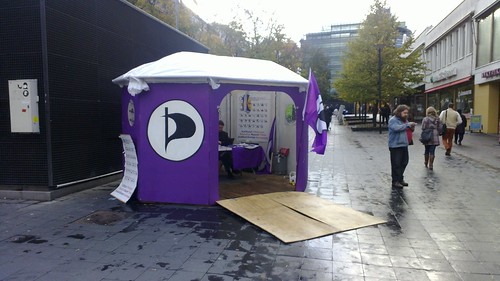
Back in Amsterdam, I hang out with Ancilla van de Leest of the Netherlands Pirate Party. She only visits establishments that accept cash, true to her political belief in individual privacy from prying eyes.
However, it would be wrong to assume that Ancilla’s primary concern involves surveillance by a Big Brother-style bogeyman. It’s true that your spending patterns reveal much about how you actually live, and the privacy implications of having these recorded in searchable database format are only starting to be uncovered. We know that targeted individual surveillance of payments occurs by the likes of the FBI and NSA, but routinised mass surveillance could become a norm. Imagine automatic flagging systems triggered by anyone engaging in a combination of transactions deemed subversive. Tax authorities are bound to be building systems to flag discrepancies between your spending patterns and your declared profits.
It’s also true that at London fintech gatherings, the exciting visions of a cashless society occasionally come with a disclaimer that we should think about the power granted to those who control the system. Not only can payment intermediaries see every time you buy access to a porn site, but they have the ability to censor your transactions, like Visa, PayPal and MasterCard attempting to choke WikiLeaksby refusing to process people’s donations. We could imagine some harsh sci-fi scenario in which a theocratic regime issues decrees to payment processors to block anyone buying books deemed sexually deviant. Such decrees could be automatically enforced via code, with subroutines remotely triggering smart locks to place the offending miscreant under house arrest while automatically deducting a fine from their account.
Such automated dystopias should ideally be avoided, so a dose of paranoia about digital payment systems is a healthy impulse, even if it might be unwarranted.
But that isn’t really the point. What’s more important to Ancilla and me is the looming sense of an external watcher that ‘assists’, ‘guides’ or ‘helps’ you in your life, tracking and logging your moves to influence you. The watcher is not a single entity. It’s a collective array being incrementally built in stages by startups and companies worldwide as we speak. We feel it seeping deeper into our lives, a mesh of connected devices, cookies and sensors. Whether we visualise it as the benevolent eyes of a parent or the menacing eyes of a tyrant doesn’t matter. The point is that the eyes have the potential to monitor you all the time.
The proclaimed Death of Cash is thus an episode in the broader drama that is the Death of Privacy, the death of the breathing room, and the death of informal, non-measured, unaccounted-for behaviour. Every action you take must forever be attached to your digital persona, dragging a data trail extending back to the day you were born. We face creating an entire generation of people who do not know what it feels like not to be monitored.
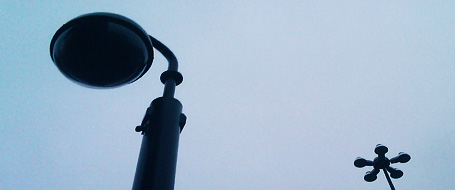
For many economists, the War on Cash will be resolved by their favourite mystical demigod, the market. This guiding force prevails when utility-maximising producers and consumers make rational choices with perfect information about their options and total freedom to choose whether or not to exercise them. If digital payment transaction costs are lower, then the cash will rightly die.
The pristine realm of market theory is unfit to assess the dynamics of this situation. Our sense of what constitutes a legitimate choice does not form in a vacuum. We are born into social power structures that tell us what normality is and shame us for not choosing ‘correctly’. You might be a rebel who challenges prevailing cultural norms, but those norms are conditioned by those with the greatest financial and media clout. At this moment, the blaring of propaganda extolling the short-term conveniences of digital payment is dulling our critical impulses to rearrange our cultural DNA. Who is thinking about the longer-term implications of building our lives around these systems and thereby locking ourselves into dependence upon them?
Unlike a battle fought using violence, hegemony is the assertion of power by getting people to believe in it, to see it as inevitable, unassailable and normal. Visa’s four-year plan is one such exercise, and once we’ve internalised it, we’ll choose to build their power. We’ll feel strangely comforted by the MasterCard billboard endorsed by the Mayor of London. We’ll find ourselves downloading ApplePay like a dazed child accepting a gift.
So, let’s prepare for the War on Cash. Remember, this is not about romanticising the £10 notes with the Queen. This is about maintaining alternatives to the stifling hygiene of the digital panopticon being constructed to serve the needs of profit-maximising, cost-minimising, customer-monitoring, control-seeking, and behaviour-predicting commercial bureaucrats. And fear not, the Germans are onside, along with the criminals, the homeless, the street-side buskers and an army of people whose lives will never get a five-star rating on a mainstream reputation scoring system. We will forge alliances with purveyors of non-bank alternative currency systems and maintain the option to use our payment cards. Because what we fight for is precisely that. The option.
When looking at the many artistic projects focused on how and why we use the internet, it’s easy to find yourself lost in a field which doesn’t show obvious, strong ties with what we normally know as “traditional art history”. This is due to historical and social reasons that emerged between the 80s, 90s and early 2000. These artists were at the vanguard of art culture and pushed at the edges of what art could be, whilst living in a post-punk and postmodernist era, and on tip of this, the arrival of the Internet in 94 changed everything. Many artists took on the challenge of what the Internet offered the world creatively, and explored it not merely as a marketing tool or a place to upload images and videos, but as a medium in its own right, inventing new technically informed, artistic tools and also building grass root led, networked art groups with new infrastructures as cultural platforms. Turning away from anything relating to the mainstream art world and what was seen as outmoded and tired traditions.
In the last decade, we’ve seen the expansion of the Internet and its use by younger generations where the medium is no longer something you exploit to change the culture, but more to integrate in traditional terms, canonical contexts.However, artist Jan Robert Leegte (born in 1973) is a very important figure to reflect upon, in order to understand this transition; while other artists of his generation were taking the internet for a non-hierarchical distributed system, he chose to explore it from a classical studies background that forged the cardinal points of his artistic research. He reflects an Internet art influenced practice which not only exists online but also in physical space. In fact, we can safely say he can be considered as one of the first Post-Internet artists. This makes him a pivotal figure in this historical segment and it’s under this light that one must visit the online exhibition On Digital Materiality (Carroll / Fletcher Onscreen, 3 August-12 September 2016). It’s a retrospective show presenting some of the most important and representative works of the Dutch artist, who wrote for the occasion an essay in which describes some of the most important aspects of his work.
Leegte says, the “materials I first used were basic HTML objects, buttons, scrollbars, frame borders, table borders, and also plain color fields and found images. I questioned what it was that rendered this practice similar to making installations rather than collages. At first it was the simulacrum of real world interactive elements (buttons, window frames, etc.). The operating system extended this haptic strategy with traditional paper-based forms, like check boxes, text fields, lists, etc, and, along with the form elements and the interactive document, led to an ecosystem of fake 3D, interactive objects.”
The work fluctuates between working on the surface and thinking in three dimensions. The same difference can be found with his use of Photoshop and HTML. If in the former case an image editing software operates directly on the final result, for the latter there is the need to know how to write code while at the same time imagine what the potential results will bring via its translation in the public space, the internet. In this sense, we do not hesitate to define Leegte as an artist who studies and uses the tools of the sculptor; he wonders how to place objects in the space, he feels the problem of contextualising a work in relation to a public and physical environment.

The perception of a substantial difference between surface and space is also proven with his interest in the basic elements of composing the digital interface (scrollbars, mouse pointers, etc). His research examines the artificial environment built by Microsoft and Apple designers. The colours and the shapes were designed to not be perceived as evident mediating agents between the user and the content – in this sense, it is interesting to note that Microsoft has often chosen a minimalist style (shades of grey, square shapes) while with Apple systems the style is usually more exuberant.
However, we should not look at the former as a less culturally relevant product. In the same way, we should not take the white cube exhibition space as a synonym of neutrality (unless we want to think that the whiteness and emptiness stay for an objectivity). This is an aspect that the artist does not seem to detect (in the text, he writes that he “preferred the aesthetics of the Windows classic interface design because of its minimalistic design – no rounded corners and ribbings like the OS 9 design, but simple beveled grey rectangles and a button object was merely a highlight and a shadow, nothing more”).
The artist reflected on how specific design elements may in some sense be preserved, as reflections and products of a particular aesthetic and cultural taste: “In Memory of New Materials Gone” (2014) is a work made by a print of the OS9 scrollbar placed in a transparent case in the same way you would do with an object no longer fashionable. This project and all the other works belonging to The Scrollbar Composition Series programmatically address the perception of virtually anonymous and transparent objects on the screen in a three-dimensional space. In a situation where their significance must be noticed; it’s the artist himself who begs to not see in this a disruptive act, an action that reveals the subtle ways in which they influence us. It is, however (but not “in opposition to”), a reflection on the artist’s activity; as we previously noted, these works are shown on the internet in the same manner in which they would be set up in a gallery space.

Perhaps, the highest point of the artist’s reflection on the differences you meet working on a surface or in three dimensions is The Photoshop Marquee Selection Series. “Random Selection in Random Image” (2012), in which a randomly generated selection marquee is shown within an image randomly obtained from the net. It is the most important work of this series because it opens three-dimensional gaps which have been created sculpturally in two-dimensional images – a dynamic that has echoes of “Scrollbar Composition” (2000), in which the Web browser’s monodimensional space is broken down and reassembled in many windows, many independent spaces sharing only the mathematical material they are made of.

The works featured in this exhibition are related to questions that go beyond the historical and cultural contingency in which they have been created. This makes many of them feel very much alive even 20 years after their creation (a novelty in digital art, I would say). This allows a healthy dialogue between different generations of artists to exist as common ground. It also engages art experts who want to be introduced to artistic issues linked to the internet. It is a dynamic that makes this exhibition a special opportunity for us all to relook at this so-called digital culture and its traditional and non-traditional art theories and its practice under a peculiar and exciting light.
On Digital Materiality – an Internet exhibition is online at Carroll / Fletcher Onscreen until 12 September 2016
Artist collective THEY ARE HERE invite you to play with and test software that allows wireless-enabled computers and mobile devices to directly form a spontaneous communication network independent of the internet.
Across a series of drop-in sessions facilitated by THEY ARE HERE, games and experiments will be trialled as part of the development process for their forthcoming exhibition at Furtherfield in October 2016.
These activities will take place online & offline around Finsbury Park.
Please bring a wi-fi enabled device to the workshop and if possible download the software Qaul.net in advance (qaul.net/software.html.)
No experience is necessary. Each session will be a discrete event, so you can attend as many or as few as you care to.
Join THEY ARE HERE at any of the following meetings at Furtherfield Commons, Finsbury Gate, Finsbury Park.
Session 1: 3pm Sunday 14th August 2016
Session 2: 3pm Sunday 28th August 2016
Session 3: 3pm Sunday 11th September 2016
Session 4: 3pm Saturday 24th September 2016
You must be aged 16 yrs +
Email contact(at)theyarehere.net for further information.
Date:NOW
Venue:HERE Links:http://www.crowdfunder.co.uk/artists-rethinking-the-blockchain?tk=208334da9b174c..
WE WANT your submissions to this landmark publication marking and augmenting the arrival of a new technology on the cultural landscape.
THE BLOCKCHAIN is widely heralded as the new internet – another dimension in the ever-faster ever-more-powerful interlocking of ideas, actions and values. [1]
It’s nothing more than a ledger distributed across a large array of machines. An apparatus that enables digital ownership and exchange without a central administering body. But from these simple premises, it has been credited with the potential to transform everything, from trade, to cultural production, to the way we’re governed.
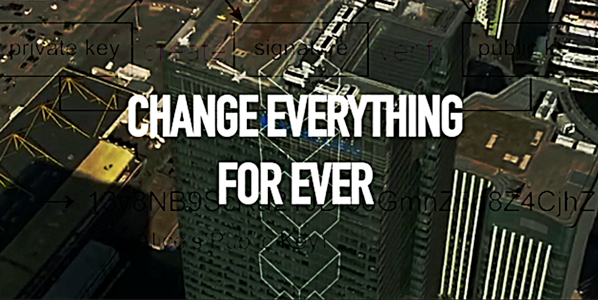
Among other things, we are suspicious of cultural production being brought under the same regime as finance.
Even as we write, this “new dawn” for transactions is being re-imagined as the next sleep-cycle taking us deeper into the neoliberal dream of complete financialisation. In this dream, Finance and Technology quicken their demented mining of value tokens from phenomena, while the grammars of culture, family, nature, politics and spacetime itself evaporate into a flurry of question and exclamation marks in their wake.
“It’s going to change everything!” (The Guardian)
The permanence and irrevocable automation of blockchain systems wedded to the irrationality and sweep of techno-financial hybrids has led to forecasts ranging from ‘fully automated luxury communism’, to our ultimate cryptological enslavement to machines, or the collapse of time itself, as the feature of algorithms to make-happen overtakes the temporal concerns of flesh and earth.
Artists Re:thinking The Blockchain
This book is not a site for a ludic cynicism or uncritical valorisation, though it celebrates the energies of these excessive forms of thinking. We welcome the potentials for ever more nuanced democratic apparatus, and the decentralization of power from state-corporation cabals, while rejecting the notion that any single technology would automatically enact these ideological transformations. We seek also to register and amplify the leakages, weirdness and side-effects that this new technology inaugurates.
Imagined as a future-artefact of a time before the blockchain changed the world, and a protocol by which a community of thinkers can transform what that future might be, Artists Re:Thinking The Blockchain acts as a gathering and focusing of contemporary ideas surrounding this still largely mythical technology.
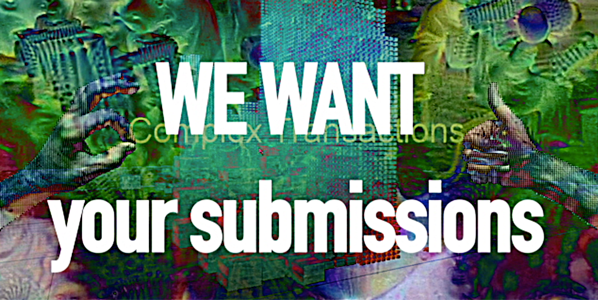
The book will include examples and discussions of current artistic projects making use of and illustrating the potentials of the blockchain, theorisation from some of the leading figures in the global blockchain conversation, and practical discussions which artists can use to guide their first steps towards this new technology.
We welcome submissions of
· book-based artworks which reflect on blockchain themes
· science fictions and theorisations, particularly in their hybrid form
· proposals for documentation of online and irl artworks
· poems, particularly based on the ‘new book’ and formal constraint txtblock [2]
The publication is a collaboration between Torque and Furtherfield, connecting Furtherfield’s Art Data Money project with Torque’s experimental publishing programme.
Alongside an illustrated print edition, the project includes a range of public-participation and debating sessions in towns and cities up and down the UK, and the first-ever book launch taking place on the blockchain itself.
DEADLINE FOR PROPOSALS 15th August
– up to 500-word abstract, description or sample of your proposed submission
– a short bio
– website link (optional)
mail to: mail@torquetorque.net
DEADLINE FOR FINAL SUBMISSIONS will be 1st October
torquetorque.net || furtherfield.org
https://www.facebook.com/torquebooks
#artblockbook
Contact: mail@torquetorque.net
Featured image: ToolsForAction.net / Artúr van Balen and QueerSport.info / Zeljko Blace, ‘POP-UP RAINBOW’, 2014
Zeljko Blace is working in(-between) contemporary culture, media technologies and sport, cross-pollinating queer, media and social activism. He is one of the initiators and a co-curator of the project ‘contesting/contexting SPORT 2016.’
to reclaim the field with art and activism
exhibition and program in Berlin (08.07-28.08.2016)
at nGBK and KunstraumKreuzberg/Bethanien
http://ccSPORT.nGbK.de
www.facebook.com/cc.sport.2016/
www.twitter.com/CcSPORT2016
The exhibition and program contests the field of SPORT through critical art and activist practices. Coming from feminist and queer practices, the project aims to challenge discrimination and encourage emancipation. SPORT is contextualized from its declarative neutrality and autonomy, rendering diverse influences, but also experiences and conditions of SPORT realities visible.
Organized by the ccSPORT international working group of the nGbK including also: Caitlin D. Fisher, Carmen Grimm, Mikel Aristegui, Sarah Bornhost, Stuart Meyers, Imtiaz Ashraf, Andreea Carnu, with support from: Tom Weller, Alexa Vachon, Ilaa Tietz, Tabea Huth, Barbara Gruhl, Steffy Narancic, Tristan Deschamps, Coral Short, Gegen Berlin, Schwules Museum, and advisors: Alex Brahim, Jennifer Doyle, Philippe Liotard, Jules Boykoff, Stephane Bauer and †Frank Wagner.
BOSMA: The ‘contesting/contexting SPORT 2016’ exhibition and program shows a wide range of uncommon perspectives on sports, questioning cultural systems embedded in them we hardly ever think about. Why did you make this exhibition?
BLACE: In this ‘networked’ and globalized time we paradoxically live out a multiplicity of highly fragmented realities, niched in specialized interest groups, while ‘others’ feel they can not contribute or even relate to them. It felt like this to me in my work during the late/post 90s with tactical and net media activism/art – fully disconnected from queer politics and sports organizing for which I had an increasing interest. In general the field of sport has not been part of the lives of many intellectuals, activists and creatives. Many had bad (even traumatic) experiences with sport in childhood and adolescence, feeling alienated, or simply not recognizing it as a possible field to develop work in (unlike right-wing populists in tribal fan cultures). Simply put, the sport system has been taken for granted in its current form. Hence, my first curated sport exhibition title, paraphrased ‘sport hater’ Chomsky, in ‘Another SPORT is possible?!.’ (2012, Galerija NOVA, Zagreb, Croatia). My Berlin colleagues and ccSPORT co-founders Caitlin Fisher, Tom Weller and Carmen Grimm felt the same about the separation of sport from arts, activism and academic research. Together (with the support of exhibition spaces nGbK and Kunstraum Kreuzberg/Bethanien) we made plans to instigate and support intersections, cross-pollinate practices and perspectives between these fields through an exhibition, program and media work. We strongly felt the field of sport would never become self-critical and reform, nor would it engage with a wider audience beyond a given consumerist mode, if left to the managerial mentalities and the opportunism of its leaders. We need to reclaim the field of sport together to change it.

Is this the first ever exhibition criticizing the cultural and political dimensions of sports, and if not, how does your perspective relate or differ from earlier approaches?
I can not say with complete certainty what other group exhibitions on sport critique have taken place before. There have been many on a small scale, marginal in comparison to the huge exhibitions that ‘celebrate’ sports and are used as decor and entertainment accompanying sport spectacles (a notable exception is the seminal work ‘Electronic Café’ by K. Galloway & S. Rabinowitz at the 1984 LA Olympics, that actually provides space for interaction/discussion in between different city locations). There were also a few archival exhibitions looking at historical artifacts and documentation critically, as well as some that were experimental and playful (such as the Fluxus Olympiad, scripted as non-competitive multi-sports event) but these approaches were somewhat one-sided. We aspire to create a basis for both critical reflection and informed envisioning of possible developments, by looking at personal perspectives and artistic visions, next to grass-root alternatives and interventions.

The main threads in the exhibition seem to be gender, queerness and the connection between culture, commerce and rules in sport. Are these the main issues at hand?
Indeed our starting points were feminist and queer positions, but we were also very interested in the wider range of intersections and systemic issues within the field of sport that we could connect, rather than focusing on single-issues like homophobia or racism as is often done in mainstream sport campaigns. We decided very early on that the project would not be about identity politics, but rather about the multiplicities of axes of discrimination. There is a spectrum of emancipation efforts and practices that inspire us to think outside of gender norms, result-focused competitions, spectacle creating events and omnipresent ‘development’ narratives – which ignore for example that women had more access to certain sports historically in different geographies then they did in past 30 years of globalized neoliberalism.
augmented_profile from Diego Grandry on Vimeo..
How do you see the role of the media in the perception of sport?
Traditional broadcast media are the key stakeholder in the Olympics and similar sporting-spectacles. They have made the organizers of large sport events addicted to their huge broadcast contract revenues, but then inherently push for the spectacle of mega-events even further at the cost of other aspects. Newer sports that have evolved around this economy of attention have often sexed athletes (most visible with female beach volleyball) or at least contributed to enforcing gender stereotyping (like the feminization of soccer/football to the point that there are almost no short haired players at the Olympics). Instead of actively evolving with the progressive trends in sport, most broadcasters deepen the stereotypes; too often commenting on the marital status and appearance of female athletes, or referring to them as girls. Athletes from smaller countries, and sports that receive the least coverage are often looked down on, projecting neo-colonial relations on them (or hosts as in Brazil).
With internet networks and ‘social’ media the situation it is more complex as the interactive nature of media often allows for feedback and multiple standpoints in the same, or various foras. These media diversity brings to the surface and exposes critical minority voices and individuals who are able to argue against norms and question their necessities. For example, the tokenizing of muslim female athletes during these last Olympics received great reactions including historical facts about muslim women winning medals in the ‘80s and ‘90s. Also the outing of gay athletes by one reporter, was widely criticized online and the media hype reboot around Caster Semenya was compensated by internet and hybrid media (i.e. AJ+) publishing numerous expert articles and even giving voice to many (including former opponents critics converted to supporters as in case of Australian runner Madeleine Pape).
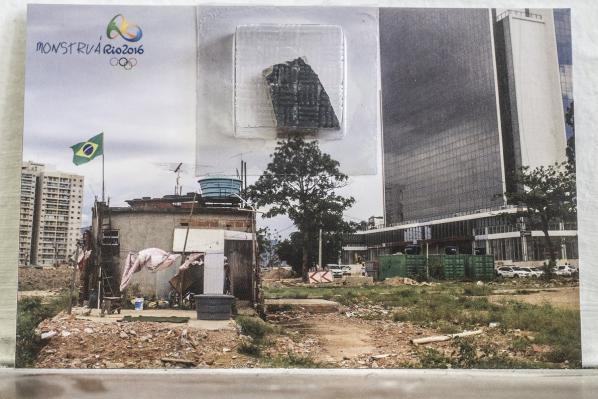
The connection between rules and cultural systems in sports is fascinating to me. You have worked as an organizer/curator in Multimedia Institute/MaMa before focusing on sport. What is your perspective on the rise of technological systems in the enforcement of rules, like for example drug testing or electronic goal-line and court line tracking?
Actually, the technological aspects of sport are the ones that still need to be addressed more specifically (technology centered single sport competitions exist since years, with The Cybathlon as their olympics premiere in Zurich, October 8th 2016). They not only re-enforce certain types of (measurable) norms, but also reduce the complexity into what appears to be arguable ‘logic’ and ‘common sense,’ while hiding other aspects (psychological and even aesthetic). Drug testing is an important measure of control, but is usually focused on the supra-performance of medal-winning athletes, rather than concerning itself with more generally applicable questions: what are the drugs, who has access to them and why. As long as the prevalent ‘production’ of results at all costs is dominating sports, the goal of ‘clean’ sports regardless of technological advancements in control will remain impossible. Gender policing at the Olympics has had a lengthy technological path, starting with visual and medical inspections, moving on to DNA and hormone testing and nowadays being fully questioned. Measuring and tracking technologies have the most interesting potential, not only for confirming line calls but for reshaping sports into allowing potentialities of variable norms and measuring based on generative fields/infrastructures. However, this kind of innovation is more likely to develop in the edges of eSports industry (that is pushed by novelty rather than burdened by traditions and conventions) and then maybe get normalized into traditional sport competitions once existing sport federations and regulatory bodies start losing young markets.

It was important for us to initiate conversations and collaborations that were not in place before, especially between those excluded from the mainstream sport system. We stirred up some interest from academic researchers for immediate follow-ups, but also informed some activists and artists of each other’s work. Ideally this could be developed further to elevate the critical and creative work in the field of sport and address issues in multifaceted ways.
We hope the exhibition and program enabled visitors to develop a more articulate position rather than just LOVING / HATING SPORTS, maybe supporting our platform — and ideally also inspired them to build personal or collective proactive relationships to sports. Maybe through practices of engagement against mega-spectacles and hyper-commercialization of sports, while supporting/partaking in grass-root sports or reforming the mainstream system.

Now we look forward to have the time for reflection after the intense work of materializing the exhibition and the extensive events program, as well as to see what future sport events could be interesting to contest and/or contextualize. One of the most important follow-ups is establishing an online space for sustainable communication, exchange and sharing information, know-how, methods, most likely using wikis, maps and media that came out of our research and workshops during the summer exhibition program.
This will be ncluding video of closing lecture by prof. Jennifer Doyle on art, sports and questioning the origins and need for the gender segregation in sports! More info will be appearing on our working website http://www.ccSPORT.link/
What is the relationship between state corruption and economic collapse in Greece?
Lina Theodorou, artist and creator of the board game ‘Pawnshop- Days of Mistrust’, talks with Furtherfield’s Ruth Catlow about Grexit, Brexit and crisis in Europe.
I met Lina Theodorou, the artist and creator of Pawnshop, in her apartment on a sunny Sunday morning in Berlin. It was just one week after the UK referendum resulted in a vote to leave the EU. I was in Berlin to take part in an event called Art, Money & Self Organization in Digital Capitalism, the first in a series of events called Arts and Commons, organised by Supermarkt.
Theodorou and I quickly got onto the topic of Brexit. We compared notes. She wondered if, like Greece, the UK government would choose to ignore the result of the referendum, fail to invoke Article 50, and stay in Europe after all. That possibility had not occurred to me. She talked about her memories surrounding the Grexit debate- the distress, the uncertainty, the shocking hatred and hostility expressed between family members and people previously considered friends. I had been deeply shaken by the upsurge of street-level racism on the streets of Britain.
Pawnshop, the artwork that is also a board game, was set up for play, laid out on a table in her studio. It is an inversion of Monopoly: the same square board, the pieces, the bank, the cards, the dice. However in this game the player starts the game with no money, only property – jewelery, a bouzouki, antique furniture, a flat- and pays a European tax of €1500 when they pass Go (if they get that far).

Players proceed around the board, according to the luck of the dice, along a path strewn with dilemmas. A second row of squares is used to keep track of the time spent dealing with the consequences of their choices- jail sentences, or hospitalizations for example. As they move around the board, they pick one of the cards, depending on their landing square, and must choose how they will respond to the given dilemmas.
Theodorou tells me that the game is based entirely in fact. For years she has collected newspaper stories in Greece. And here they are gathered in four categories of cards – Dilemma, Involvement, Debt and Luck- to encapsulate the experience of daily life, for everyone, in modern day Greece. ”If you are honest you lose” she says.
On her website are photos of engrossed players at Bozar, Center for fine arts, Brussels; at the exhibition TWISTING C(R)ASH; at Bâtiment d’Art Contemporain « Le Commun » in Geneva; and at the exhibition It’s Money Jim, but not as we know it, at Mario Mauroner Contemporary Art Vienna, and As Rights Go By, Museumsquartier, Vienna. She says it’s important that at the beginning players laugh… but because of ”synesthesia”, the longer they play, the more uncomfortable they become, they feel the ethical discomfort in their bodies.
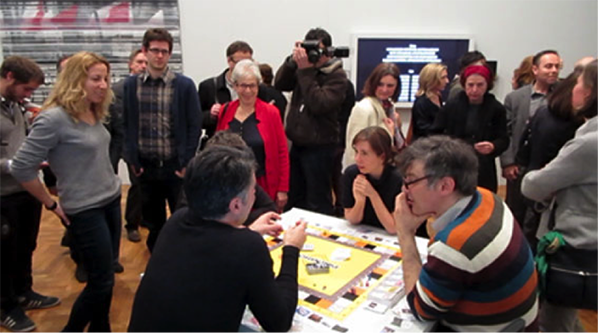
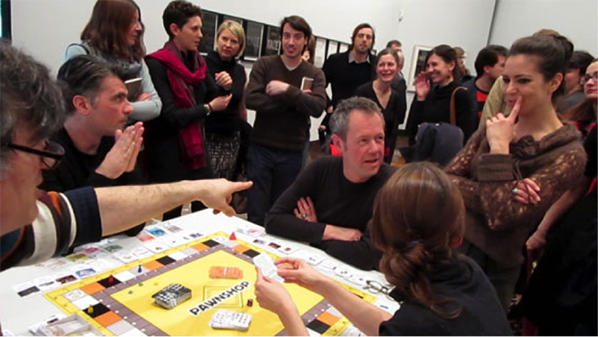
Theodorou and I digress again, coming back to the Europe question. Because I’m in Berlin I think about Germany’s role. Germany at the heart of Europe is perhaps more part of the problem than they realise. The style of bureaucracy is molded to reflect the German mentality and their industrial system.This is coupled with a confidence in the correctness of the system – that Theodorou points out, is accompanied by the Northern European, Calvinist attitude – anyone who does not comply is wrong and must be punished. “But what is good for Germany is not necessarily what is good for Greece” she says. In Greece for many years the economy was made up of many small entrepreneurs, small businesses, shops, and a community focus” Why must we suddenly give this up in favour of big business. “Why do you have to destroy something that is healthy?”After the banking crisis in 2008 pawnshops started popping up on every street in every town in Greece.
Theodorou tells me that Pawnshop is the Greek reality board game.
“Your father is sick, do you pay his hospital bill?
Yes: pay €3000 and he lives for another 6 years,
No: unfortunately he dies, but you receive a life insurance pay out of €75,000”
Picking an ‘Involvement’ card means that that player’s decision will have consequences for other people too; Debt (is the biggest pile of cards).
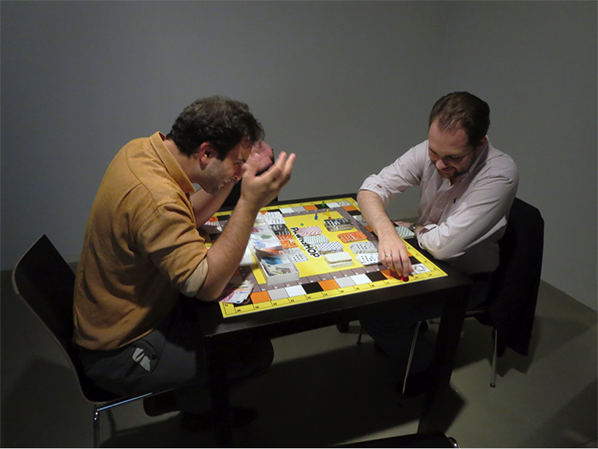
Gentrification strategies have failed in Athens. Back in 2006 the rich Greeks, many of whom were also art collectors, started to organise the large scale art events, (in which of course the artists worked for free), but it didn’t take. Then in 2008 the banks collapsed, the economy became surreal, but somehow, Athens remained the same. Perhaps this because regeneration does not have the ever-rising bubble of property prices to support its economy. In Greece everyday people do not speculate on the housing market (as we do in the UK). Rather a house is something you keep for ever in the family.
Theodorou describes the real world Greek tax system as “insane”. It changes every 3 months, Even the accountants have difficulty keeping up with the laws. This alone forces many people into the black market. Then the web of bureaucracy protects the hierarchical status quo and people in higher positions hold onto their power by putting obstacles in the way of others.
The only way to win this game (on the board and IRL in Greece) is with good luck. Good luck is the only way to avoid ethical discomfort or financial ruin.
The Luck cards (also based on fact as reported by the newspapers) are hilarious. “A politician hits you with her car, but fortunately the accident is witnessed by the media – collect €2500”.
“Some rich ladies wish you a Merry Christmas and hand you €100”.
Apparently Athens newspapers have reported tales, for the last few years, in which “ladies” have distributed money to “the poor” from black windowed limousines.

Pawnshop is a polemic on corruption. Small corruption. Long standing, Greek-style, everyday corruption from which no-one can escape. The universal, forced collusion in corruption, and its corrupting effect on the spirit of Greek citizens and society, is set out in the game mechanics. The playful and social medium of the game means that the impact of contemporary Neoliberal politics on the Greek ‘everyman’ is made legible, feelable and discussable: unending, ethical traps; the impossibility of old-style moral political clarity; the flushing of righteous action, solidarity, resistance or even survival. Corruption all the way up and down.
I question Theodorou carefully, because I have long been suspicious of the narrative that says that corruption is the cause of Greece’s economic problems. But the corruption is a fact. While it is not necessarily the only or even the primary cause of its economic distress – which is very very real- the lack of trust in the state is debilitating and has a stagnating effect on the economy.
Pawnshop sits in an honourable tradition of artist’s activist games: to change mindsets and attitudes by actively implicating players in a reconstruction of values – see Mary Flanagan persuasive research about crticial play and the many attitude-hacking games coming out of her lab Titlfactor. Also Brenda Romero’s chilling Train game, Yoko Ono’s Play it by Trust. And for games that train for resistance and solidarity in games such as Escape from Woomera, Debord’s Game of War, and my own pacifist chess hack, Three Player Chess.

A look around Theodorous portfolios of works reveals a long practice that crosses agitprop, video, installations, and networked pieces.
The work all builds on close observations of contemporary political and social systems. Through graphical exuberance and humour these observations are rendered just (barely) bearable so that we are able to spend time with complex, difficult situations and suspend our certainties. And this is necessary and important. We need to face the complexities and ethical contradictions of contemporary politics. There’s no time to lose.
Before the referendum, I found myself uneasy about actually campaigning for “Remain” in spite of my desire for a pan-European peoples’ alliance. This was because I couldn’t ally myself with the dominating political arguments proposed by the Conservative party (and backed up by big-business and the establishment). I also didn’t want to participate in a binary campaign that stamped on the dignity of the layer of people in the UK who are already so disenfranchised by the effects of austerity cuts (and many years of other systemic injustices). This moment revealed for me, and for many others in the ‘social liberal’ layer, a chasm between my own values and experience and those who voted to ‘Leave’. And a desire to find a way to connect. PostBrexit the reality board game may be just the thing we need to help us come together and play our way through the effects, consequences and possibilities.
Furtherfield in partnership with the antiuniversity and Radical Think Tank are proud to present this new 6-part course.
Aimed at people with an interest in radical social change, the course will apply concepts from complex systems theory to understanding (and creating) revolutions and social movements.
The course is directed at a general rather than academic audience, although a desire for radical social change will be assumed.
6.30 – 8.30pm at Furtherfield Commons, inside the park near Finsbury Gate
Booking essential – Please book here
Tue 27 Sept – Introduction to Complex Systems
Tue 4 Oct – Smash the System – Creating and Harnessing chaos
Tue 11 Oct – Erode the System – Building the New World in the Shell of the Old
Tue 18 Oct – Escape the System – Bodily Affect and Surviving Oppression
Tue 25 Oct – Tame the System – Reforms without Reformism
Tue 1 Nov – Bringing it All Together – A Trajectory for Revolution
Sessions will involves a mix of speaker presentation and participatory discussions/activities, covering subjects such as ecology, network theory and new materialist philosophy.
Other familiar concepts will be re-examined through this framework, including the commons, chaos, structural oppression and reform.
The ultimate goal is for this knowledge to be put into practice to create more effective activism, to contribute to better understanding the workings of contemporary society and to help inspire projects for building future utopian alternatives.
Graham Jones is an activist based in East London, working with groups such as Radical Assembly, Radical Housing Network and Radical Think Tank.
For those unwaged or on low income the course is free (or donate what you can). Choose either the Free Ticket or Donation ticket in the links above.
For everyone else, individual sessions are £5 + booking fee. A prebooking of all 6 sessions is available for £25 + booking fee.
During my visit to Ars Electronica I was humoured by the excessive amount of ‘hello world’ creativity that is often produced when science and technology meet and exhibit interactive spectacles that make very little claim other than an enchanting proof of concept. What I thought would be an interesting media festival turned out to be a robotics road show. This tech road show attracts over 90,000 people from Europe and Asia to wonder at the latest innovations in robotics, VR, bio-hacking, 3d printing, drones and anything that glossed the pages of Wired magazine as the next big thing.
The alchemists of our time, or as I like to call them ‘Dumb wizards’, are continuing to design and exhibit technological achievements in self-fulfilling speculative words that have very little concern, consideration or critique with any relevant social issues of our time. Excluding the CyberArts exhibition (curated by Genoveva Rückert), which I thought was a top selection of some of the best media art works of the last years, Ars Electronica is predominantly occupied by interactive spectacles that neglect to examine the social & political impact of technology.
To overlook how smart phones, big data and network computing are changing privacy & security, or how cloud based services are transforming the labour market or how Silicon valley start up culture has convinced a sizeable amount of the population that for every problem, there is an app based solution. In the bazaar of innovative design and interactive art I struggled to identify any work (be it art, product, or concept/agency) that voiced or articulated concern or criticism with technology, politics or social change. The most provocative aspects would be the whimsical one liner that is planted to introduce some speculative design projects, showcasing some daft prototype with a splash page and a quote in large font to grab the attention of the viewer.
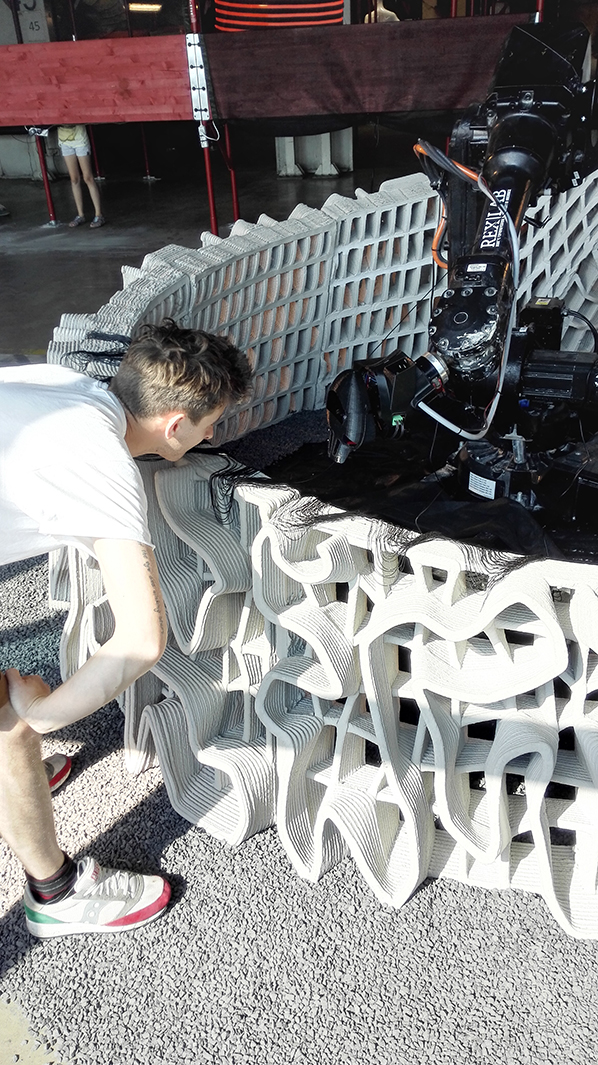
What is the gold of our time?
How do we build a social relationship with others?
Innovation: Where do we go from here?
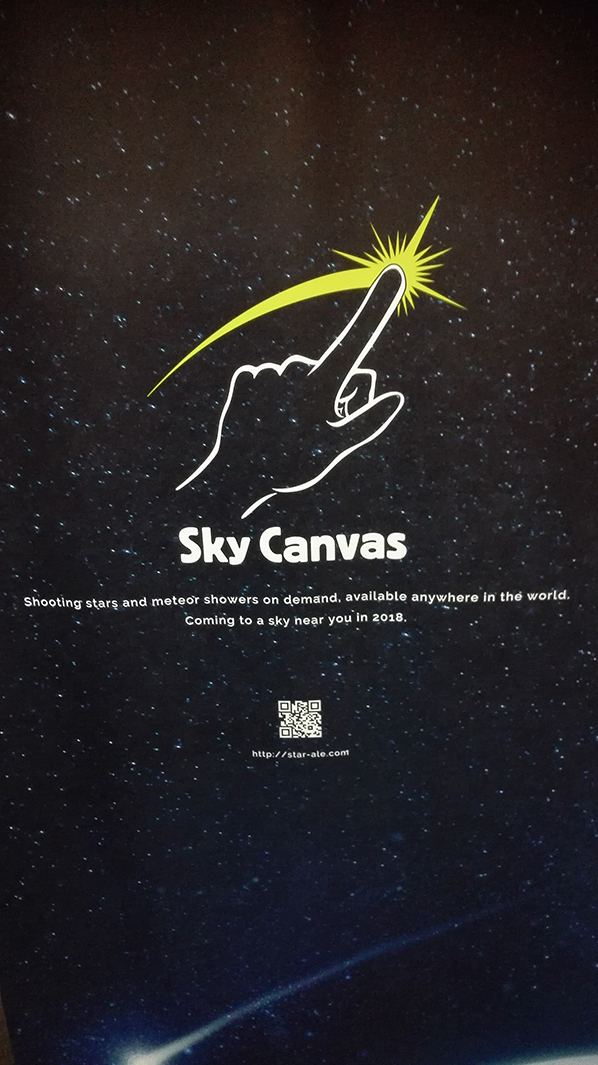
My favourite example of this was the disastrous ‘sky canvas: Shooting Stars. On demand’, an initiative to re-create the magic of a shooting star with satellite technology and glowing bits of plastic that can be shot into the night sky at the tap of a mobile app. The Alchemists of our time have fixed the magic of shooting stars. Great, thanks.
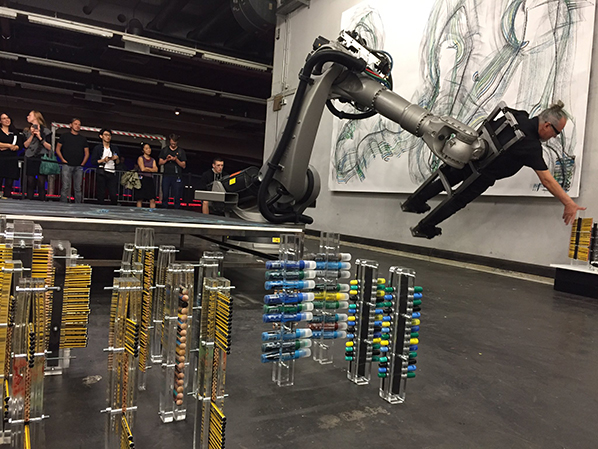
Much of the programme was better suited as light-hearted evening entertainment, drone racing, robot cooking, and endless drawing automaton. This robot, which I called ‘Human Pencil’ would throw around its inventor while he held 20 pencils and tried to make a drawing. Simultaneously inventive, pointless and entertaining; these robotic meme installations are better suited to robot fail video compilations on YouTube than to an art exhibition. The rejection of a critical consideration or a socio-political framing of the role of technology leads to what I call ‘enchantment art’, where the same devices used to execute mass killings in war zones become family friendly evenings entertainment.
Congratulations Dragan Ilić & team. Next performance at 10pm #Arselectronica16 #Artandscience @ArsElectronica pic.twitter.com/HgYXEctsYN
— GV Art (@GV_Art) September 8, 2016
So how has Ars Electronica, one of the longest standing and biggest media arts festivals in the world, found itself so far distanced from the political concerns surrounding technology? The first reason perhaps is that science does not bode well with critical theory. Many of the projects at Ars Electronica (again, excluding the CyberArts exhibition) feel like science museum artefacts that simply demonstrate technical (in)capability.
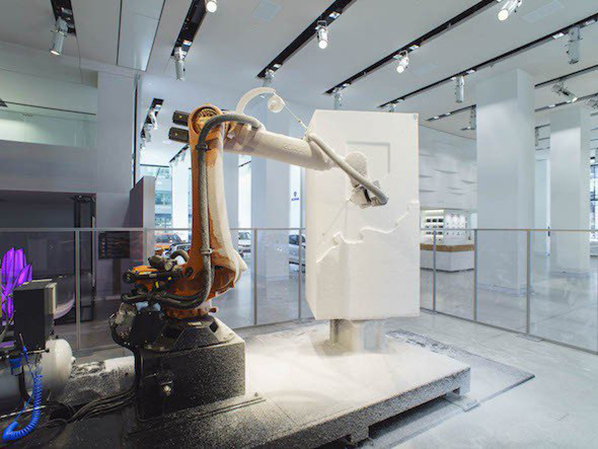
This attitude can be personified by the man I saw wearing a t-shirt stating “SCIENCE – It works, bitches”. Take for example this robotic arm reprinting Michelangelo sculptures which can only underline the immense technical potential of technology. Another possible reason perhaps that many of the works at Ars lacked social awareness is because they are produced by scientists & programmers in isolated laboratories. In this working methodology the viewer is rarely considered apart from in user tests, case studies and de-bugging. I found many maker lab types standing next to their large laser cutters avoiding eye contact while they printed out modular components and hoped for the next entrepreneur to walk past and slam down an investment fund. The lack of social awareness and engagement of issues surrounding our time have begun to impinge on the festival itself and an awareness campaign called #kissmyars is voicing concerns over the lack of female representation at the festival, particularly in the prix art prize which is awarded to men 9/10 times. The gender diversity in technology sector should no longer be ignored; this is one example of a socio-political issue not only overlooked at the festival program but also exacerbated by the organisation itself. I hope that the #KissMyArs campaign will not only rebalance the gender inequality at the event but also encourage the organisers to address other alarming realisations that operate within and around the application of technology in the social, political and economic sphere. Perhaps the Alchemists of our time should stop staring into the night sky planning the next life saving app and begin addressing the issues that applications can’t fix.
#KissMyArs
Leila Johnston was Rambert Dance company’s first ‘digital creative in residence’ from October 2015 – February 2016, having successfully applied to their residency programme, Sprint. The programme aims to enable Rambert to engage more deeply with the digital world, and is framed as experimental and light touch, with no expectations or goals in mind. One of the outputs of Leila’s residency – and the subject of this review – was a report ‘Hacking Rambert’, an incisive account of Leila’s time on Sprint, as well as a reflection on the nature of the creative residencies, dance and technology cultures.
Leila describes herself as an outspoken critic of current technology culture, resistant to its tendency for ‘digital evangelism’. The report belies her frustrations with technology culture – and indeed is a call to arms for rethinking what that culture needs to become. Her approach to the residency reflects this, emphasizing that its value came from bringing her critical perspectives about tech culture to bear, as much as from introducing dancers to ‘tools’ (though this played an important role too). She stresses how opportunities for growth and learning arose ‘through people (and sometimes tech)’ (my italics), and places human interaction and collaboration at the forefront, alongside, if not over and above, hardware and software. Dance is, she says, ‘about extraordinary relationships on every level – with yourself and then the little halo of space around you at all times, and then with greater and greater halos until it’s with everyone you meet.’ People are at the centre of her thinking and writing, and her residency was underpinned by questions such as ‘Is there a way to use technology to do justice to the human lifetimes that go into dance? Is there a way to dignify individuals, to invite confrontations with real people, to respect something other than the movement and acknowledge the part that individual experience plays in the construction of dance?’
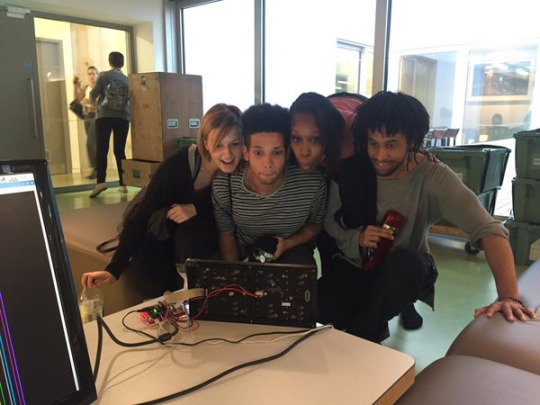
Reflections on the cultures of the dance and technology worlds are also central to the report. Leila was struck by the relative openness and accountability of the dance world, which she saw as ‘a home that opens its doors to anyone that knocks’, in contrast to self-aggrandizing, solution-focused, often misogynistic digital world that is so well equipped to sell itself and its benefits. One of the observations that fascinated me most was about the different approaches to labour in the dance and digital worlds. For the former, hard work is a celebrated and central driver – dancers are ‘efficient’ because no work is seen as wasted. By contrast, the digital world wants to recover ‘free time’ by getting the hard stuff out of the way. While tech wants to make things easier – dance wants to make them harder – so that difficulties and limitation can be mastered and overcome.
The dominant tech world rhetoric that technology – coding especially – is ‘for everyone’ is thrown into relief by its absence in the dance world, where no one would expect ‘everyone’ to be a brilliant dancer, since this is something that requires a lifetime of grit and dedication as well as the right body and innate talent. Leila shows us that we can learn from the dancers’ dedication and commitment that ‘not everyone can do anything, and that there are pursuits that arise from the nuanced world of individual lifetimes and personal, emotional, motivation, the results of which don’t resolve into a formula’.
Although her emphasis was on criticality and personal relations, she drew on an impressive range of kit. She experimented with a thermal camera attached to her iPhone, which enabled her to explore a ‘dance of heat’. She observed that ‘the idea that dancers can be expressed as their invisible heat is strange, but absolutely real’.
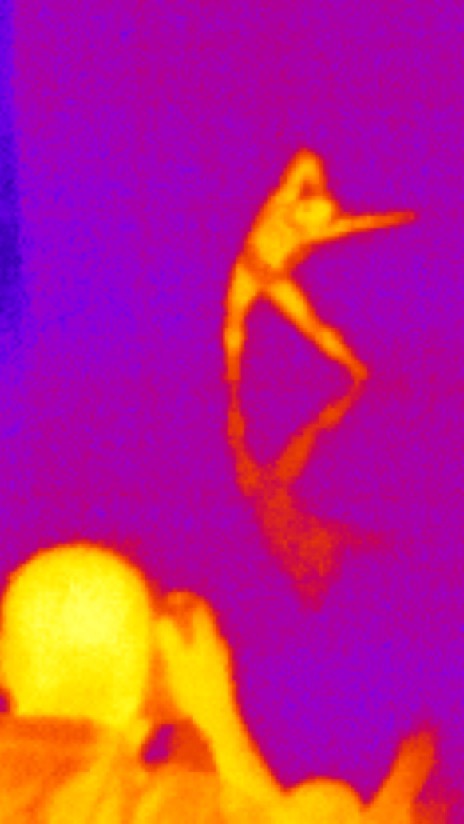
The Point Cloud demo on the Kinect was of great interest to the dancers, for whom it allowed a new kind of 360-degree vision, useful since they are ‘always looking for their own back’. Leila experimented with a Raspberry Pi, using it for a range of experiments including connecting LED panels where she could display words and video. Again though, as well as the tool itself, the Pi gave rise to critical reflection: ‘Why aren’t we teaching dancers and choreographers creative technology skills for their work, rather than reinforcing a hierarchy of expertise by ‘advising’ them on creative direction?’ Emphasizing how accessible and readily available Pis, LED panels and other technologies now are, Leila makes the point that maker culture can be embedded in the dance world at little cost, but this won’t happen organically unless more awareness of each other’s culture is fostered.
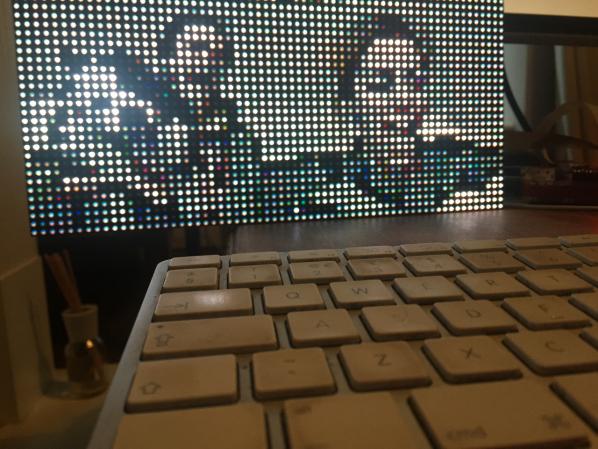
Drawing from the residency blog hackingrambert.tumblr.com, Leila reflects on time, truth, and difficulty. She is resolute that time, patience and commitment are needed to make meaningful artistic contributions, and that artists undertaking short term residencies need to be realistic about what can be achieved. Rather than gunning for a finished product, ‘short projects should be about making – what it means to be a creative, and what we learned about the best way to do things in the context of the artificially short creation time.’ Unlike the tech world, quick fix and solutionism will not fare well on a creative residency.
Leila’s reflections on the notion of truth are intriguing; she feels that there is ‘nowhere to hide’ in dance, and draws a parallel between dancers’ bodies and the ‘technical authenticity’ of circuit boards and wires. These forms of hardware offer respite from the slick interfaces that are so characteristic of digital technologies. She notes: ‘I’m interested in the relationship between truth and performance; the unique way in which (dance) performances are honest, how our bodies give away the truth, how things represent what they are very transparently’. These explorations of truth provoke rich questions about authenticity, identity, ‘fidelity’ and representation. The notion of the stripped back body is a striking one, and when one observes a dancer in motion, with their muscles, sinews, bones, sweat, and humanity on display, there can be a powerful connection between the dancer and the audience. However, there is artifice at work in dance too – creating illusions with the body, emphasizing certain lines, creating the appearance of fluidity and ease when the body is being pushed to its physical limits. Can we draw an analogy here to the performance of identity online, where the blood, sweat, tears and humanity are often glossed over with ‘choreographed’ images that appear spontaneous and perfect? Or is the truth of dance and bodies precisely an antidote to this phenomenon? My caution here would be that dancers have identities as well as bodies, and are not immune to the pressures placed on them about their appearance and representation.
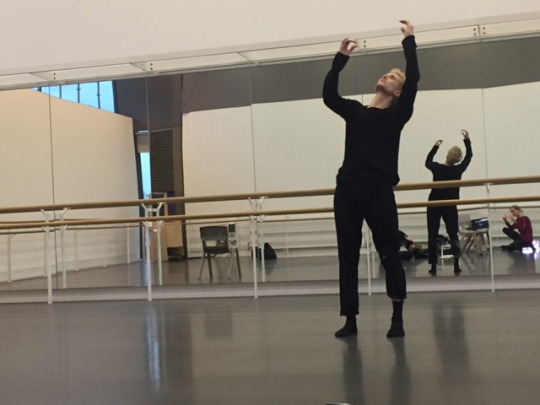
Leila argues that the creative tech community needs to work harder to understand dance, but that dance too ‘has much to gain by creatively educating itself in the available tech options’. Introducing dancers and the dance world to creative technologies can be fruitful, but should not be understood in solutionist terms. Technologists must take responsibility for the enormous power they have in society – it is up to them to ‘educate and differentiate’ between the potentially homogenous mass that is ‘technology. Finally, she makes a case for ‘contemporary creative technology’. The notion of the contemporary connotes the historical nature of a given art form and the contingencies of its evolution – conceptually, technically, physically, socio-politically. The relative nascence of technology, she suggests, leaves it unanchored, and subject to the intentions of ‘commercial forces’. She states ‘A contemporary creative technology could lay down the microphone of narrative and exist in the depths of the present. We could stop writing our own story in the cultural canon – indeed stop telling stories about what we’re doing at all – and focus on being demonstrable and accountable.’
There are moments when Leila seems to idealize the dance world as relatively problem-free, without acknowledging its potential problems – not least the subjection of bodies to punishing regimes and the mental and physical problems this can give rise to, and issues of social inequality, accessibility and exclusivity that come with all creative industries. However, there is clearly a lot the technology world can learn from the culture of dance. Perhaps the tech sector should start having dancers in residence…